Text
Salvador, Brazil
The day I left Brasilia for Salvador marked five weeks in Brazil (and fourteen of the past seventeen spent on the road). I was losing steam. Constantly packing and unpacking, always being a guest in someone else’s apartment, being alone nearly all the time, stifled by high temperatures and humidity and, I think more than anything else, not being able to speak the language were all taking a toll. I wanted to make the most of my time in Salvador, which everyone told me is a special place I would love, but I also started counting the days until I would be home.
In fact I was lucky to make it out of Brasilia at all. Months earlier I booked a flight on the budget airline Avianca. A few weeks before the flight they emailed me about a change, but the email only showed a different flight number. When I checked on the flight a few days ahead of time, I discovered my original flight had been canceled, and I had been rebooked on to an itinerary with a layover. At least it only added an hour of travel time, and I may have been lucky. It turns out Avianca was teetering on bankruptcy and had canceled 2,000 flights in the last two weeks of April since they were unable to pay the leases on their planes and airport slots. That might explain why on the first leg of my flight we were served only water and muffins and on the second leg the flight attendants didn’t even come through the aisle (tho it was only 45 minutes). They seemed pretty unhappy in general.
My Uber ride to the city was a bit surreal. When I planned this trip I forgot about Holy Week, and I arrived on Good Friday, a national holiday. I thought that Easter in a Catholic country might include some unusual parades or festivals, but it turns out most people go home to their families that weekend. So as I drove through the city in the middle of a Friday afternoon it was eerily quiet and deserted. I was already nervous since many people had warned me to be careful since crime was rife (even more so than everywhere else in Brazil). And I knew the area I was staying in, Centro, could be dicey, especially at night, but it sounds like everywhere in Salvador is dicey so there weren’t any great options. In any event, the crumbling buildings, stray dogs, abundant trash, closed shops and streets mostly devoid of people (except some layabouts) all added to my sense of unease.
I was staying on a public square, Largo Dois de Julho, which hosts a number of businesses, so that felt reassuring. Most were closed but I did find a couple open restaurants. I was scared of venturing further, and I didn’t want to take an Uber to a restaurant only to discover it was closed for the holiday, so I stayed close to home my first Friday night. Fortunately just two blocks away was Bar Ancora do Marujo, a truly tragic drag show dive. Bizarrely the show started with “Bye Bye Birdie”, and I must have been the only person to recognize it in the mostly young, entirely Brazilian crowd. I appreciated the obscurity but the show did not improve. I spent most of the night chatting with a friendly guy and his drunken friend who talked a lot of shit (especially about Argentinians).
On Saturday it felt like some life had been restored to the city. I was tired from lack of sleep, humid heat and homesicknesses, but was determined to press on. I headed south on (I think) the city’s main thoroughfare, Sete de Septembre. Centro soon passed into Vittoria, a much nicer (i.e. wealthier) neighborhood with lovely tree-canopied streets. There was not much to look at besides walled-off high-rises and the occasional colonial mansion. The road eventually dipped down into Barra, the city’s most popular beach. The coastline is dotted with numerous outcroppings, and Barra is marked by three forts, one still in use, one in a state of glamorous decay and one that has been restored into the Museu Nautico da Bahia, famed for its lighthouse, the Farol da Barra. The street above the beach has been made pedestrian-only and that afternoon the whole area was full of sunbathers, vendors and on-lookers like me.
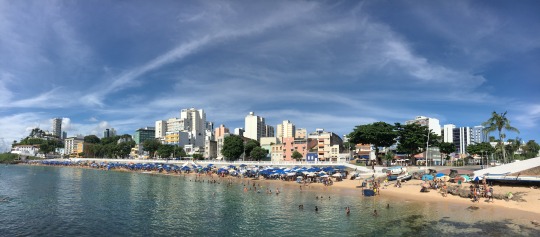

Taking in the views, I meandered my way over to the museum, a history of Bahia’s relationship to the sea, full of historical displays (presented in English too!), curious artifacts and ship models. (It also exhibits some of the remnants of a famous shipwreck that was only salvaged about fifteen years ago.) I’m not a maritime aficionado, but still found all of it interesting. I especially enjoyed the restored fortress that houses the museum and lighthouse (which you can climb to the top of) as well as the fabulous views they offer.
There is not much else to do in Barra, so I bought some beer and acaraje and sat on the beach for a while. I later repositioned myself to the bay side for sunset. Salvador sits at the mouth of the very large Todos Os Santos Bay, whose mouth opens south on to the Atlantic ocean. The city is on the east side of the mouth, which makes it the only place in Brazil where you can watch the sunset on the “ocean” (actually it’s setting over the bay and behind Ilha De Itaparica, a large island, but the effect is the same). After soaking in the beautiful sunset, I left the increasingly revelrous crowds to buy some groceries and go home for an early, restful night.

Sunday was Easter, and I did not know what to expect, except that most businesses would be closed. After a leisurely start, I walked down to the waterfront and over to the Mercado Modelo, once a Customs House that stored slaves awaiting auction, now a large marketplace full of stalls selling touristy tchotchkes. I breezed through then crossed the street to the famed Elevador Lacerda, a couple Art Deco towers holding four elevators that whisk passengers from the waterfront up the hill to the Pelourinho neighborhood, for just R$0.15 (US$0.04) a ride. I really don’t understand why this is such a big deal, even highly recommended by Lonely Planet. Yes it serves a helpful function, and the views from the lookout at the top are magnificent. But inside it’s just a metal elevator with no windows. The top of the structure juts out of the cliffside but its views are spoiled by tiny window frames and dirty glass. I’m glad the elevator was there so I didn’t have to walk, but it’s hardly an attraction in itself.

Pelourinho is Salvador’s most famous, tourist-friendly neighborhood. I was planning to spend Monday there (figuring more places would be open and fewer tourists would be about), but I figured I would get a sneak peek the day before. It’s also full of churches, so I thought I might catch some Easter celebrations but alas I did not. After a tasty lunch at Bar Zulu (my first salad in ages), I visited two of the local churches, side-by-side and competing for opulence. The first was Igreja da Ordem Terceira Secular de Sao Francisco. Bucking the national trend, the exterior is extremely ornate while the interior is (relatively) subdued. Visitors can tour the rest of the complex, which includes a creepy crypt and some deeply disturbing portrayals of Jesus suffering. Not to be outdone, next door is the Igreja e Convento de Sao Francisco, a decadent Rococo stunner covered in gilded embellishments and Portuguese tiles (tho its exterior is a fairly modest Neoclassical facade). I decided to save the rest of Pelourinho for the next day, so after snapping a few more pics in the light of the setting sun, I headed back down the hill to my apartment (before it got dark and scary).


What a difference a (working) day makes. When I looked out my window Monday morning, the city seemed to have returned to normal. My AirBnB was on Largo Dois de Julho, and it was bustling with shops and street vendors, and the streets were densely packed with shoppers and pedestrians. I made my way up the hill back to Pelourinho. It’s a very charming, pretty area of narrow cobblestone streets, scenic plazas, historic churches and small colonial-era homes, mostly restored in the last twenty years. It encompasses several paradoxes that made it hard for me to settle on my feelings toward the place.
The word Pelourinho translates as “pillory” (”a wooden framework with holes for the head and hands, in which an offender was imprisoned and exposed to public abuse” aka the stocks). And indeed slaves were often publicly punished in the area, which is nowadays postcard-perfect and full of tourists and street performers. It was the historical center of town, and its wealth was driven by the slave trade. When slavery was banished and penniless slaves were set free in Salvador, the city went into decline as the money left. It is now a poor, often dangerous city, and Pelourinho was not “rediscovered” and cleaned up for tourists until the 1990s. Yet none of this history is visible anywhere, and slavery is only mentioned in the context of the slave church (more on that below).
My first impression of the neighborhood was that it was now pandering to tourists and had lost its character, like a post-Guiliani Times Square. But it’s more nuanced than that. For one, its character before was poor and decrepit, so it has certainly improved even if that meant losing some elements. Also there are many locals there as well. They come for the cultural spaces, performance venues and bars (tho the restaurants seem distinctly touristy). Many work in the area as was clear at lunchtime. And a few steps away will lead you to streets that look like any other, with markets, consumer goods stores, etc. that cater only to locals.
Some of the locals, however, are there just for the tourists. Pick-pocketing and panhandling are rife, and everybody is looking for a way to get your money, legitimately or otherwise. As a tall, very white guy with red hair, I felt like I had a target on my back. Every time I entered the area, I was ambushed. Some asked for money, some tried to shove some ribbons into my hand (they are a local religious emblem) so that I would buy them, some showed me their displays of trinkets and some offered food. It was nerve-wracking having random strangers lunge at me constantly or make a beeline across the street for me, especially knowing how frequent muggings are in Salvador. It’s exhausting saying “Obrigado nao” all the time. And most of these people will not accept the first “Nao” so they aggressively keep demanding, which then makes me worry how they are going to react. I quickly learned not to stand still, not to let anyone engage me in conversation and not to sit at a street-side table at a restaurant. These measures only lessen the number of encounters, and they hardly make for a pleasurable visit. (And this happens all over the city-- one of the street kids who hangs around the plaza in front of my AirBnB told me that “tourists have money”-- but Pelourinho is the most touristed area so it is most prevalent there.)
So it’s a beautiful, historic neighborhood, well-restored but white-washed, that almost looks like a section of Disneyland but which locals continue to embrace and frequent and where I enjoyed walking around but was relentlessly accosted. I have conflicting feelings about it all, but in the end, it’s still a beautiful, fun, important area that shouldn’t be missed. Pelourinho centers around four plazas, ringed by multiple churches. I began at Praca de Se, whose 400 year-old cathedral was actually torn down in 1933 and which nowadays has little to offer (except a fountain and some fenced-off remnants of the cathedral’s foundation). Next to it is Terreiro de Jesus, the biggest square that is home to the Catedral Basilica, an elegant, only-slightly-overwrought Jesuit church from the 1600s. The plaza itself looks like a wonderful gathering point for all types, but unfortunately it was walled off for construction.
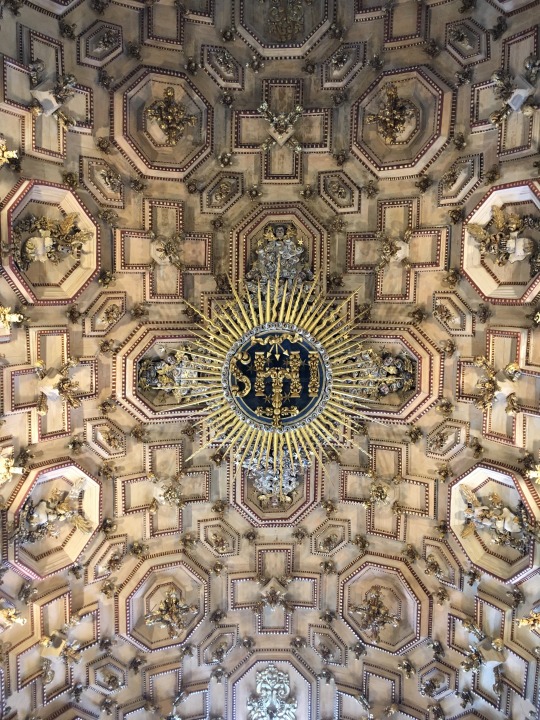
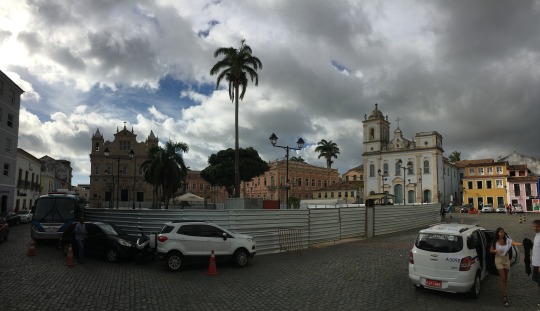
I explored some of the side streets which are full of restaurants and tourist shops and made my over to Largo do Pelourinho whose slope, triangular shape and colorful old buildings make it the perfect spot for photographs. At the base of the square is the sky blue Igreja Nossa Senhora do Rosairo dos Pretos, a church built by slaves (in their spare time) over the entire 18th century (on land granted by the King of Portugal). The interior does not match the facade’s beauty, but its significance to the black population for 300 years makes it an interesting stop.
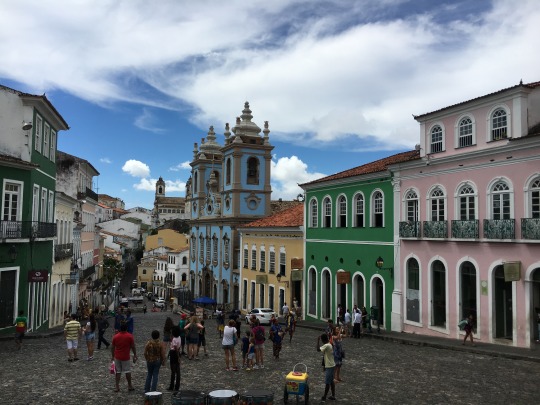
The road then continues uphill into the Carmo neighborhood, which looks similar but slightly less cute. The defining structure there is the Igreja da Ordem Terceira do Carmo, a massive church and former convent atop the hill. It too is less impressive inside tho it does offer some magnificent city views. The street continues into the Santo Antonio neighborhood which is still more run down but in a decidedly hip fashion. It is now being reclaimed by small pousadas (inns), restaurants, music stores, boutiques, etc. So far they seem to be succeeding at restoring the area and adding to its character without sacrificing its authenticity. One advantage, as I found when I stopped for a coffee at Cafelier, is that the buildings on the west side of the street are perched high on the hill so they enjoy sweeping bay views.



I wandering back to Largo Terreiro de Jesus for my last stop at the Museu Afro-Brasileiro, which is housed in the fantastic pink colonial Faculdade de Medicina building. The museum started with eight artifacts in 1972 and has since acquired an important collection of items linking African and Brazilian cultures. It is much smaller than its counterpart in Sao Paulo, but that makes it easier to focus and understand the exhibits. The undisputed highlights are the 27 stunning carved wood panels by the artist Carybe, one for each of the deities of the local Candomble religion. Feeling much better about Salvador, I walked back home for a quiet Monday night.
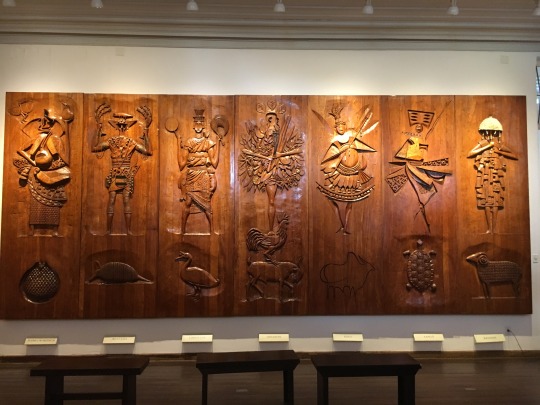
It was raining Tuesday morning so I started late. My first stop was the Museu de Arte Moderna housed in Solar do Unhao, a well-preserved former sugar mill and transfer station. The “museum” was underwhelming. The one exhibit occupied just one room plus a small side room with a video installation (it looked like there was an upstairs that was closed). The featured artist’s works examine colonialism’s enduring impacts. Some of the paintings were quite captivating, and nearly all had large gashes meant to resemble open wounds, which was very unsettling (as I’m sure she intended). With little to see, I did not stay long and, after walking around the marina only to discover the only restaurants were seriously over-priced, I took a car up to the Itapagipe Penninsula.
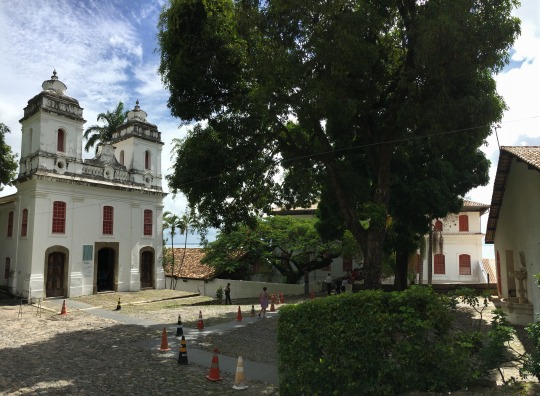
The main attraction here is the Igreja Nossa Senhora do Bonfim, the origin of the colorful ribbons that people are always trying to get me to buy. Apparently the Senhora effects miracle cures, and those ribbons grant wishes. I was pleased to see the plaza in front was undergoing a well-executed makeover that makes it a very pleasant place to hang out. Unfortunately the construction inside was still in progress so the entire altar was blocked off while the workers’ loud clangs and bangs diminished the overall effect. It’s not a particularly pretty church anyway. The only part that interested me was the Sala dos Milagres where people leave photos and even wax replicas of body parts to request cures or give thanks for successful ones. Hundreds of detached limbs hang from the ceiling. But other than that the church really is not worth the journey unless you’re very superstitious religious.

From the church I started walking west toward the bay. None of my guidebooks mentioned it, but I happened to read somewhere that a nearby lookout point offered some great views. After 20 minutes of walking I reached the coast and yet another old fort, Forte de Monte Serrat. The attempted military museum inside was falling apart, but the views around the fort were indeed fantastic. Looking to the south I saw a very serene, almost empty beach and to the north a number of small fishing boats and kids playing in the water. It struck me that this must be Salvador at its best. I walked along the beach a little then back up to the fishing area which is an outcropping called Ponta do Humaita. There is not much there: an old church (of course), a long pier, a little lighthouse and what appear to be some old military buildings. But there were kids diving in the water, locals chatting and drinking beer at the small restaurant and a few other tourists checking out the views. It’s a really nice spot, far removed from grit and/or tourist centers of the rest of the city.

That evening I headed back to Pelourinho since Lonely Planet said it comes alive on Tuesday nights after mass. There were a good number of people about, one especially crowded bar, a live band and some drumming groups, tho it did not seem like this was unusual. Still it was fun to see the area at night and sit outside eating dinner watching the band in the Cruzeiro de Sao Francisco square. I walked around a bit and ordered a large beer from the bar. But of course standing outside drinking invited the usual assault from people wanting things from me (some even asking for a sip of beer). I relented with one guy and let him tie one of those stupid ribbons on my wrist (which I realized made me look even more a target). I only had a 20 so I asked for 15 back (which I think is still pretty generous). He went to get change then came back and put a crumpled bill and more ribbons in my hand-- of course it was only 10. Another guy witnessed this and tried to do the same thing, and when I refused him, he insisted he had AIDS. Federal police from the military stand guard everywhere, but like the restaurant staffers, they do nothing to try to curb the begging. This was all too much so I went home, frustrated that I couldn’t enjoy a nice evening in the city’s prettiest area.
On Wednesday I surprised myself by waking up early to join a boat tour of the Todos Os Santos bay. It’s a large, beautiful bay with 56 islands which are mostly cloistered close to land. As a solo traveler my only option was to join a large boat with dozens of other travelers. That is not my style at all but I hoped it would be worth it. The vessel, the “Maria Mulata” (!), was full with about sixty people, but it was comfortable enough. It took 1.5 hours to reach our first stop, so in the meantime, the crew passed around fresh fruit and caipirinhas, and a jovial three-man band played music. One of my fears was that I would be pressed into small-talk with strangers all day, but it turns out that I was the only English speaker aboard so I barely talked to anyone (which grew tedious). Most passengers were Brazilians along with a few Argentinians (a standard tourist mix here). The band were working hard to create a festive atmosphere, so there was a lot of encouragement to clap and sing along. I’ve never cared for this kind of enforced enjoyment so I just smiled and tapped my feet. But sticking out as I do, the band leader quickly signaled me out and had me get up and do a silly synchronized arm waving dance. I at least showed them I have some swagger in my hips, and everyone seemed really nice so I didn’t mind. The journey was tough tho because it was all in Portuguese, and I would repeatedly get drawn into interactions where all I could do was smile and say, “Sim!”

We finally reached Ilha dos Frades, a beautiful tropical nature preserve. I walked around the small accessible section, through the tiny village which was oddly buzzing with lots of construction, up to the cute little church on the hill and then down to the beach for some beer, swimming and relaxing. It was all quite nice.

After a couple hours we got back on the boat. Halfway across the bay, we encountered some engine trouble (ah... Brazil) and just sat and swayed in the waves while the band tried to keep everyone’s spirits up. After 20-30 minutes another tour boat came along and tugged us to the next stop, Ilha de Itaparica, the bay’s biggest island. There was no dock here so we had to transfer to small speed boats that carried us to shore. This stop was for lunch at a lovely restaurant/resort, but the beach in front of it was not nice at all. We did not stay long tho and soon were being ferried back to a new, bigger boat. This operation took a long time since I think we had merged with another group or two. By the time we started moving, it was getting close to sunset so we headed right back to Salvador. I think there was supposed to be another stop at a nicer beach but clearly we had run out of time. This was very frustrating, but none of the staff seemed to acknowledge it or apologize or offer some compensation, like free drinks on board. At least the ride back during sunset was wonderfully beautiful, but the tour was disappointing overall. I figured we spent just three of the eight hours on the islands. As lovely as that lunch was, they need to find a new spot that is more accessible and has a nicer beach so we could have spent the whole afternoon there.
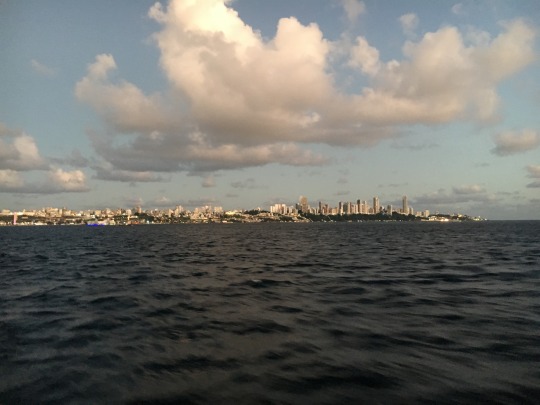
That night I did something I almost never do: I followed The New York Times’ travel advice. I find their “36 Hours” pieces pretentious and aimed at their readers’ narcissistic desires to have a more “authentic” vacation than everyone else. They tend to ignore the things most tourists enjoy and to recommend expensive restaurants and out-of-the way spots so that their readers can feel like they’re doing something special and unique. But there is not a lot for tourists to do in Salvador and (as the NYT acknowledges) much of the city is too dangerous for tourists to explore. So I thought I would try out some of the recommendations from their article in January. Yes, they have some expensive suggestions and steer you to some far-off places, but to their credit, they start in Pelourinho, admitting that despite the tourism and aggressive tourist hunters there, it’s still the nicest part of town. And they were right about the restaurant where I ate Wednesday night, Mistura Perfeita. It’s near the center and looks like every other hole in the wall here with plastic tables and chairs setup out front, but they serve incredible lambretas (clams cooked in an oniony broth) and delicious caipirinhas in a a wide variety of exotic fruit flavors. And they get extra points for being the only restaurant I visited where the staff actively shoed away beggars from the outside diners. (Still, the NYT couldn’t help itself: it praises the Mouraria neighborhood as “gloriously not prettied up for visitors”, as if the writer were foolish enough to walk around the area at 8:30p when they claimed to be there.)
By Thursday I had run out of things to do so I stayed in all day and caught up on this blog. That evening I headed to Rio Vermhelo, a seaside area up the coast from Barra that’s know for its nightlife (and was also recommended by the NYT). It’s a 20-30 minute drive from the center, and it feels very apart. It’s much newer, cleaner and safer than the rest of Salvador with far fewer street people but it lacks the Afro-ness the city is known for. It’s a nice, pretty area and the only place I’ve felt entirely safe and comfortable walking around. But it feels like it could be any coastal neighborhood in Brazil or anywhere else for that matter. For locals I imagine it’s a nice escape. The focal points (besides the beach) are several plazas lined with interchangeable restaurants and countless vendors (mostly selling acaraje or tapioca). Several hosted live music. I was disappointed at how generic the restaurants are-- they’re essentially the same as all the others around the city but newer-- until I realized that Salvadoreans like generic restaurants. They just want to sit outside with their friends sharing beer and snacks, so it doesn’t matter where those come from. They like the familiar and comfortable, and I get that. As I explored the area a little more I discovered it also has some hipper, more discreet bars with DJs, live music and younger crowds (more like American bars). All in all it seems like a cool area and probably the best place for tourists to stay, despite-- or because of-- its distance from the center. Also, for the (newspaper of) record, NYT got Rio Vermelho all wrong. They recommended a bar that serves weird, sugary shot concoctions and the least interesting, most touristy plaza. Take that “36 Hours”.
Friday was another day with nothing to do (except counting the hours until my flight home). I took the Elevador down to Comerico, the waterfront neighborhood below Pelourinho. It’s one of the city’s original neighborhoods and I guess it is still the commercial center, tho it was hardly bustling. It’s full of beautiful old buildings which have mostly been left to rot. Some have masked their decay with fresh paint; others are fabulously deteriorated like ancient ruins. It’s quite a sight, especially juxtaposed with the more modern office buildings that have sprung up among them.
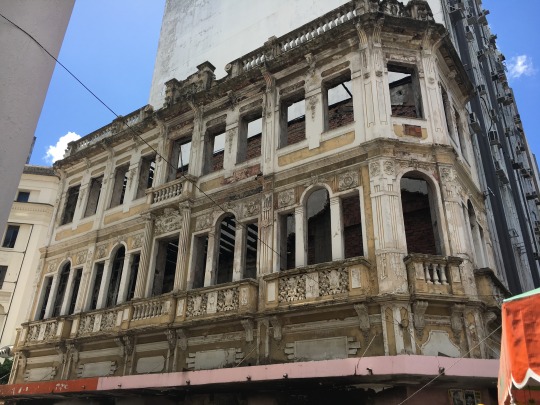
That evening I packed excitedly, well ready to be home. And then, somewhat unexpectedly, my last night turned out to be pretty special. I had planned to go back to Santo Antonio to Forte da Capoeira since I thought there would be a capoeira show there. But when I looked out my window, I saw the building across the street was hosting an event with drummers and dancers, so I went to check it out. It appeared to be the closing night party for a symposium on African culture in Bahia. And right in front was a group of 8-16 year-olds putting on a capoeira show. Obviously they were novices (although some had good moves) but I caught the gist, and the kids looked like they were having a really good time. I also enjoyed the variety of people that passed by to watch for a few minutes, particularly the grandmother with her baby granddaughter who loved playing with some trans women’s dogs. Dois de Julho is a gritty area but a colorful, diverse, tolerant one (like San Francisco’s Tenderloin).
Later, for the first time in Brazil, I went out to a gay club. I resisted before since I knew it would mostly be me standing around, watching, unable to talk with anyone. And that’s pretty much how it happened, but I’m still glad I went. Everyone was enjoying themselves (and others...), and it was fun and interesting to note the similarities and differences to bars back home. Then it was back to my AirBnB to sleep one last night in Brazil.
It took me a while to warm up to Salvador. Everyone said the same three things about it: one, you’re going to love it; two, it’s different from the rest of Brazil and more African; and three, be careful it’s really dangerous. When I heard this from Brazilians, I sometimes suspected two and three were code for “poor and black.” From what people had told me, I half-expected to see women carrying jugs on their heads, donkey-drawn carts jostling with cars while chickens scurried out of the way, muggers lurking in every doorway and nonstop singing, dancing and drumming. These are quarter-truths at best. Salvador is unmistakably Brazilian in its look and feel, tho many people sport more African-looking styles and behave more forwardly and loudly. While the city’s general state of disrepair shows its age, it is actively building and modernizing. Crime rates are high here, but I exercised common sense and did not encounter any problems. (There are a LOT of homeless and beggars, and they can be quite aggressive and demanding, but this is a far cry from mugging.) And while I did hear a lot of music (and firecrackers) around the city, most of it was coming out of speakers not street corner performers.
My timing was unfortunate, visiting at the fatigued end of my trip and starting on a quiet holiday weekend. Not only was the city duller than usual, the emptiness exaggerated my fears for my safety. But as the city normalized during the week and really picked up on Friday night, I started to see all its wonderful qualities and appreciate its color and vitality. Still it was hard to ignore the city’s drawbacks. Every time I went outside, I was targeted by beggars, scammers, vendors and anyone else who wants a dollar, and many of them were extremely difficult and unpleasant. When I can’t just sit outside and enjoy a beer without being harassed, it severely curtails my enjoyment of a place. Safety concerns also kept me from exploring most of the city or walking around at night, which are my favorite things to do when traveling. In Brasilia I couldn’t walk by design, in Salvador by decline.
And finally, beyond safety concerns, it’s not an easy city to be a tourist. There is not much to do (especially if you don’t care for the beach). It’s difficult-to-impossible to find information online, and when you do it’s often incorrect-- even the tourism agencies don’t have websites. (In fact I’m writing this in an otherwise very nice, contemporary, “American-style” cafe that requires a Facebook account to get on their WiFi which I do not have.) And Bahians, like much of the rest of Brazilians, do not seem to care much for outsiders. To Salvador’s credit, I saw improvement works projects all over the city-- several of them impeding my tourism-- so they are working on making it a nicer, easier place (at least the tourist areas). However I suspect it will take them decades to undo the decline of the past hundred years, and it would take a significant shift in culture and crime rates before tourists really feel welcome.
Salvador reminded me in some ways of Philadelphia, where I went to college 20 years go. Proud, defensive Philadelphians were well aware of the generally negative view of their city, and they were quick to remind me that it was the nation’s first capital. (To which I responded that New York was the second, but they seem to have moved on.) Salvador’s motto is “First Capital of Brazil” (the second capital, Rio, also seems to have moved on). Like Philadelphia, its glory days are behind it, and the city seems to be slowly decaying with pockets of revitalization. But I think that’s how the people there like it; it’s part of the city’s unique character and culture. Ultimately I am undecided on Salvador. I did not love it as much as everyone told me I would; its qualities are largely counterbalanced by its drawbacks. And I think that’s just how the locals want it.
0 notes
Text
Brasilia, Brazil
Few people have anything good to say about Brasilia, the country’s capital. Built from nothing only sixty years ago, it is now the third biggest city in the country, yet it draws few tourists. Even many “residents” leave on the weekends-- they are only here for work during the week and return to their home towns whenever they can. But from an architecture and urban design standpoint it is one of the most distinctive, unusual cities in the world, and that’s why I wanted to see it.
A quick history... For most of Brazil’s colonial history, cities along the coast competed to be power centers. Many agreed that the capital should be moved to a neutral location in the central interior, and the new republic’s Constitution of 1888 even called for it. But it wasn’t until after WWII that a president, Juscelino Kubitschek, put a plan into action. He assembled a team of designers and architects-- most notably Oscar Niemeyer-- to design the new city. In 1960 (59 years ago this week), Brasilia was inaugurated, and the capital officially moved from Rio. Niemeyer (who had strong communist leanings) wanted it to be the city of the future, where rich and poor would live and work side-by-side. His distinctive Modernist buildings still define the cityscape and were the main draw for me.
The main city of Brasilia is shaped like an airplane (it’s surrounded by 25 satellite towns too). The cockpit, fuselage and tail (the “Eixo Monumental”) contain most of the government buildings, museums and other attractions. The wings are divided into a grid and areas are named after what they contain, such as shopping, hospitals, sports clubs, etc. (Yes this is very strange as you would think it would behoove everyone to have these things spread around.) Beneath the wings is a large (manmade) lagoon. In many ways it’s a brilliant design (not unlike Burning Man) but it’s executed very poorly.
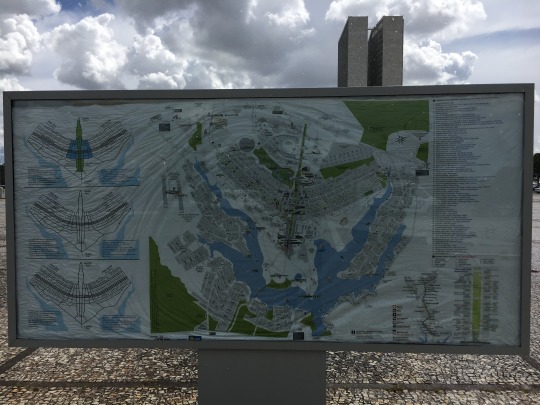
I arrived Monday afternoon to a relatively cushy AirBnB in the Hotel Saint Moritz in the “Northern Hotel Sector” (at the top of the fuselage). I needed some food, and the only real option was a giant mall (Conjunto Nacional) across the street. Brazilians love malls, and that’s especially true in Brasilia since there is effectively no street life (more on that soon). This mall was massive and yet there were no maps or directories. I really couldn’t fathom how that works tho I tried to as I wondered for half an hour to find the food court. That night I decided to take it easy, but I did enjoy the rooftop view of the axis.
On Tuesday morning I stepped out to begin my walking tour, which, if you’ve been to Brasilia, you probably find laughable. First, the distances are much bigger than they seem on a map, mostly because there is so much dead space to cross (lawns, parking lots, empty lots, grassy knolls, etc.). Two, Brasilia is famously made for cars, so there are few sidewalks or crosswalks. This means forging trails where you can (including on medians), waiting for a break in speeding traffic on four-to-six lane roads so you can run across, teetering on narrow curbs, walking in the street alongside parked cars, etc. It is extremely unpleasant, sometimes terrifying and often inefficient. It’s also surreal as when sidewalks or staircases (some of the few concessions made to pedestrians) just end abruptly at a busy road; the city planners know people will walk across that road but have done nothing to aid them. I know that in some places (like parts of southern California), the lack of sidewalks reflects that fact that nobody walks anywhere. But lots of people walk here. The problem is that they’re poor. The middle and upper classes drive cars, and city government doesn’t care about poor pedestrians. I suppose that Niemeyer thought everyone would drive in the future, and that’s why he designed such a sprawled city that can really only be traversed by car. But the result is a betrayal of his egalitarian principles (not to mention an environmental catastrophe).
Nonetheless I was determined to walk. Google Maps’ walking directions pointed me to... the mall. Yes Brasilia lacks sidewalks but you can take malls to get from points A to B. (Once again I got lost in the mall, so it took about 15 minutes to find B.) On the opposite side of the mall from my hotel sits a small plaza (hilariously named Praca dos Pedestres or “Pedestrian Plaza”) with a view overlooking the Eixo. It’s similar to The Mall in Washington, D.C., but it is not inspiring. You can see some of the stranger Niemeyer buildings along the axis and the Congresso Nacional at the end, but it’s mostly a large empty patch of grass that seems unfinished. My first stop was the Teatro Nacional, a sort of pyramid without a top that would make an awesome waterslide. Then I visited the Biblioteca Nacional, a fairly new (and incomplete?) building. It kind of resembles a hi-fi stereo from the 70s and looks great from afar. But up close it’s a terribly wasted opportunity. The ground floor of the building is encased in opaque glass windows so that it’s impossible to see inside-- or even get inside. I walked around the entire building before I found the drab entrance. Of all types of buildings, libraries should be accessible, open and functional, but it seems Niemeyer preferred grandiosity for one of his final designs.

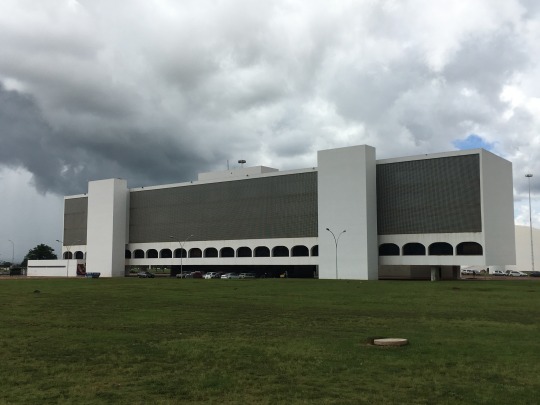
I continued on to the Museu Nacional and the Catedral Metropolitana, two of the city’s strangest, most recognizable buildings. They are both quite compelling in person, tho not well kept up and smaller than I imagined (or perhaps they’re dwarfed by all the empty space around them). The museum is a white dome with a Saturn-like ring around it and a large ramp leading to the entrance. It hosts rotating exhibits, but I was mostly interested in the building. The cathedral resembles a wheat bushel with leaning columns coming together in a peak at the top, separated by giant stained glass windows. The effect on the interior is unique and breathtaking.




I then walked to the “Banking Sector” which has more to offer than you might expect. Brazil’s banks-- and especially the central bank-- often offer cultural centers and exhibitions centers, which at the very least can provide a good opportunity to glimpse inside some beautiful buildings. Case in point, the Caixa Cultural, a large bank whose lobby is filled with stunning stained glass windows, one for each of Brazil’s states. Across the street is the headquarters of the Banco Central do Brasil, a deceptively light looking skyscraper, that is home to a “money museum” featuring currency from around the world (unfortunately I could not go in without my passport).

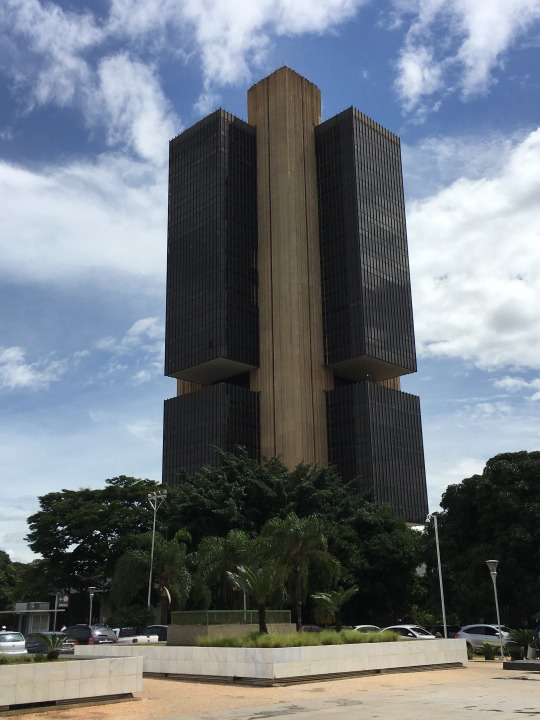
Cursing the traffic and city planners, I continued my walk, now scrambling south from the axis. My destination was Santuario Dom Bosco, a beautiful modernist church famous for its chandelier and illuminated Murano glass meant to resemble a starry night sky. It was also a nice place to sit for a minute and let my frustrations with the city subside. But that didn’t last long. I ventured back out and over to TV Tower, a broadcast tower that is one of the country’s tallest structures and offers sweeping city views. Supposedly. After a hot, lengthy walk dodging cars I arrived only to discover it was closed for construction. At this point I decided to treat myself to an Uber to get home, tho not before one last stop at... the mall. And yet again I got lost, this time in search of a grocery store which it turns out the mall doesn’t have-- apparently I should have gone to the grocery store sector. That evening I decided not to venture far from my hotel, which fortunately sits on a small plaza with a pizzeria, beer bar and convenience store.

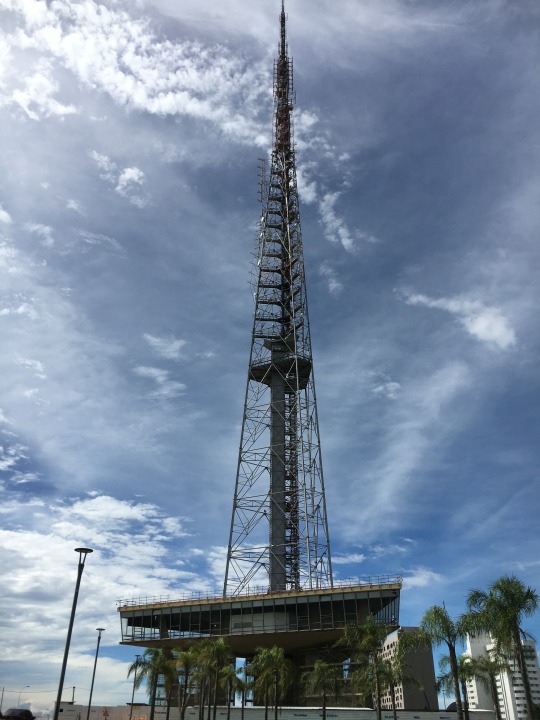
On Wednesday I set out (in an Uber this time) to finish my tour of the Eixo. I headed to Praca dos Tres Podres, the hub of the federal government. Sites include the Supremo Tribunal Federal (relatively dowdy); Palacio do Planalto (the Executive building which looks similar but its elevation on stilts makes it much more remarkable); Panteao da Patria e da Liberdade (a collection of striking geometric forms, including small dove-shaped performance space with a beautiful stain-glassed window, a stairway to an eternal flame and Brazil’s largest national flag); Espaco Cultural Lucio Costa (an underground lair honoring the city’s main urban planner which includes a giant scale model of the city); Museu Historico de Brasilia (a small, elevated marble block whose interior walls are engraved with the story of the city and several inspiring quotes about it, and whose exterior features a massive statute of Kubitschek’s head); and several art pieces. Up the hill are two beautiful buildings that house the Foreign and Justice ministries: Palacio do Itamaraty and Palacio da Justica. The former appears to sit in a lake that reflects the buildings columns and arches, while the latter’s exterior contains several cascading water falls. (Side question: if Brazil has not had a monarch since 1888 and Brasilia was built in the 1950s by a leftist government, why are all the buildings called palaces?)
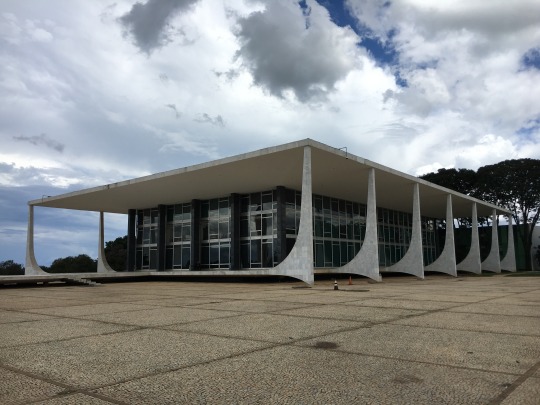

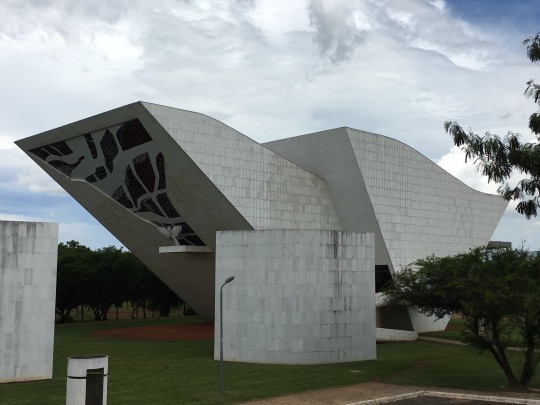
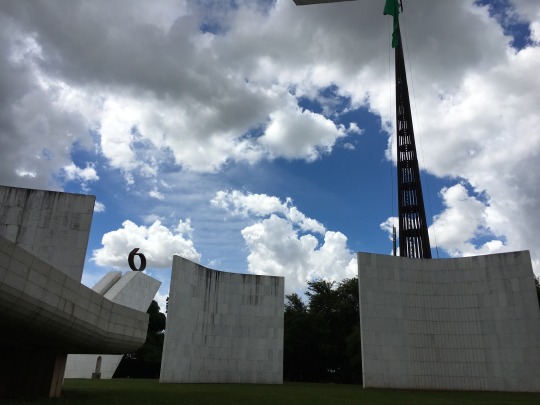




The centerpiece of all this is the Congresso Nacional, an eye-catching masterpiece rich in symbolism. Two tall, narrow towers intersect a low flat building with two roof adornments, a dome and a bowl. The dome (symbolizing inclusivity) tops the House chamber while the bowl tops the Senate. These are lined up neatly with the towers so that they balance each other out, tall and short, wide and narrow, heavy and light, square and circle. It’s really a perfect structure that I could not take my eyes off of as I walked around it.


Once I had soaked in as much as I could, I took a car down to the “Sporting Clubs Sector” to the Centro Cultural Banco do Brasil, another bank-run exhibition space. This one is dedicated to contemporary art, and the current exhibition was on photorealism and hyper-realism, where artists use photographs to create amazingly realistic paintings that are able to convey qualities that the photography does not, such as depth, light, texture and social themes. The technical mastery behind these works was mind-blowing, and it yielded interesting insights into how different media and technology help each other to progress.
I then headed further south to Pontao do Lago Sul, a waterfront area with restaurants, performance space and meandering paths. It feels very new and contrived (like the whole city I guess) but it’s still a nice place to enjoy the light of the sunset. On my way home I stopped back at Praca dos Tres Podres to see it lit up at night, and I’m very glad I did.
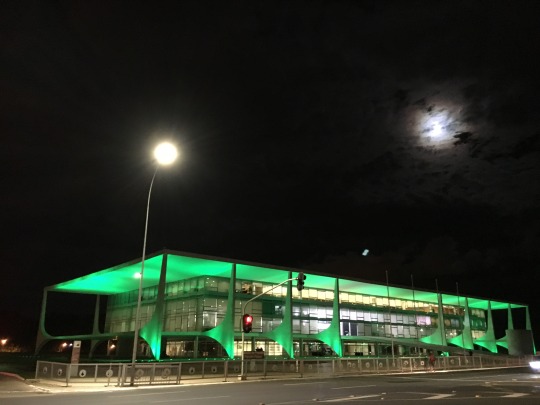

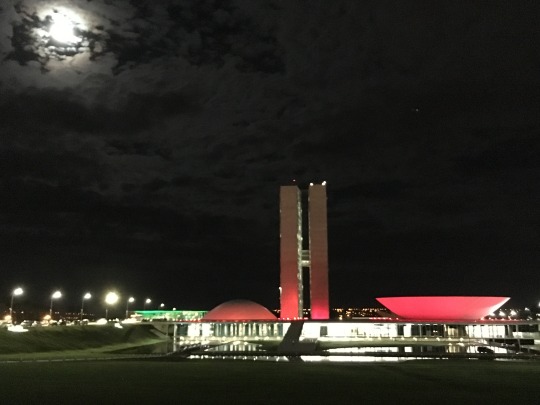
There was not much left to see on my last day so I spent most of the time relaxing and catching up on this blog. I stepped out for a moment to see JK Memorial, Kubitschek’s museum and mausoleum (in the cockpit). It’s a modest, tasteful building full of the president’s belongings (documents, medals, clothes, pens, 1974 Ford Galaxie, etc.). The displays were in English which is always nice, but I do not have a strong interest in Kubitschek so I breezed through quickly. I did enjoy the recreation of his library (with 3,000 books) and the many historical photographs, particularly those showing the building of Brasilia. I noted how much empty space lay between buildings during the construction. This is to be expected but one would also expect that space to be filled in over the next sixty years....
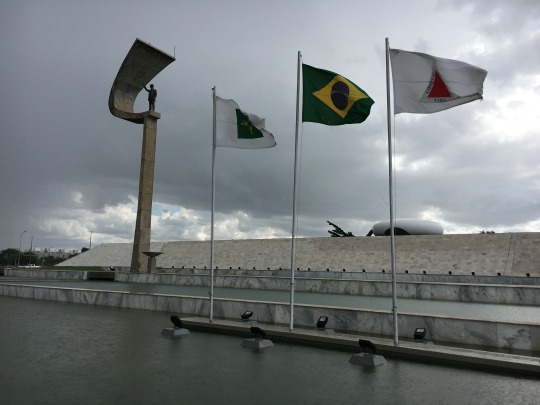
Brasilia is a city most people don’t want to spend much time in or think much about it. But it’s actually a fascinating place that made me consider the value of architecture and urban design. I loved the notable buildings here much more than I expected to. Concrete Modernism does not sound aesthetically pleasing, and I thought the city would look more kitschy, like Epcot Center. But these thoughtfully rendered buildings really opened my eyes to how beautiful modernism can be and how well it can age. Just as important, the city founders (especially Niemeyer) did not try to emulate existing world capitals like London or Rome. They created entirely new buildings that were-- and still are-- distinctively Brazilian. If a country’s capital should showcase its own aesthetic, Brasilia has succeeded.
And yet in almost every other way it is a failure because of-- not despite-- its (over) design. Contrast it with Sao Paulo, a city that has grown up entirely organically. Yes it’s a mess but it’s a much more exciting, livable, human city. Brazil’s cities have incredible street life but that’s pre-empted in Brasilia. This city offers a lesson that cities grow from the bottom up and cannot be handed down from above. Clearly the designers had an idea about how a city should work, but they completely ignored how they actually work. Good urban planners will take note of existing human behavior and patterns and accommodate them (for example, building parking lots) while encouraging better civic mindedness (like building bike lanes). It’s also foolish to design a city around a technology that’s only 50 years old (driving) while ignoring what humans have been doing for tens of thousands of years (walking). Like so much of Robert Moses’ concurrent work in New York City, this urban design sacrificed the city’s residents to the greater concept of the city.
It’s probably too late to fix Brasilia and all its wasted space (and there does not seem to be much will to), but some elements could be corrected, starting with the city’s ambivalence-- even hostility-- toward tourism. Despite its short history, Brasilia is a unique, important city with many attractions in relatively close proximity. It would appeal to a lot of people, especially architecture enthusiasts and Brazilians interested in their own government. And the people are much friendlier than in Rio (perhaps because in Brasilia people are grateful to have visitors whereas in Rio they are taken for granted). But the city does nothing to encourage tourism. There are no good options for getting around, and all of the government buildings are either closed to the public (a terrible look for a democracy) or are only open in small windows or under specific conditions. From an outsider’s perspective it seems they don’t actually want tourists here. Everyone I met first asked me if I was here for work, then if I lived here. They were all surprised to learn I was just on holiday.
I think it would be fairly easy and inexpensive to turn the Eixo into a proper tourist destination. Put in sidewalks, crosswalks and stop lights. Fill in the empty spaces with trees, fountains, playgrounds, pathways, reflecting pools, etc. Over time add more buildings like museums, hotels (outside of the hotel sectors!?) and restaurants (currently there are zero). It’s practically a blank slate surrounded by some incredible buildings housing the seat of the federal government of one of the world’s biggest countries. Visiting Brasilia could be a treat, not the chore most treat it as. I wonder if there is resistance to changing the city so as not to dishonor the original vision (Niemeyer was still called upon to build the major new buildings up until his death in 2012). If the city wants to fulfill its ambition to be a city of the future, it needs to adapt and modernize. If it does not, its problems will only multiply, and it will stagnate and decay and will remain a city stuck in the past. I think a photo from my hotel roof taken on my last night illustrates Brasilia’s potential and its (so far) disappointing failure to live up to it....
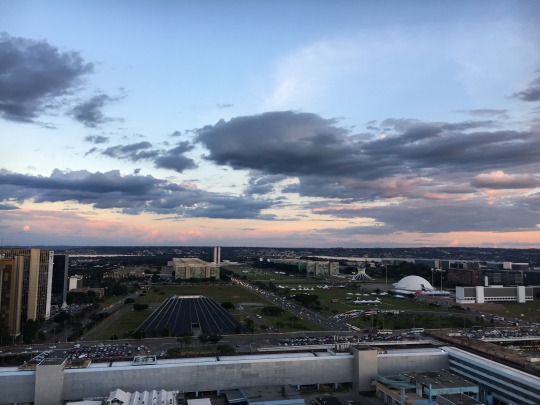
It ended on a good note tho. Taking off from the airport I was just able to make out the airplane shape from my window seat, and that made it feel like my trip was complete.
3 notes
·
View notes
Text
Rio de Janeiro, Brazil - Week 2
After the sweltering, unseasonable heat during my first week in Rio, the forecast for the next week called for rain. It’s rained everywhere I’ve been so far, but the short bursts and high temperatures meant that the rain did not hold me back. I was not prepared for the flood that was heading toward Rio.
I approached Monday trepidatiously, unsure when the clouds would burst and end my day. But it was sunny and hot as usual (and especially humid) when I woke up so I walked up to the lagoon and over to Leblon. The lagoon offers some lovely views from the running/cycling path that surrounds it.
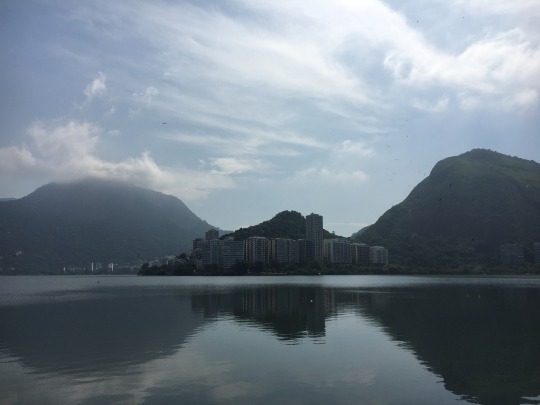
Leblon is adjacent to Ipanema and almost indistinguishable. It’s known to be quieter and more laid back (and ritzier it seems). And on Monday morning the crowd was much older, kind of a Palm Beach to Ipanema’s Miami. I walked along the beach on the delightfully, swirly designed sidewalk promenade that lines the beaches all the way up to Leme (and some of the city streets too). I reached the base of Dois Irmaos, the iconic peaks that cap the beach’s eastern end, and enjoyed the views from the Mirante do Leblon there. And then I walked inland to my real destination: BB Lanches. In “The Beastie Boys Book” the band mentions that this is their favorite juice bar in Rio, and they named one of their songs (”Suco de Tangerina”) after an item here. So naturally I had to stop by for some tangerine juice.
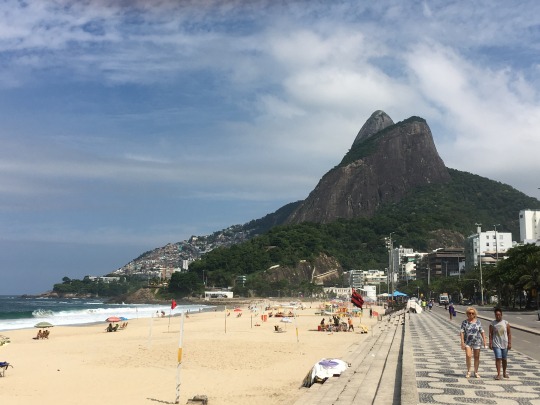

With no sign of rain yet, I took an Uber to the Urca neighborhood at the base of Pao de Acucar. Just south of the Morro de Urca is Praia Vermelha, a small sheltered beach. At the end of the beach is Pista Claudio Coutinho, a popular 2k walking path that wraps part way around the hill. It’s a pleasant jungle stroll where you can hear waves crashing below and take in expansive views of the ocean and nearby islands.


I reached the end of the trail, turned around and walked back to the beach and up to the west side of the hill. The Urca neighborhood felt very distinctive. It begins with a small marina full of little fishing boats and then turns into a cute residential area, tucked in to the base of Acucar. Most of the homes are modest (with a few princely estates, especially up the hill), and there is just one small commercial strip. The most notable feature is the Mureta, or sea wall, that looks out over the city and the bay. It’s a popular place to sit, hang out, drink beer and enjoy a quiet moment in this hectic city. The area feels like a small coastal town unto itself. In fact Urca is actually where the city of Rio started before it moved farther north. And there are still a few military bases here, presumably protecting the city from seaborne attacks.
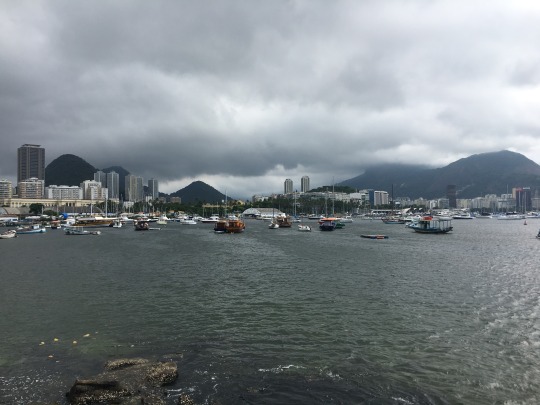

With clouds forming, I decided to head home. I took a short nap, and when I awoke, rain was pounding the city, dumping buckets while thunder and lightning jolted the sky. This continued for several hours, and when I walked outside for dinner, a river was gushing down the street (which must be why it’s called Rio...). Water was up to my ankles on the sidewalk and my calves in the intersection. Fortunately I did not have to go far to eat dinner before I retreated back to my apartment. The rain calmed down a bit by midnight but it did not stop until....
Tuesday around 3pm. Rio normally receives 95mm in April. In nine hours on Monday night it got 246mm. Some neighborhoods saw walls of water taking out cars, and some favela endured mudslides (which killed at least three people). Apparently the lagoon overflowed too. My friend here said he had never seen anything like it in 15 years here. I was relieved that the event was as cataclysmic as it seemed to me and not a commonplace carioacan affair. The rain was less intense on Tuesday, but the city was recovering from the impact so many things were closed. I had to cancel my plans and stay shut in.
On Wednesday I re-emerged and headed to the Museu de Arte Moderna. It’s looking a little run-down these days but still has a good collection of mostly Brazilian art from the 20th century. It’s displayed according to traditional painting subjects (landscape, portrait, still-life, etc.), and they have some fun with modern artists’ takes on the classics. I particularly enjoyed the last exhibit on illusion and how context changes art.
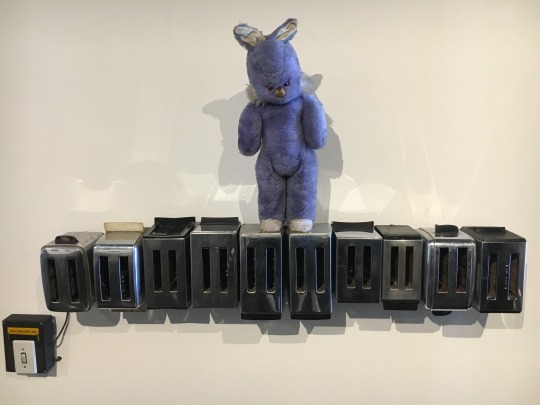
My day took a turn for the frustrating after that. I wanted to go to the Flamengo FC match at Maracana stadium on Thursday night. I bought tickets online, but this being Brazil, it was not so simple. First I had to print out a voucher, so I asked my friend to do this at his office, then I met him to pick it up. Then I brought the voucher and my passport and credit card to one of Flamengo’s stores. There I was informed that I had bought student tickets so I could not use them (the website said nothing about this). The game was sold out, so I could not get other tickets. My tickets were supposedly refundable (minus the service fee of course), but as of this writing, the money had not been returned. I was disappointed not to get to see Maracana, a legendary stadium, but mostly annoyed at having to go through this big hassle for nothing. I know that Latin American countries require saintly patience, but I was really missing good ol’ American (and Silicon Valley) efficiency at that point.
Nevertheless, I persisted. I stopped by Igreja Sao Francisco de Paula, a gorgeous church whose interior is covered with intricately detailed carvings. It looks more like an opera house, but with the refreshing lack of gilding it felt more tasteful than the other churches I’ve seen.

I carried on to Museu Nacional de Bellas Artes. The collection is supposedly formidable, but most of the museum was closed for construction and/or exhibit rotation. Really just a few rooms upstairs were open, as well as two hallways with some busted-up Grecian marble statues that were copied from the Louvre and some oddly configured side rooms that did not look interesting. (Brazil does not seem to be aware of central air conditioning since most buildings have separate A/C units for each room (if any at all). This fits uncomfortably with places like museums that should be open and lend themselves to a flow, rather than a series of rooms behind closed doors.) After a short look around I stopped for some beers then returned home for the night.
On Thursday the clouds had mostly parted and the sun was high and hot again, so I could resume my outdoor activities. I took a car back to Parque Lage (the first place I visited when I arrived) so that I could take the steep hike up to Cristo Redentor. It was only upon reaching the trailhead-- some ten minutes into the park-- that a security guard informed me the trail was closed due to the rain. Thwarted again. I explored some more of Lage (which is just a small section of the tropical Parque Nacional de Tijuca, something I would now not be able to see) before calling another Uber to take me to the Corcovado train station.
The “Christ the Redeemer” statue is probably the most iconic, recognizable feature in Rio. The most popular way to get to it is on a small old train that slowly runs up the steep incline three times an hour. Stepping off the train and up a few flights of stairs, the view at the top is spectacular. Corcovado hill is right in the middle of the city, and it’s one of the tallest, so you can see everything, past Maracana in the north, past Niteroi across the bay and past Dos Irmaos to the south. I was pleased with how much of the city I could identify at this point and with the realization that I had covered a good chunk of it. The statue itself, while a feat of engineering, is nothing special, as it’s meant to be viewed from afar. (I’ve actually been surprised at how small it is. I think I’m used to aerial photos taken from above it where it seems to loom over the whole city. Or as Homer Simpson put it, “It’s like he’s on the dashboard of the entire country.”) The journey has two notable downsides tho. One: all the tourists, clogging the best viewpoints and all taking the same photos of themselves with their arms outstretched under the statue. The other drawback is the waiting. When I arrived the next available train was almost two hours off (although you can make reservations online). Then you wait to board the train. Then you sit on the train for 20 minutes, mostly looking out at dense, unspectacular forest. Then you wait for an opening to take the photos you want. Then you wait to board a drain down and then another 20 minute ride. There are so many hills around; I wonder if any others offer a similarly thrilling view while being more accessible. At the very least, I would take a van up (which they offer from a few parts of the city) since the train adds considerable time and nothing more than kitsch value.




When I was back in the Cosmo Velho neighborhood, I walked east to its other attractions. The first is Largo do Boticario, an old square surrounded by colorful colonial houses near a babbling brook in a jungle canopy. One hundred (plus) years ago, it must have been a charming area reminiscent of an old Portuguese plaza, but it’s completely decrepit now. (Apparently the buildings have been bought by a hotel company that will restore them.) Farther up the road is the brand-new Casa Roberto Marinho. Roberto founded Globo, now a huge Brazilian media empire. He restored this Mediterranean villa and grounds as his home and hosted who’s-who parties in the 1960s and 70s. The building has now been turned into a private museum to display his art collection, with a heavy emphasis on modern Brazilian art. The works are phenomenal and the home and gardens beautiful. You really get a sense of what it might have been like to hobnob at one of his parties. After that it was time to call it a day and have a relaxing evening at home.

Before I went to bed I developed a stomachache that kept me up much of the night. (In Brazil a lot of restaurants offer cheap per-kilo buffets; it’s probably best not to eat at these places at the end of the night.) The next morning I still felt ill and tired so I stayed in bed most of the day. Bummer since my days in Rio were nearing an end.
I felt well enough (and well-rested enough) on Saturday to get myself to the ferry for Ilha de Paqueta. This is a car-less island deep into Guanabara Bay. I mostly wanted to go to see the views from the ferry, but the island is nice too. I rented a bike and rode around the perimeter (without stopping you could do this in under 30 minutes). The shore is dotted with little beaches and parks and (questionably) Brazil’s only baobab trees. Other than a small commercial area near the dock, the rest is full of homes (and a cemetery). I really enjoy enclosed, flat bicycling like this, and it was a nice, calm respite from the city. For the people of Rio it seems to be a mostly working-class getaway-- the beaches are not really that nice but the general environment is. I was mostly intrigued by the locals who live there. Although there is no local economy the island seems to encompass the full social strata-- large gated mansions, lovely cottages, modernized townhouses, abandoned waterfront estates, even a favela. It’s so Brazil to have all of this side-by-side on a tiny, beautiful island.
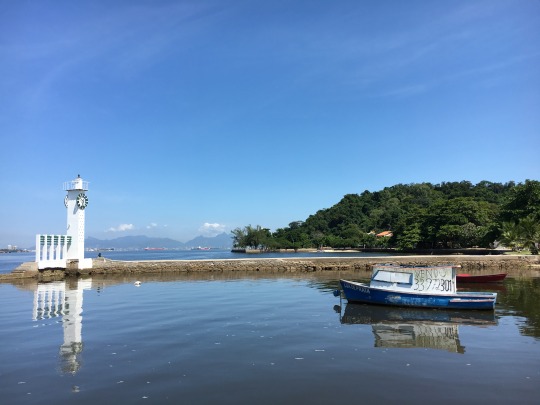
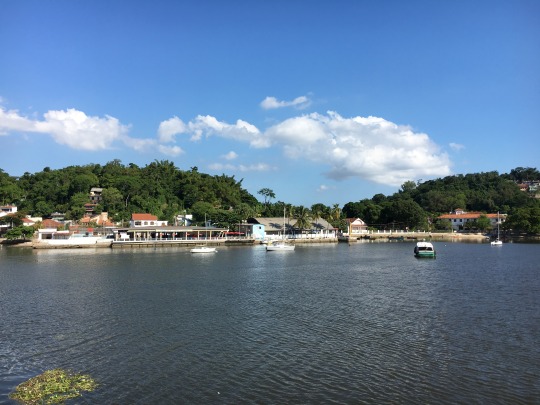
After a few hours I took the ferry back to the city. I stumbled upon a street party (Rivalzinho) and ambled around it a bit. I returned home and chilled out on my final Saturday night in town.
And then I awoke for my final day in Rio. I had planned to walk or bike around, but the on-and-off light rain showers made that less desirable. So I walked over to Copacabana beach since I still had not been. (Yes it’s one of Rio’s most famous sites, but Ipanema is a better beach, and I’m not much interested in hanging out on the beach anyway.) Copa is beautiful indeed, especially its graceful northeastward curve.

It made me consider what makes Ipanema and Copa so special and enticing. I realized that for both the natural beauty lies in the views: the jutting peaks at the ends, the water and the mountains and islands on the other side. But the immediate surroundings are not lovely at all-- the beaches are thick with barracas (vendors) and lined with densely-packed, (mostly) unattractive high-rises. It’s a very different approach than we take on the US west coast. There, beaches tend to be removed from cities and kept close to their natural state. Where there is nearby development it is usually minimal and often “beach-appropriate”, e.g. boardwalks, cottages, surf shacks, etc. But I’m not sure which I prefer. While I love an unspoiled, untouched beach (which Rio has if you go farther out), I like the way they incorporate their beaches into the city. It’s not pretty in a natural sense but it does add to the urban appeal. Perhaps on the west coast in our drive to “protect” our coastline we are actually under-utilizing public space. That said, Rio’s beaches do have two huge drawbacks. One, the vendors: it’s nice to know you can get anything you want right on the beach but it’s impossible to relax with someone in your face trying to sell you something every few minutes. And two, the stench: the waters here must be seriously polluted because every time I approached an open body of water (ocean, bay or lagoon), I was hit with an overpowering, stomach-turning scent of human waste. It doesn’t blanket the shoreline so you can settle into a spot out of smell’s way, but good luck getting there without wanting to vomit in your mouth.
And so my time in Rio drew to a close. (Well not before one final aggravation. For my flight to Brasilia, I was departing from the smaller Santos Dumont airport, which is on a tiny strip of land in the bay next to downtown. I opted for a window seat so that I could look out over the city as we took off. But on this plane, 7F did not have a window, just a wall. It was torture. Thanks Gol Airlines!) Rio is a beautiful, exciting city, and I enjoyed my adventure there. However I left with mixed feelings and wonder if I will return. The longer I spent there the more I missed things I take for granted at home: pedestrian right-of-way, good customer service, lower urban density, leafy greens, buildings that aren’t walled off, friendly strangers, punctuality.... And as much as I complain about our gay scene, it’s relatively friendly and low-attitude, unlike Rio’s. Rio is a big city that comes with big city people and problems, and despite its sweltering heat, it can be a cold place, at least to an outsider. I had a fantastic visit, perhaps just a few days too long. And I think I would like to return but next time it will be with friends or a loved one so that I can share all the good times the city has to offer.
0 notes
Text
Rio de Janeiro, Brazil - Week 1
The bus ride from Paraty to Rio was easy and uneventful. The road runs along the coast, but unfortunately the view is mostly obscured by overgrowth. I caught some dramatic, beautiful glimpses, but Brazil could learn from California and Australia. Upon arrival at my Ipanema AirBnB, I took a breath then settled in for two weeks of adventure....
My friends Scott and Tony had left Paraty a couple days early to come to Rio, so I met them for drinks and dinner Saturday night. We walked to a lively, popular-with-millenials section of Leblon and ate dinner at CT Boucherie, an established steakhouse-ish restaurant that was fantastic (and a great value for how much we ate and drink). Those guys had had a big night on Friday so we all turned in early.
And it’s good we did since Scott had a full day planned for us. We started at Parque Lage for breakfast at their famous restaurant. It occupies the courtyard of a crumbling mansion (now an art school) and sits just below Rio’s most famous landmark, Christ the Redeemer. It’s a setting made for Instagram, and everyone certainly took advantage of that. The food was pretty tasty for a place that could easily half-ass it. After breakfast we walked around the park a bit and saw our first monkeys!
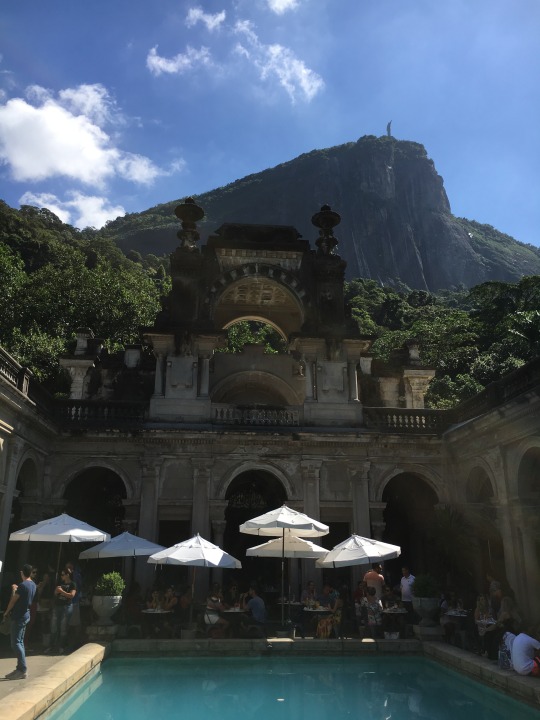

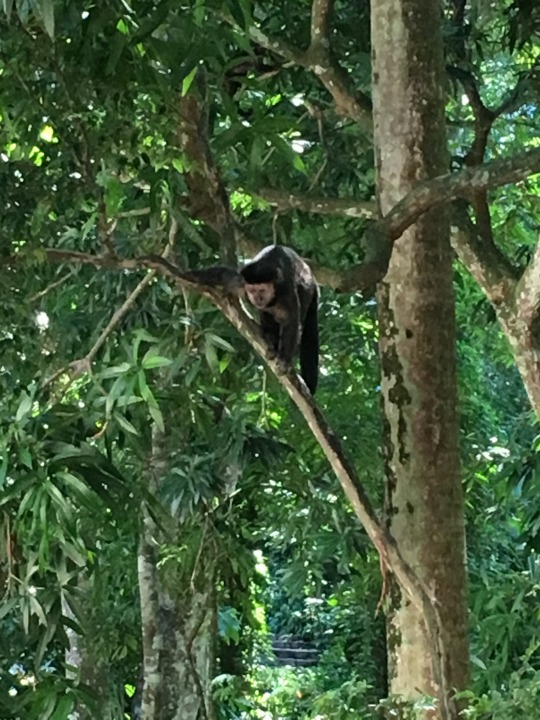
We then walked through Jardim Botanico, which appears to be the Beverly Hills of Rio. We walked through the Botanical Gardens as well, which are lush and beautiful. I think the most striking element were the massive tree trunks, some of which formed walls rising several feet above the ground.
From here we traveled back to Ipanema’s Praca General Osorio for the famous “Hippie Fair”, an arts and crafts market. I’m not sure what the big deal is-- it seems like every other crafts market I’ve seen. Afterwards the guys went to the beach, but I needed some literal chill time in front of a fan, so I lay low at my apartment for a while. We met up again for dinner at Zaza, a delicious Moroccan restaurant. It was the guys’ last night, but we were all pretty beat, so we called it early after a couple more beers.
Monday was shopping day, both clothes and groceries. I am not a beach person, and I was not prepared for how beached out Rio is. Even at nighttime in nice restaurants, people are in t-shirts, shorts and flip-flops. I needed some more beach wear to fit in (tho I only ended up finding one pair of shorts I liked). I met up with the guys again for lunch at Barraca do Uruguai, the most famous stand at Ipanema beach selling delicious meaty sandwiches. They had to get to the airport so we parted ways and I found myself all alone in Brazil....
On Tuesday I committed to the hard work of tourism. In the morning I took the metro to Centro, the historic center of Rio. I emerged at Rua Uruguaina into a hectic street bazaar. It was initially unnerving but a nice break from laid back Ipanema. Once I got my bearings I climbed up to Morro de Conceicao, a very old, Lisbon-esque street with cute (if shabby) townhouses, and then down to Praca Maua, the waterfront area that was revitalized for the 2016 Olympics. I first visited the Museu de Arte do Rio, housed in a beautiful colonial building attached to a gleaming modern annex. The view over Guanabara Bay is fantastic. The museum was showing two exhibits, one (”Mulheres”) featured women artists and had a lot of compelling pieces. The other was a history of samba. Once again I couldn’t understand the Portuguese captions, but there was enough music, video and glamorous visuals to make it fun nonetheless.

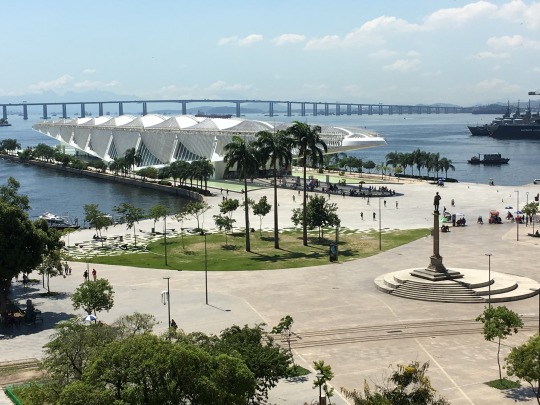
I walked across the plaza to Museu do Amanha (”Tomorrow”), a very modern “science” museum with a lot of interactive video displays and flashy installations for these selfie/social media loving Brazilians. The science was a bit thin; it starts with a brief history of the universe then focuses on humanity’s impact on the planet, for better and worse. But it was engaging.


I then hiked up another hill to the Mosteiro do Sao Bento, a monastery that is one of the city’s oldest buildings. Its plain, humble exterior belies an over-the-top opulence inside, a theme I found in every church I saw that day. Those early Portuguese settlers loved ornate, gilded wall reliefs like you would expect from Louis XIV.

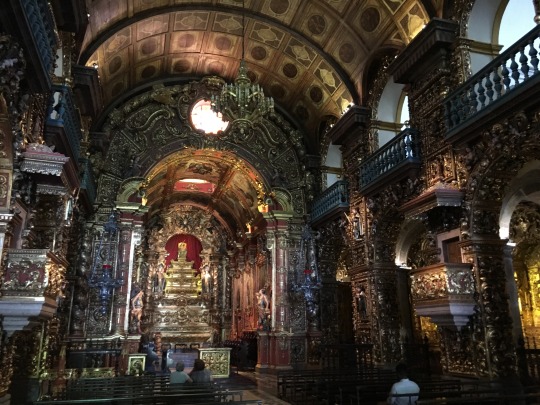
After a tasty chicken burger at the hip Cozinha Mironga I continued toward the waterfront to Igreja de Nossa Senhora Candelaria, the biggest of the city’s historic churches. The surrounding area houses lots of current and former government buildings, most of them imposing neoclassical edifices or fanciful Baroque colonial desserts (or both). I saw the Centro Cultural do Banco do Brasil (tho I skipped the current exhibition of Dreamworks art), Igreja de Nossa Senhora do Carmo da Antiga Se (which served royal functions when the Portguese throne decamped to Brazil) and Paco Imperial (the one-time royal palace). From there I walked through the extremely underwhelming (but historic) Arco de Teles into Travessa do Comercio, a charming cobblestone street of colonial townhouses, now home to outdoor cafes.
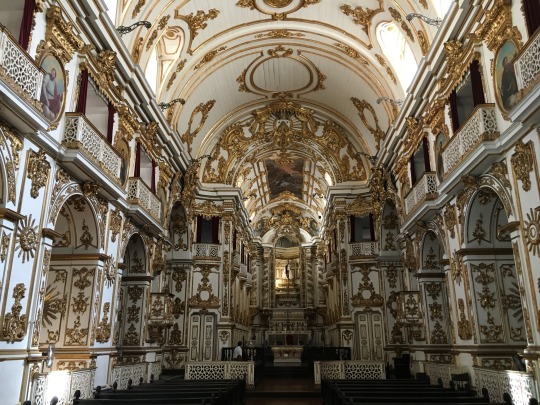
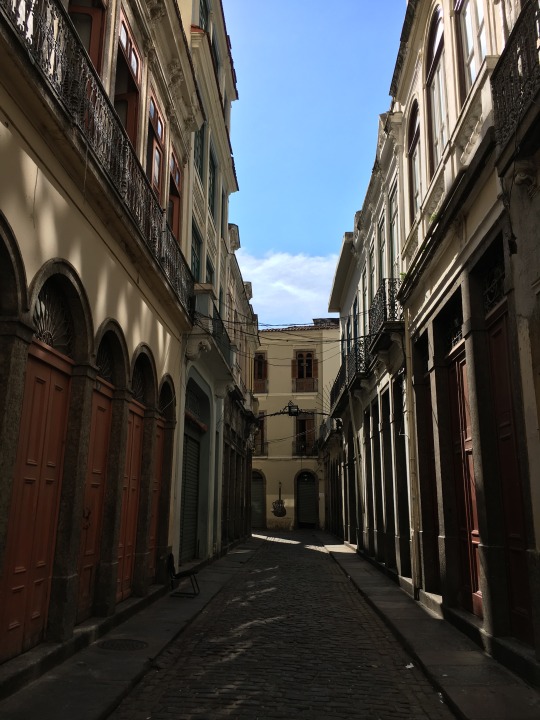
From here I cut across the hustling narrow streets of Centro to Largo da Carioca, a plaza surrounding by some atrocious 1960s skyscrapers (tho the Petrobras HQ is a marvel) and dominated by a very old church, Igreja Sao Francisco da Penitencia e Convento de Santo Antonio (phew). It’s beautifully restored and wins the gaudiest award in a very tough category. Not one inch of that chapel was left ungilded, an odd choice for an order who has taken a vow of poverty.


I then headed back up to Real Gabinete Portugues de Leitura, or the Royal Reading Room. It’s basically a library, and one of the most stunning I’ve ever seen. It’s three stories of books (over 350,000) in sumptuous but tasteful, muted decor. You can feel the knowledge surrounding you, and it makes you yearn to have more of it.
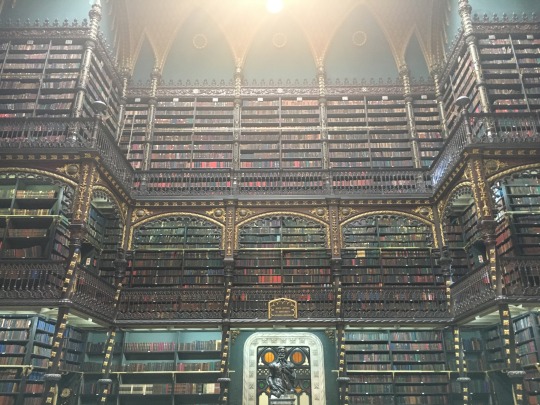
From there I veered west into Saara, a small grid of narrow streets that serves as an outdoor market and bazaar. You can probably find anything you need here and at a good price. At the end of it I found Campo de Santana, an elegant park with an odd assemblage of wild beasts-- cats, ducks, some sort of large fowl, and a cute, big rodent creature (capybara?). That was enough for one day so I headed back to Ipanema, had a big, tasty, cheap dinner at Frontera and went home to bed.
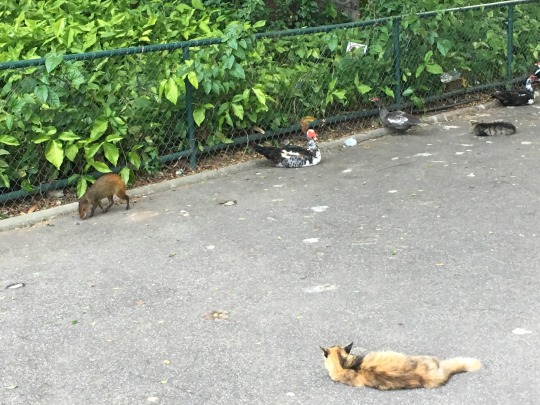
On Wednesday I headed back down to Centro to finish my tour. I started at the Museu Historico Nacional. I have a particular interest in history museums because a) I think it’s important to have some background and context when you travel; b) I’m a history nerd; and c) they are difficult to do well since good history requires a lot of text, which is not well-suited to a museum. Rio’s history museum is... decent. Housed in a well-maintained old fort, it could definitely use some refurbishing and some more engaging exhibits. After a respectable space telling the story of the indigenous people, it mostly focuses on the leaders and elites who steered the country from a Portuguese (and Dutch and French) colony into an independent republic. It has little to say about slaves, and I found no mention of the military dictatorship that ruled from the sixties to the eighties. (This is especially problematic given the current president’s favorable, revisionist view of the dictatorship.) But otherwise the narrative seems fair and accurate, if not thorough. It has almost no weighty artifacts, like original documents or “this was the actual thing that person used” items. It is mostly full of examples (of china, jewelry, slave shackles, etc.), paintings (many immense) and busts. Two awesome exceptions are a large array of carriages and early cars spanning three hundred years and an actual historic apothecary that was moved into the museum when it went out of business. I also appreciated that all of the displays had English translations tho they were riddled with errors. It made me wonder why the museum wouldn’t have them proofread before printing them up in a permanent exhibition.

From here I walked back to Praca Floriano (aka Cinelandia) which is the heart of downtown. The plaza is fairly non-descript, but it’s surrounded by some of the city’s most beautiful buildings: Theatro Municipal, Bibliolteca Nacional, Museu Nacional de Belas Artes and Camera Municipal. It was so stunning I stopped for lunch on the square and came back to see it lit up at night (when apparently the navy was attending the opera...).
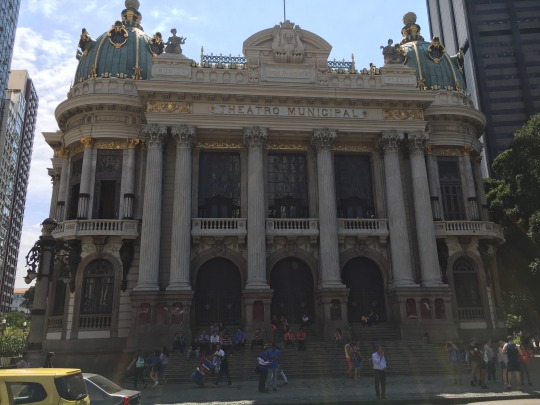
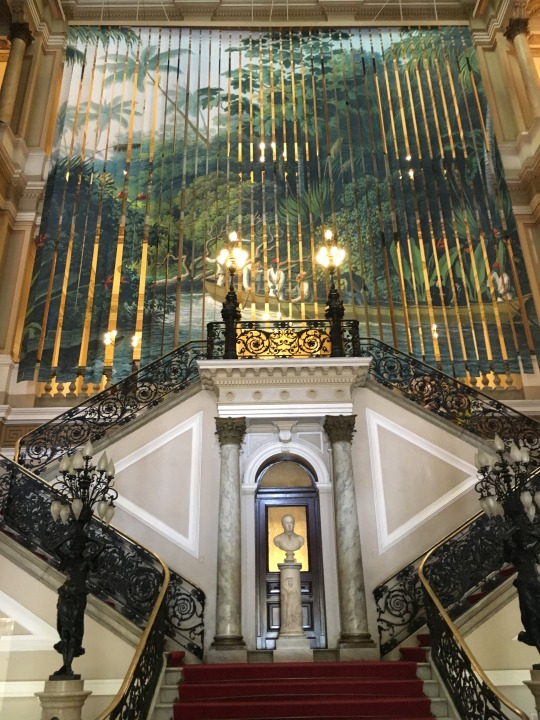


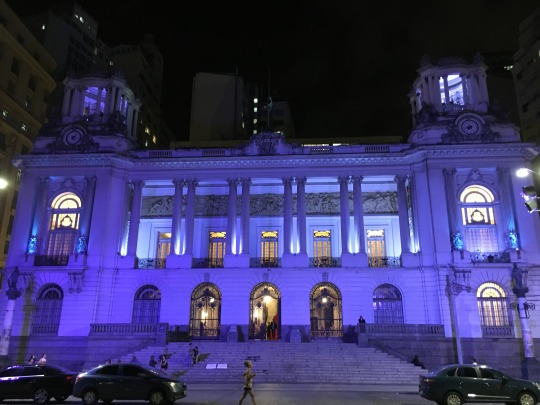
After lunch I continued west into Lapa, past the iconic Arcos (an old viaduct) and the peculiar Catedral Metropolitana de Sao Sebastio. It’s a brutalist cement cone modeled after Aztec pyramids, and it looks nothing like any church I’ve ever seen (tho not far off from St. Mary’s in San Francisco, aka “The Washing Machine”). After my initial shock and repulsion, I found it growing on me, if only for its boldness and break from tradition. It’s most famous for the tall stain-glassed windows (which are impressive in their size if not beauty), but what stood out to me was the main crucifix. It’s surprisingly small and suspended in the center of the cone about 30 feet above the altar. Jesus looks so vulnerable and alone, floating in an empty void. Of all the gory crucifixion scenes I’ve seen, this more than any other moved me and actually made me sad to think about Jesus’ plight.


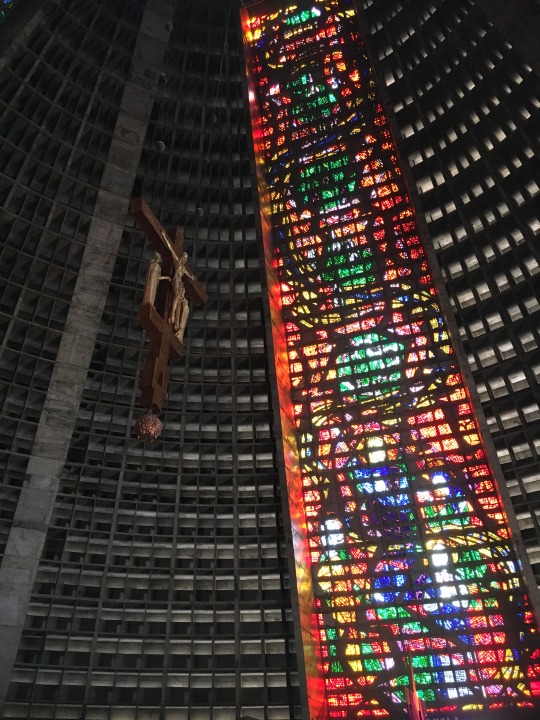
I then ventured further into Lapa. Nowadays it’s best known for its rowdy nightlife, and some of the bars were just starting to open up. Like much of Rio (and many Latin American cities), the area had traces of better days but now mostly looks decrepit. I made my way back, under the Arcos and headed to Cinelandia to catch the train home.
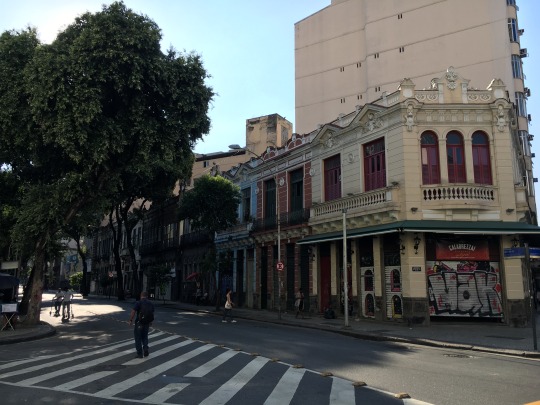
Thursday was considerably less ambitious. After a late start, I took the metro to Botafogo. Amid the usual urban grit of Rio are several beautiful old colonial mansions (as well as a notorious favela). I believe it was once an upscale artsy neighborhood that fell into decline, but some of the old buildings have been restored as museums or work spaces. Unfortunately, like so much of the city, they are hidden and inaccessible behind tall walls and fences. One beautiful exception is the Fundacao Casa de Rui Barbosa, once home to a famous writer and politician, now a museum. I didn’t go inside but the gorgeous grounds around the home are open to the public and look like a miniature botanical garden.

I made my way toward the next neighborhood, Humaita, and stopped at Cemiterio Sao Joao Batista, the final resting place for some of Brazil’s most famous residents. It’s quite beautiful and dramatic under the watchful eye of Christ the Redeemer. My last stop was Cobol do Humaita, a food market and dining hall, which are always pleasant to wander. The sun was going down so, after six days in Ipanema, I figured it was time to see the sunset on the beach. Obviously Rio faces East but the light is still nice.
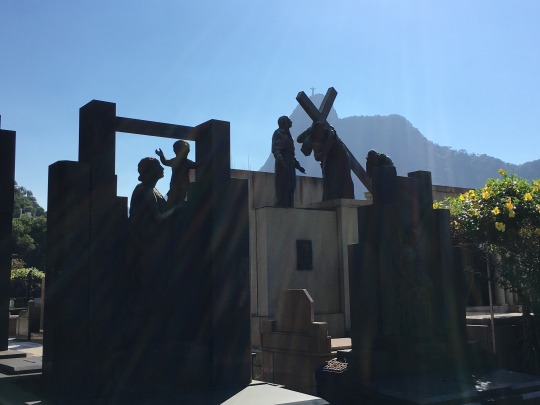
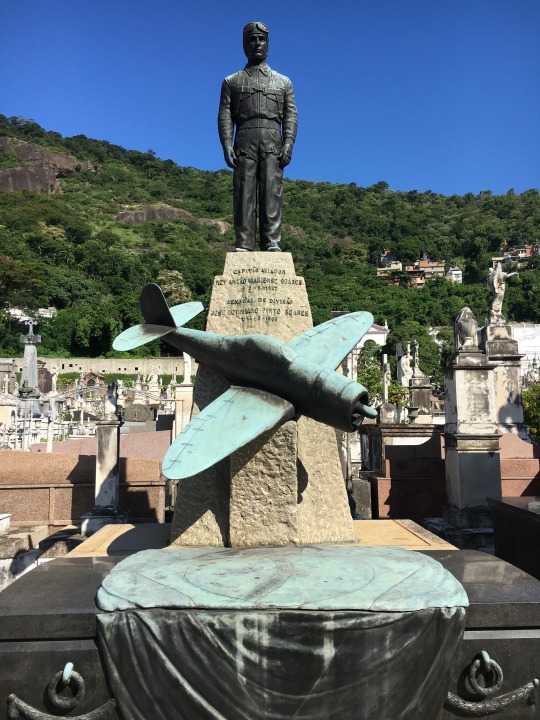

Friday turned out to be my most ambitious day and, painfully, the hottest so far. I returned to lovely Cinelandia and Lapa and visited the famous Escadaria Selaron, a public stairway that has been covered in a colorful tile mosaic in tribute to the people of Brazil. It’s pretty, fun and festive and swarming with tourists. Fortunately most people turn around at the top (if they get that far) instead of continuing into the beautiful Santa Teresa neighborhood. Like Botafogo, it’s full of charming old homes in various states of (dis)repair. But these are not walled off. And they run the gamut from cottages to palaces, so there is a lot of variety, both in architecture and culture. It reminded me of Russian Hill and Telegraph Hill. Also, this being a very steep hill, there are stunning views of the city and the bay from everywhere.

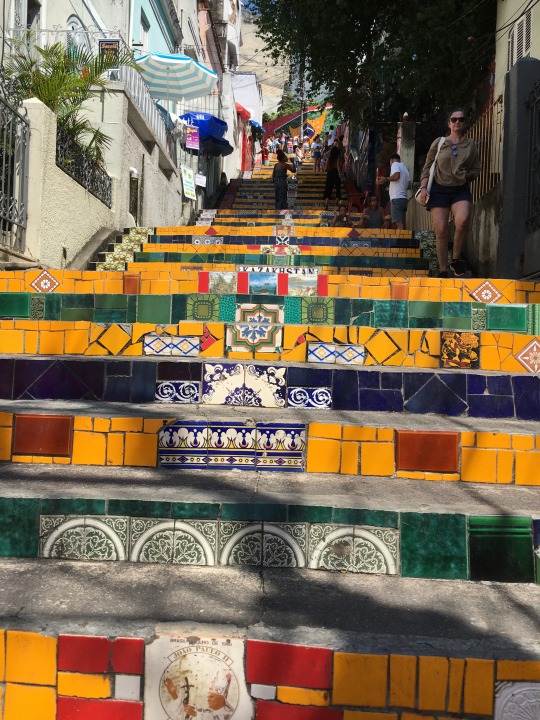
There is not much to do in Santa Teresa besides admire the loveliness, which probably helps keep the tourists away. Parque das Ruinas is the main attraction-- a crumbled mansion once owned by a salon-hosting socialite intellectual. It really feels like ruins, but staircases and walkways have been installed and the surrounding grounds turned into a park. The views from the top are spectacular. The small museum next door (Museu da Chacara do Ceu) hosts a private collection. It sounded interesting but appeared to be closed for construction.



I continued walking through the main commercial area which hosts some charming little boutiques, restaurants and bars (as well as a makeshift barber and a bar perched out on one of the viewpoints). I stopped for fantastic feijoada at Bar do Mineiro and more beer at the historic Bar do Gomes. Then, rather than walk all the way back down, I opted for the bonde, a cute little cable car that runs up and down the hill.
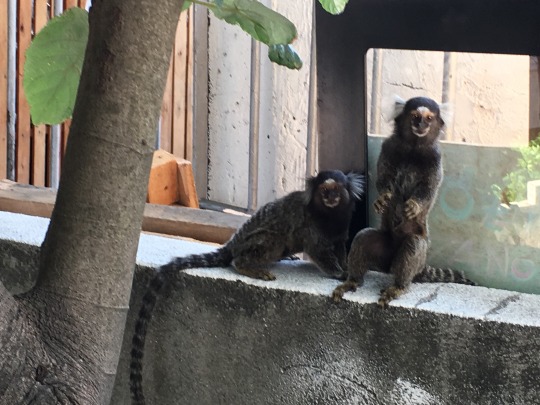


With a little daylight left, I headed back down to Botafogo and then over to Urca for one of Rio’s premiere attractions: Pao de Acucar (Sugarloaf Mountain). It stands tall at the north end of Copacabana and offers stunning views over the entire city and bay. It’s accessible by a sequence of two cable cars (gondolas), teetering at dizzying heights. It was crowded, as I expected at sunset, but not actually that bad. I stayed up there a while soaking in the “Marvelous City” and, like everyone else, taking tons of photos.


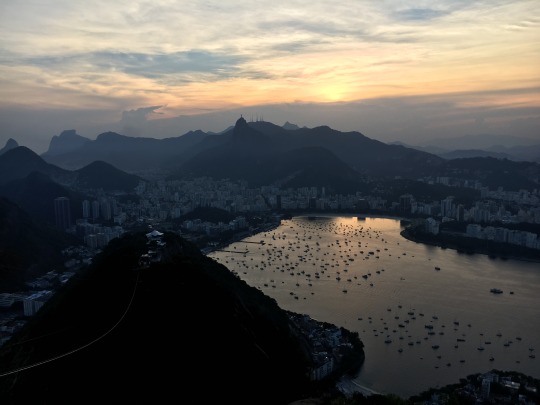
It was my first Friday night in the city, and I had nothing to do, which would have been a shame. But a guy I had been chatting with invited me to Paraiso do Tuiuti, a samba school. I demurred, concerned that I would not understand the instructions in Portuguese. But my friend then explained that it’s not a school so much as a club that performs sambas. The schools are formed in the favelas and compete at Carnaval every year. Friday night Paraiso was having a big birthday party and putting on a show for their friends.
The Paraiso clubhouse is across the street from Feira de Sao Cristovao, a kind of permanent country fair. It’s home to dozens of stalls selling all sorts of stuff, but at night, it’s mostly just restaurants and bars with a lot of karaoke. There is also a main stage with the kind of cheesy acts you would expect at a fair. And the crowd was overwhelmingly under 30, maybe 25. It was cute good times but I was not sorry to leave when my friend arrived.

The Paraiso do Tuiuti building is a big auditorium, not unlike a high school gym. A large samba band was in full swing in the corner of the mezzanine, and various people in uniforms, outfits and costumes were milling amongst the hundreds of guests. It all felt very festive, intimate and personable. A little later the performances started. My friend explained that each year at Carnaval each school performs a new samba and competes for first place (the schools are also organized like sports leagues with a top tier, mid tier, etc.). Paraiso do Tuiuti was performing their greatest hits that night in honor of their birthday (with songs going back to the 80s), and once they were done, a couple other schools-- Estacio de Sa and Mangueira (last year’s winners)-- performed as well. The whole experience was phenomenal and unforgettable-- the rhythms, the leg work, the costumes, the energy. It was a fantastic, only-in-Brazil night that a tourist can only hope to stumble upon.

Since I did not get home until 6am, Saturday and Sunday were my lazy days off before I returned to the tourist trail the next week....
1 note
·
View note
Text
Paraty, Brazil
After an amazing, unforgettable three day wedding weekend on Ilhabela, a group of eight of us (plus the grooms and some of their families and friends), drove north up Costa Verde to Paraty, an historic colonial port. At various times Paraty served as an important transit point for slaves, gold and coffee, but as these trades ended or moved away, the town was practically abandoned-- leaving it amazingly well-preserved. The result today is a charming historic center, surrounded by pristine beaches, lush tropical forests and mountains, sitting on an extensive island-filled bay. In other words: paradise.
We arrived late Monday night to discover our rental home was even more astounding than we expected-- spacious and airy with a pool and a backyard that backs against the beach, more lounge chairs, sofas and social spaces than we could possibly use and at least four hammocks. The house staff (!) had dinner waiting for us, which was perfect after an unexpectedly long wait to get off of Ilhabela.
The next day-- after a fruit-filled breakfast spread with the ocean waves lapping behind us-- we were picked up by a tour guide from Paraty Explorer and driven to the Gold Trail. This path was carved out and paved with stones hundreds of years ago by enslaved people to enable gold mined deep in the interior to be taken to the port for shipment back to Europe. It now serves as nice path to trek to experience the remaining Atlantic forest that once stretched from the coast to the Amazon. Our friendly, knowledgeable guide told us a lot about the region and the country’s history as well as explaining much of the biodiversity we were seeing. He then took as to Cachoeira do Toboga e Poco do Tarzan, a series of cascading waterfalls and swimming holes. The base of the falls features a tall, smooth, rock formation at about 45 degrees that local kids “surf”, i.e. slide down while standing upright, sometimes jumping and spinning. It was terrifying and astounding to watch. We were only allowed to slide down on our butts (not that I would have attempted to surf). At the top of the falls, across a precarious rope bridge, is… a bar! What a country. After some swimming and drinking, we walked over to Alambique Engenho D’Ouro, a traditional (tho relatively new) artesian cachaca distillery. We learned about how it’s made and what distinguishes different types of cachaca from each other and from rum, and sampled several tasty varieties. Sufficiently buzzed, we headed to lunch then back to the house for some downtime.

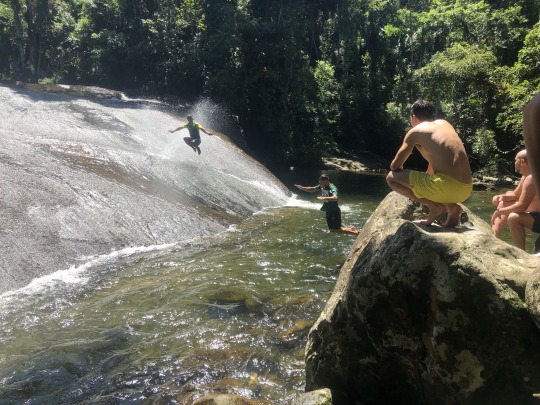


That evening we made our first foray into Paraty’s historic center. It’s a (sorta) grid on the water with charming small cobblestone streets lined with rows of one-and-two story Spanish colonial style homes with whitewashed walls and brightly-painted trims. It’s reminiscent of New Orleans’ French Quarter. The streets are something else. The original stones have been torn up and replaced many times over the past 200 years, so the surface is highly uneven. It’s difficult to admire the town’s beauty since you need to keep your eyes focused on the ground if you don’t want to sprain your ankle.
Our destination was the Academy of Cooking & Other Pleasures, a cooking school run by on older couple out of their charming home. Their focus is not on technique, but rather the food and how it reflects Brazil’s culture and history. We all had a great time, learned a lot and then enjoyed a delicious meal of our own making. It had been a long day but very fun and educational, and I think it helped all of us first-time visitors to understand and enjoy Brazil more knowing about its history.
On Wednesday we arranged for a boat tour of the bay and some of its 65 islands. This was a really fun, special day that made us all appreciate what an incredible place we were in. We puttered across the water and through the inlets, swam in lagoons and at remote beaches, ate lunch at a cliffside restaurant that’s only accessible by boat, saw some billionaires’ resplendent homes as well as some more modest ones belonging to locals, drank rosé all day and generally lived our best lives. It was exhausting so we were all happy to come home and pick at scraps for dinner. Some of us crashed early while others kept the party going a few more hours….


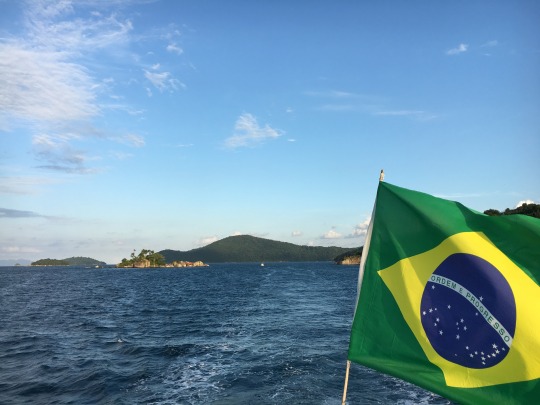
After all our hard work the last two days we took Thursday off. Had a bigger-than-usual breakfast at the house then hung out on our local beach for the day, some of us taking out the kayaks and paddle boards. Later in the afternoon we visited the beachside restaurant next door for beer and fried fish. That evening we went back to Centro for some shopping, a sample of the local specialty cocktail Jorge Amado, and an unexpectedly delicious, final meal at Banana da Terra.
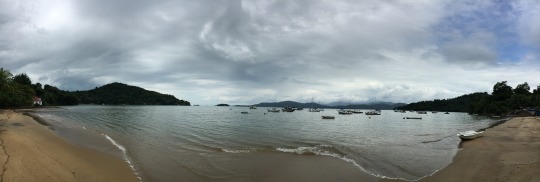
On Friday my remaining friends left for their last night in Sao Paulo leaving me alone in this big, gorgeous beachside house. I caught up on reading and writing and pondered my next step: two weeks in Rio….
0 notes
Text
São Paulo, Brasil
Back on the road again… this time, to Brazil! I had been planning to visit for the wedding of friends, but when my job ended suddenly I decided to extend my stay to six weeks. I have been fretting about that decision ever since. Brazil has a notoriously high crime rate, I don’t speak any Portuguese, and six weeks is a long time to be away from home (especially after two other multi-week trips). But it could also be a once-in-a-lifetime adventure. So we will see what happens. First stop… Sao Paulo!
My flight via Atlanta was long and bumpy but uneventful. I’m not sure if I slept but it could not have been for more than two hours after which I found myself in Sao Paulo at 8am Friday. After straining to explain myself to the doorman at my AirBnB, I left my luggage there and headed right to… the mall. Frei Caneca is known as the “gay mall” since it’s frequented by gays who even cruise there. (I did see some evidence of this but only amongst teenagers.) It’s also the nearest Claro store where I could buy a SIM card; I did not want to pay for AT&T’s international roaming options for six weeks. Once again I was completely overwhelmed by the language barrier, so I’m not sure what I got, but I did end up with a SIM card and a +55 number-- only to discover my phone was not unlocked. (After leaping through a few hurdles with AT&T and talking to a very nice rep there, they unlocked it a day later.) So far the first day was frustrating.
My errands complete (sort of) I hit the streets. I walked through my neighborhood, Consolacao, down the main drag, Rua Augusta, which has lots of restaurants, bars and boutiques. I stopped for lunch at a tapas place and was quickly disabused of two of my preconceptions about Brazil-- that it is cheap and that the food is amazing. I’m sure both of these things are true in parts, but clearly I was going to have to work harder to find them.
I continued to Avenida Paulista, the city’s main artery, lined with high-rise office buildings and, at lunch time, swarming with people. I had been warned for months about visiting Brazil-- stay alert, don’t pull out your phone, avoid strangers, etc. And yet here I discovered that midday in Sao Paulo is like any other big city (only bigger): crowds of people jostling for space, people texting into their phones without looking up or holding them and waving them around as they speak, nobody focused on much besides their companions and their next step. Despite my usual annoyance at weaving through crowds, this started to put my mind at ease. The scale and sum effect of Av. Paulista is impressive, but the individual buildings are not (I later learned this holds true across the city).
I walked down to Siqueira Campos, a lovely, surprisingly peaceful park right off this major street. It is meant to resemble the rainforest that once grew where the city stands and makes you think that if everyone suddenly left Sao Paulo it would revert to jungle in about a month. Urban parks across North America and Europe all look somewhat similar, so it was nice to visit one that felt much more localized. Across the street is the Museo de Arte de Sao Paulo, which is supposed to be one of the city’s finest. Unfortunately most of it is under renovation, and only one, subterranean gallery was open, so naturally I was underwhelmed (the ticket office did warn me and only charged half price). The museum sits atop a hill, and the viewing platform behind it provided my first glimpse at the city’s endless expanse of high-rises. (It also provided the first insight that all the public spaces in the city’s center are overwhelmed by homeless and vagrants, not unlike San Francisco, but on a scale to match the city.)

I started to loop back around through the Bela Vista neighborhood, Sao Paulo’s Little Italy. The commercial strips were dead (I think they are livelier at night when bars and restaurants open), but when I climbed a hill into a residential section, the homes and narrow streets were charming. Clearly the key to enjoying Sao Paulo would be finding pockets like these. I returned to my AirBnB to unwind and settle in. As much as I wanted to check out the Friday night happenings, I was exhausted, so I just crashed and slept for 12 hours.
Well-rested I awoke for my first full day and headed to the neighborhoods north and west of the center. I first walked to Parque Buenos Aires in the tony Higienopolis neighborhood. Then I headed up (and up) to Pacaembu which resembles Beverly Hills (even down to several faux English Tudor mansions). But unlike the 90210, these homes are heavily fortified behind tall walls and electrified wire, so it’s hard to get a good look at them. I then found myself near Praca Benedito Calixto which hosts a lively flea market on Saturdays. (The cross-street, Rua Teodoro Sampaio, is strangely full of over a dozen musical instrument stores; I’ve never heard of a shopping district for instruments.) I’m not big on flea markets but I was impressed at the expansive selection. You could find just about any household object made before 1980. There was some delicious-smelling food stalls and some live music as well.
Then it was on to Vila Madalena, a once artsy, bohemian enclave that is now full of tourists. It’s like the Mission District in another way too: it’s known for its street art, particularly a mural-covered alley called Beco do Batman. Some of the works there are remarkable; others more a pretty array of shapes and colors. I especially liked how many incorporate Batman and other superheroes. On this Saturday afternoon it was full of tourists and Instagrammers, as you would expect.

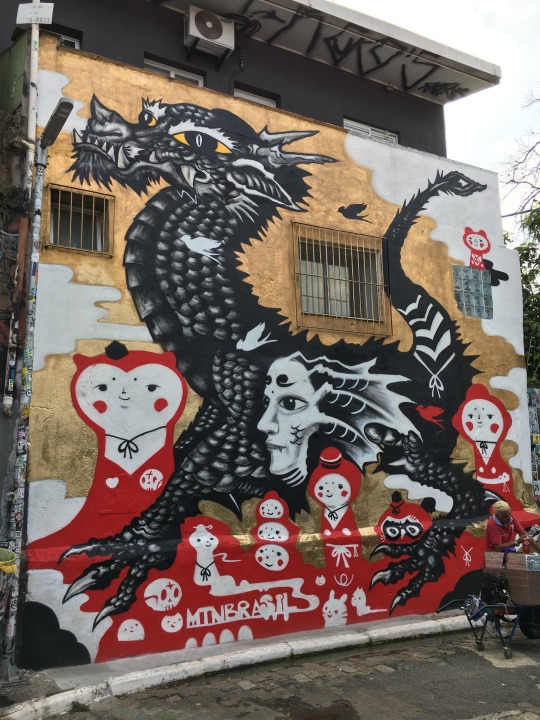

From here I walked south through the Pinheiros neighborhood. I think this used to be a trendy destination, but that seems to have moved north to Madalena, so this area struck me as more laid-back but still full of activity. I carried on into the Jardins district to a standout church, Igreja Nossa Senhora do Brasil. Unfortunately it was closed for a wedding, but the outside was lovely even if, like so much else in Sao Paulo, it’s a relatively new construction meant to look much more storied. The Jardins area is a fancy part of town, and I walked all the way home up a main shopping artery, Rua Augusta. In all I walked 10 miles on Saturday, so I was much too tired to go out that night.


Sunday was my day of rest, sort of. I met up with Will and Rafa, my friends whose wedding brought me to Brazil. We had brunch with some of their friends then hung out at their swanky AirBnB all afternoon as other friends came and went, among them Scott and Tony. The three of us went out to some gay bars later which was disappointing. Eventually we got to Igrejinha Bar, a mostly gay bar in what might have once been a chapel (it was certainly decorated like one). It was a nice little place with a lot of character. I like when gay bars have something to offer besides being gay.
On Monday, Scott, Tony and I hoofed across Centro, the heart of the city. It was a lengthy walk taking in all the most notable sites: the distinctively serpentine Edificio Copan (draped for construction unfortunately); the confectionary Theatro Municipal; the decaying Igrejas de Santo Antonio and de San Francisco; the slum-like Praca de Se and its Romanesque imposter Catedral, the charming Central Cultural Banco; the Empire-State-esque Edificio Altino Arantes/Banespa; the truly lovely Edificio Martinelli (the city’s first “skyscraper” from 1929); and several other historic buildings interspersed with other Beaux Arts and Art Deco gems, bland constructions and outright slums. We also took a detour to Mercado Municipal (through a very lively area that seemed more typical of poorer Latin American cities). The market is housed in a massive, beautiful belle-epoque warehouse (featuring some fabulous stained glass windows) and is alive with sellers of produce, meat, fish, wine, spices and everything else edible. The only downside was the supposedly legendary mortadella sandwich at Bar do Mane which did not seem to contain real mortadella, cheese or bread.
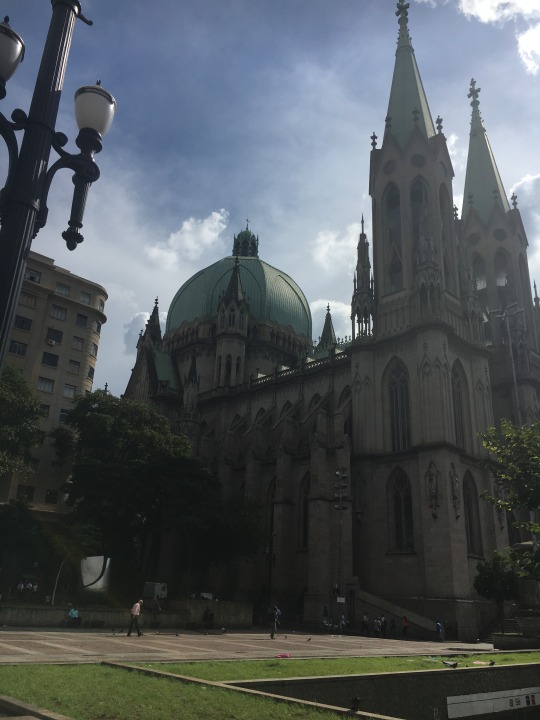
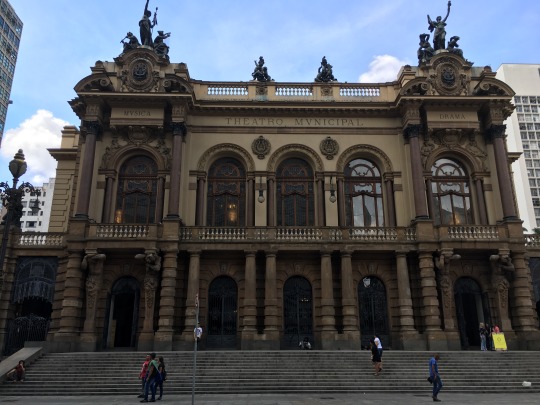

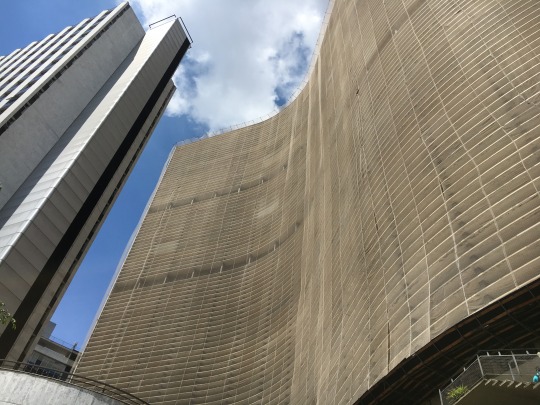
We ended our walking tour at Edificio Italia, an historic skyscraper that is still the tallest in Centro. Its 47th, uppermost floor hosts a restaurant and a wrap around terrace offering 360 views of the city. Our jaws dropped at the endless sprawl-- high-rises (mostly bland and generic) spreading out as far as you can see in every direction. I could not possibly fathom how many people live in this city nor how it even functions, having never even had a central plan. As Will said, it’s Manhattan density with LA sprawl. And I would add it lacks the redeeming charms and beauty of either city, tho it certainly has a vibrancy that seems to pull people here and propel the city forward.
On Tuesday I was back on my own so I caught a ride to Parque Ibirapuera, the city’s largest. It’s a beautifully designed park, full of lakes, flowers, trees and views of the endless skyline. It’s perhaps most notable for the many pavilions and buildings within, most designed in the modernist style by Oscar Niemeyer (and connected by a covered serpentine walkway, a hallmark of his style). As with most Niemeyer buildings, the look has not aged well, and these buildings have not been well-maintained so, as with much of older Sao Paulo, the look is one of faded glory.
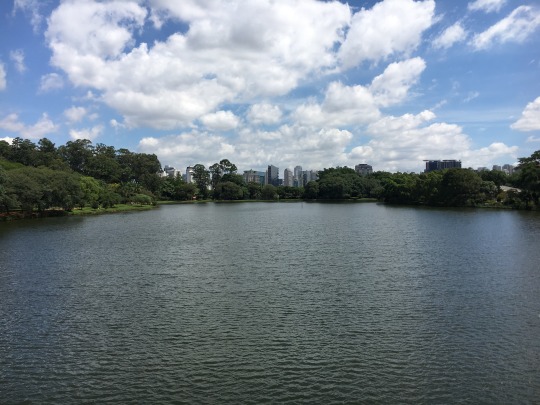

I first visited the Museu Afro Brasil, which is dedicated to the country’s African history and culture (Brazil imported up to 5 million slaves, ten times as many as the US). The museum could use some refurbishing, but the collection is stunning for its size and breadth. Spread across three floors there are well over 10,000 items including paintings (old and recent), photographs, newspapers, clothes, tools, religious paraphernalia, jewelry, pottery, handicrafts, musical instruments, etc. The arrangement is somewhat scattershot, but that means you are treated to something new and unexpected at every turn. Unfortunately all but two of the displays are in Portuguese so I had no idea what I was looking at nor any context. It was interesting to walk through and take in tho.
My next stop was the small but enjoyable Museum of Modern Art. It only had two exhibitions of very modern art (in fact one was for recent acquisitions) but they convey an active, thoughtful, varied art scene in Brazil today. The underlying message seemed to be that artistic expression and dissent are as important as ever under their new president. The museum also has a nice sculpture garden in front surrounding a pavilion venue that looks like a UFO that might have visited the Flintstones.
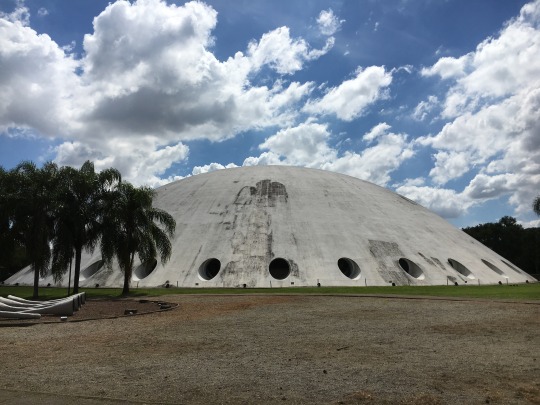
Across the street from the park is Museu de Arte Contemporanea, which belongs to the local Universidad. It’s an admirably large building with a sizable collection (including some non-Brazilian stars, like Picasso and Brancusi) and numerous exhibitions. I first visited the top (eighth floor) terrace which affords 360 degree views of the surrounding park and city. Once again, a sea of high-rises unfolded in every direction, and I couldn’t even see the tall buildings I had been exploring in Centro the day before. I wandered around the galleries but was losing patience and energy so I did not linger long before heading home. I just relaxed that afternoon before having dinner with Tony and Scott at Jiquitaia, a very well-regarded (even by Michelin), affordably prix-fixe Brazilian restaurant. Based on our experience I’m guessing it was losing its luster.

For my last full day I took the (surprisingly clean, modern) metro to Pinacoteca do Estado, a long-established art museum and definitely my favorite of the bunch. The historic brick building has been renovated to create bright interior courtyards lined with-- and criss-crossed by-- walkways, filled with sculptures and surrounded by galleries. The second floor displays historic Brazilian art, initially foreigners painting the new colony, then Brazilians visiting Europe, then Brazilians painting their own country. It’s not a huge collection, but the technical mastery is astounding and the range of subjects wide, from cowboys to slaves to harbors to jungle to natives to aristocracy to farms to historic scenes and everything else that went into the nation’s creation. The second floor displays 20th century art, with a strong collection of pop, modernist and abstract expressionist paintings. Here the subject switches from scenes of Brazil to the artists’ questioning what the Brazilian identity is, which was a common theme at the other modern and contemporary museums I visited. It’s an endlessly fascinating subject as it’s such a huge country made up of a huge variety of environments, cultures and people of innumerable backgrounds (who were mostly immigrants and often in conflict with each other), ruled by multiple empires and many types of home governments. It’s similar to the US in many respects, but we have always been able to turn to our Constitution and founding mythologies to define our identity (tho of course we argue about what that means today). For Brazilians it’s an unanswerable question but a fascinating one to ask.



From there I rode the metro to the Liberdade neighborhood, the traditional Japanese center, tho recent immigrants are mostly Chinese and Korean. (Sao Paulo has the world’s biggest Japense population outside Japan.) It’s nothing special, especially compared to San Francisco, New York and LA. But it’s kinda cute to see that familiar pan-Asian environment (markets, restaurants, lanterns, tchotchke shops, etc.) only with Latin American characteristics.
On my final night I took it easy to save my energy for four days on Ilhabela where Will and Rafa would be exchanging vows. And I bought extra insect repellent because apparently the mosquitos on the island are legendary.
1 note
·
View note
Text
Louisville, Kentucky
After a great four days in Nashville with some close friends, I got back on I-65 and headed north to Louisville, a city I have always heard good things about. Kentucky is a confused state. Originally part of Virginia, it was one of the three slave states that stayed part of the Union during the Civil War (tho its citizens remained deeply divided) so the Emancipation Proclamation didn’t apply there. Politically and culturally most would recognize it today as a Southern state, but more than most states, Kentucky has developed a distinct personality that it hews closely to.
My first stop was at Mammoth Caves National Park, the longest cave system on Earth (412 miles discovered so far and counting). To get anywhere interesting you need to join a guided tour, which I’m generally loath to do. I signed up for the two hour Domes and Dripstones tour which was pretty incredible. It goes through dripping wet limestone formations through large sandstone caverns past bulbous, massive stalactites, stalagmite and columns. And yes I certainly learned more with the guide there, but I still don’t like having to stick to someone else’s pace.

From there I drove on to Louisville and checked in to my AirBnB. I didn’t do much that night as I settled in.
The next day I drove downtown where most of the attractions are. I hadn’t eaten so I ended up at Proof, the restaurant in 21c, a unique “Museum Hotel” (more on that later). It was a beautiful restaurant covered in art (literally-- even the wallpaper was designed by artists). In the bar area the exhibit was reclaimed queer art, so lots of old pin-ups, drag queens, candid bar pics, etc. It was kind of funny to watch business people who were just staying at the hotel drag their wheelie suitcases in and out. Whether they noticed the gayness around them I couldn’t tell.
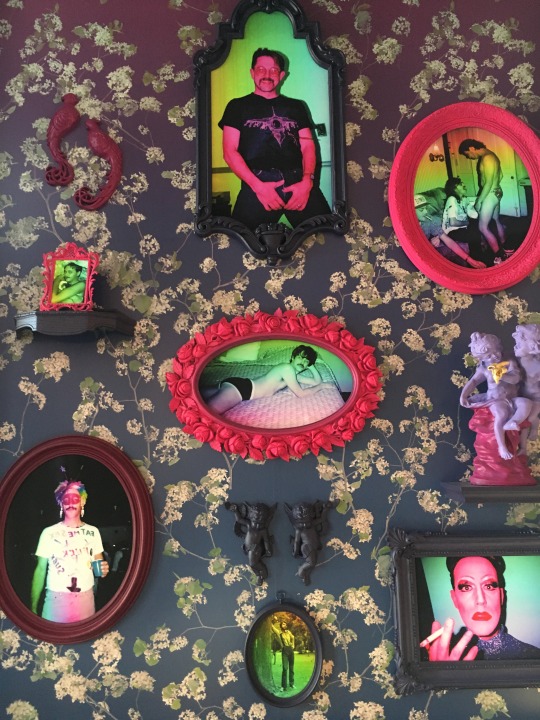
Then I walked to the Louisville Slugger Museum and Factory, where the eponymous (and ubiquitous) baseball bats have been produced for 100+ years. The factory tour was fun (until the very end where you watch a video that’s just a commercial for a personalized bat they will make you). The history of the baseball bat is a bit dry, but combined with a little baseball history it starts to get interesting. The attached museum is more of the same, and you’d need to be really interested in bats to spend any time there. I think the highlight really is the giant bat outside the building.
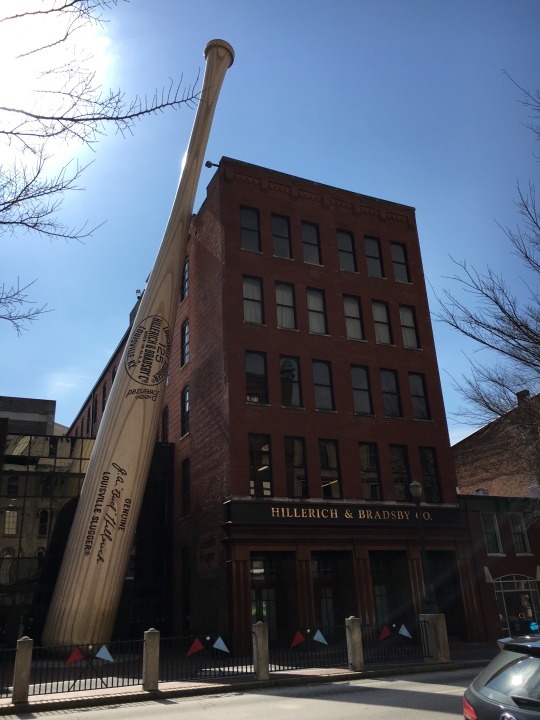
From here I crossed the street to go to The Frazier History Museum, a real hodge-podge of a collection. Partly aimed at adults, partly at kinds, partly a Kentucky history, partly a showcase for some private collections, it manages to pull all this off-- barely. The top floor is the best part: a history of bourbon and description of how it’s made (oddly this seems aimed at both adults and kids). We also learn here that the stacked stone perimeter wall (think the end of The Shawshank Redemption) is a Kentucky invention-- to delineate property lines they used the abundant limestones that they had cleared off their plots. The rest of the museum is kind of random. One part is an exhibition on Lewis & Clark for kids. Then there is a massive collection of miniatures that once belonged to one of the museum founders. And then the rest is a half-ass history of Kentucky with an odd focus on antique firearms (odd until you learn that Mr. Frazier collected antique firearms after losing his grandfather’s Civil War rifle in a hurricane). It’s interesting but incomplete. I think that, given the limitations of the collection, the curators might have tried to present it more purposefully, rather than just loosely assembling a state history.

I then walked back to 21c to get a better look at the exhibit (which starts in the hotel lobby): “Dress Up, Speak Up: Costume and Confrontation”. It features artists essentially “re-dressing” classic, established art to make comments on the past and present. Some really stunning collections in a really special place. I’ve never seen anything like 21c, and I’m surprised the concept hasn’t been emulated more widely. Louisville is lucky to have it. And to underline their subversive artistic credentials, they’ve installed a golden David in front.
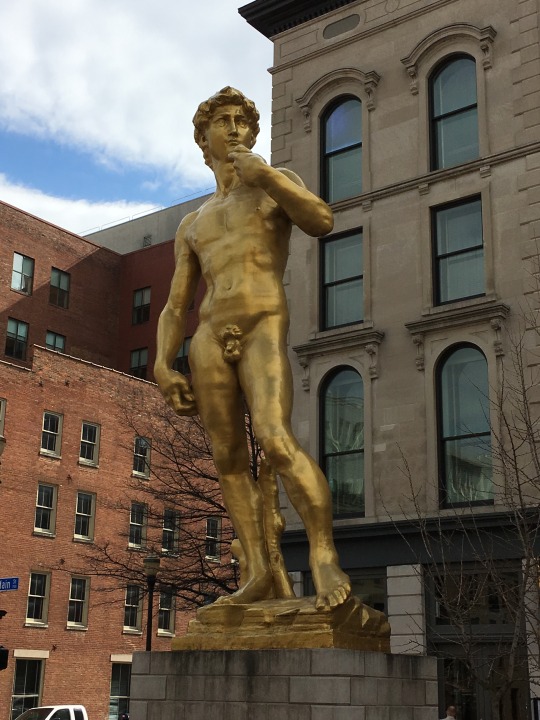

From here I continued my walk down Main Street. The modern buildings are blah, but there are a lot of beautiful, well-preserved old buildings from Louisville’s early days at the end of the 19th century. They are classic brick and Romanesque, which makes the city look more Northern. The downtown reminds me of Milwaukee (must be all those early German settlers), but overall the city’s look is similar to St. Louis-- somewhere between Southern and Midwestern and distinctly blue collar. It’s not the most attractive place but some bits of it, particularly the historic buildings, are really spectacular. Main Street parallels the Ohio River, so I popped over to the riverfront. (I later learned that the other side of the river is Indiana!) Like so many of these formerly industrial cities, the riverfront is wasted (although Louisville has restored one section into a park which I did not visit). The river is lined with highways, parking lots and dead space, and once you get to the river, the view of rusting steel bridges and flat swamp lands is less than inspiring.


My final stop was the Old Forester distillery. Main Street was once home to nearly 100 bourbon distilleries (hence its nickname: Whiskey Row) but none survived Prohibition. (Old Forester actually stayed open since it won a medical exception tho it moved off Main Street.) They recently revived their corporate headquarters and converted it back into a distillery, open for tours and tastings. (Most bourbon makers are located outside the city on the “Bourbon Trail” tho many have tasting rooms in town.) The hour-long guided tour explains how bourbon is made and of course why Old Forester is the best. It was very interesting and very slickly produced. It begins with an “introductory” video which is really just an ad (inspirational with a gravely voiceover, like you’d see during the Superbowl). The entire distillery was clearly designed with tourists in mind: the elevator rides next to the three story still, barrel making happens in a circular room which can be easily traced (they let visitors press the button to singe the barrel!), and even the signage font is on-brand. Despite (or because of) the inauthentic pandering, it’s still very enjoyable and informative. Plus you get to taste three bourbons at the end, which really highlights how much variety can still be achieved within a process that is pretty strictly defined.


That night I was relieved to find a vegan restaurant, V-Grits, down the block from my AirBnB. It’s Southern vegan tho with an emphasis on mac-n-cheese, so it was heavier than I wanted but still tasty. That night I checked out a local gay bar, The Chill Bar, since they were having an underwear night. Not many people but they were all very friendly, especially the owners who kept buying me drinks.
The next day I drove over to Louisville’s most famous site, Churchill Downs, home to the Kentucky Derby for all its 144 years. This too requires a guided tour, and it too starts with a video. The video is shown on a 360-degree oval of screens (meant to mimic the racetrack), and it is truly adrenalin pumping. The tour is just thirty minutes, but was fun and interesting. While learning the history of the event you can see the paddocks (where the horses are staged before the race) and the track itself, as well as, of course, the famous steeple tours. The attached museum is only for the truly dedicated but I liked that they had features on Derby Day outfits (especially the hats) and mint julep cups. I don’t care at all about horse racing, but I like the history and culture, and I have to respect a sporting event that puts so much emphasis on spectators’ outfits and cocktails. Plus they have a horse and pony on view.
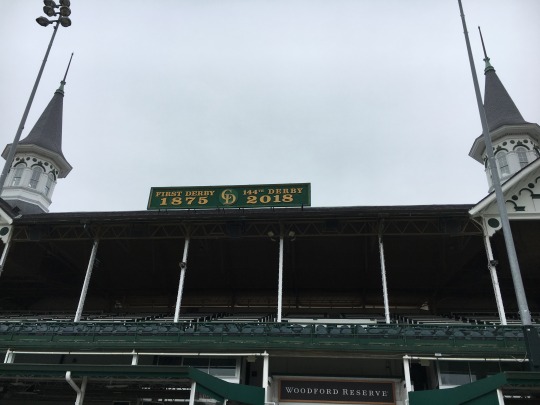

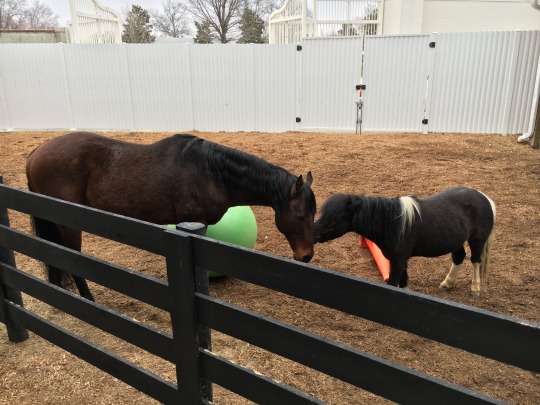
I then drove to the nearby Speed Art Museum, taking a brief detour to check out the University of Louisville campus (like the rest of the city, it has some beautiful historic buildings and some very unattractive modern ones). The museum is impressive for Louisville and very well curated. They have one large Kentucky section that includes paintings, furniture, tapestry, folk art and more. Besides some small African, Asian and Native American sections, the rest is mostly European and American. The curators understand the limits of the collection so rather than try to dazzle, they use what they have to teach about art history and art appreciation. They seem to have fun with it too (one caption about grand tours reads “What Happens In Venice Stays In Venice”). Unfortunately the section I probably would have liked best, Modern & Contemporary Art, was closed for renovations (a recurring theme on this trip). And the buildings, a stately neoclassical masterpiece with an exquisite modern glass addition, work surprisingly well together.


From here I went to Royal’s Hot Chicken since my foodie friends in Nashville didn’t want to get any. It was good tho odd since it’s served as tenders, not bone-in chicken. The surrounding neighborhood (I think it’s called Butchertown) looked pretty cool and hip, but it was freezing and raining so I decided not to walk around. That night I stayed in and got some much needed sleep.
For the last full day of my road trip I hit the road again. I drove south to Bardstown, the capital of Bourbon country (and apparently America’s most beautiful small town). It is indeed a charming town, at least in the center (like so many of America’s small towns the charm dissipates after a half-mile from the center). The middle of town is a roundabout with the old court house in the center, a beautiful Gothic/Romanesque tower. It’s surrounded by colonial-era taverns, B&Bs, etc. that look right out of Williamsburg. And the main drag is lined with two story brick Federal-style structures with a pioneer town feel. Small and cutesy but definitely charming with some serious historic chops.



From here I picked up the Bluegrass Parkway. I expected a quaint country road passing grazing horses and pastures of corn (for the bourbon). In truth it’s a 70 MPH thoroughfare, tho the surroundings are beautiful: rolling hills, farm houses, quaint ponds, barren trees and a few horses. Unfortunately it was a grey, cold, wet day in the middle of winter, so the scenery was understated. But the blue-grey of the overcast clouds illuminated the surrounding bluegrass and cast a steely hue on everything. I turned north before Lexington, skirted the edge of Frankfort then headed back to Louisville. For my last big meal of the trip I thought BBQ would be a fitting choice, and Martin’s BBQ near my AirBnB did not disappoint.
Since it was my last night in town and the last night of my trip, I figured I would go out. I hit the gay bar trifecta in the Highlands: Big Bar (it’s really small, haha), Nowhere (more mixed than gay) and The Chill Bar where I had gone the other night. That was definitely my favorite and as the guys were friendliest.
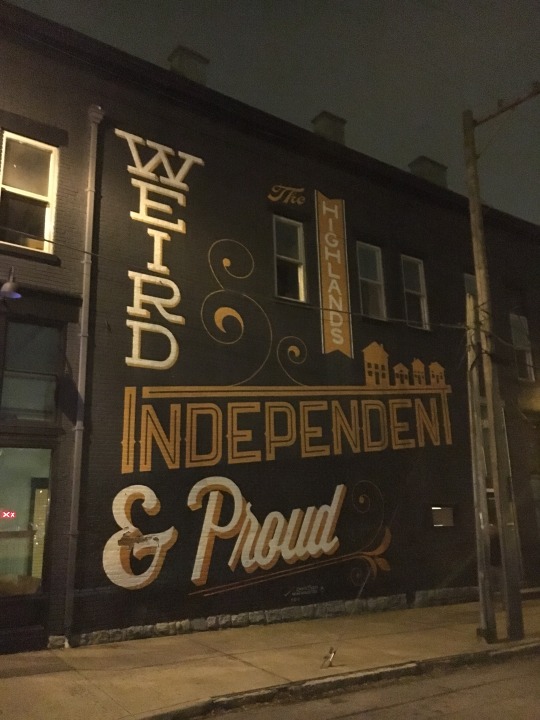
On my final day I had a few hours to kill so I headed to the Old Louisville neighborhood. The land had been cleared for the city’s International Exposition in the 1880s and then quickly became the ritziest neighborhood, home to barons of tobacco, bourbon, shipping and other trades. It surrounds Central Park, designed by Frderick Law Olmstead (who apparently designed many other parks in the city). The homes are beautifully preserved and display a wide variety of architectural styles that were popular in the early 20th century: Romanesque, Beaux Arts, Neoclassical, Tudor and more (and often an “eclectic” mish-mash of multiple styles). This surely is one of the most beautiful historic neighborhoods in the US.
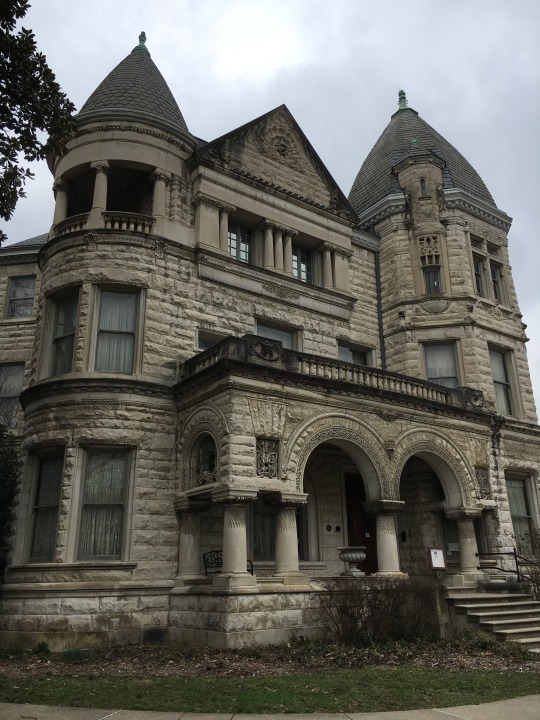
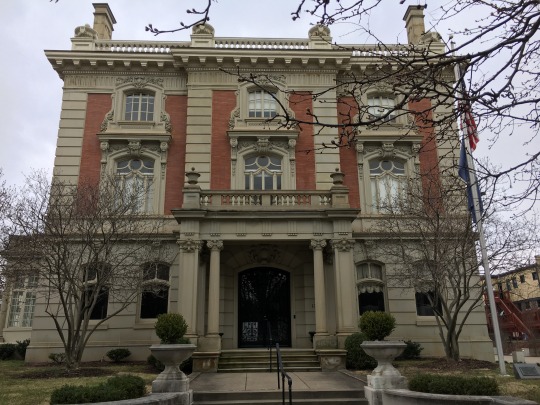
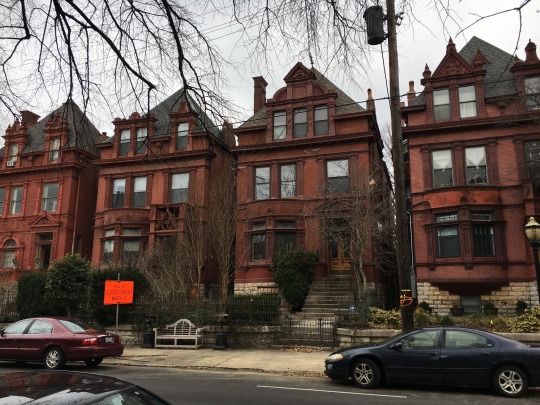
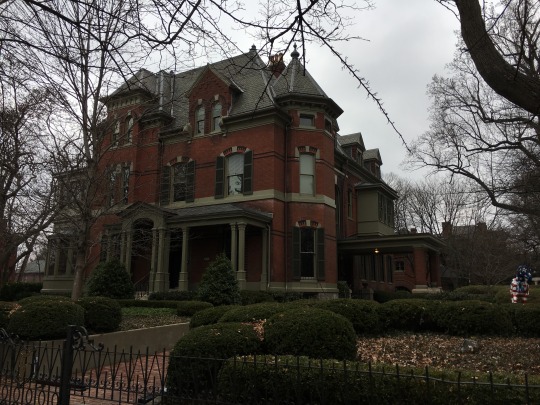
Finally it was off to the airport and the end of my trip. The airport is close to the city so I had an excellent view as we took off. Once again it was a grey overcast day, and as the plane ascended into the clouds, the city gradually faded from view. It was a cinematic finale to my trip.
A couple final thoughts…
I only saw a couple Confederate flags and Trump signs (and let’s face it, they’re basically the same thing). I didn’t see a lot of overt religiosity either. I didn’t see much on my last road trip in the South but it was even less this time. Now these are obviously states that voted overwhelmingly for Trump, so I think the lack of signage reflects the lack of support and enthusiasm for the president who has proved so spectacularly corrupt and incompetent.
Living in San Francisco it’s easy to forget that other places have seasons. I figured the South would be mild in February, but I hit some wet and cold weather. No wonder there is a high season for tourists, and this ain’t it. And the weather isn’t the only downside. Many sites take advantage of the downtime to renovate and rotate exhibitions. (Even The Chill Bar did not have their promised go-go boys, as they’re currently auditioning new ones.) The lack of crowds kind of made up for it tho.
My road trip could be trying at times-- long drives, loneliness, fatigue, constant packing and moving, ever-changing accommodations of varying quality, and some unfortunate food choices. I certainly felt older and less adventurous than on my last road trip six years ago, tho this probably kept me from being too reckless. But overall it was an incredible experience. I saw so much of my country, visited many new places, learned a lot about our history and culture, tried new things and felt-- for once-- that I was truly living my best life. Although I did not exercise or study Portuguese as much as I wanted, I accomplished my other intentions of expanding my worldview. It’s funny that before and even during the trip I was apprehensive, not sure I was up to it. And yet I not only did it, I did it by myself and I did it well. I think I’m getting more fearful as I get older, and this was an important lesson about confronting my fears head-on to conquer them. Now I have to bear that in mind as I’m extremely nervous about spending six weeks in Brazil….
0 notes
Text
Memphis, Tennessee
My first night in Memphis I settled into my AirBnB-- a large ground floor of a duplex decked out in music-related imagery, furniture and knick-knacks-- then drove downtown for a late dinner at Belle Tavern, a newish upscale Southern restaurant and bar. The restaurant was closed (which saved me some money) so I ate off the bar menu and chatted with the friendly staff. That night I enjoyed the biggest, longest thunderstorm I’ve ever witnessed-- from the comfort of my bed.
On my last visit to Memphis I did most of the interesting things here so I decided to use this time to catch up on this blog, The Economist, my Portuguese lessons, travel planning and exercise. On my first day I finally left at 1pm and headed to Gus’s for their world-famous friend chicken. It does not disappoint. Then I headed to the National Civil Rights Museum which I had been sad to miss last time.
It’s housed in the former Lorraine Motel, where Dr. King was shot. When it opened in 1991 it was the country’s first civil rights museum (and it’s affiliated with the Smithsonian, which is how it became “National”). The museums I had just seen in Birmingham and Jackson are considerably newer and are in states that witnessed a lot more action in the struggle. (Tennessee was also a Jim Crow state but its racists were apparently less murderous.) The experience is heavy from the start. As you approach the highly recognizable motel, you see a wreath hanging on the balcony where Dr. King was felled. A plaque then directs your eyes to a run-down brick building across the street and the window in the former boarding house from which James Earl Ray fired the bullet (allegedly-- more on that later). After a deep breath, I entered the building.


This museum stands out from the others I visited in two main ways. First its focus is national, not on a specific state. Second, it’s arranged not chronologically but episodically. So after introductory sections on slavery, Plessy and Jim Crow, each room tells the story of a notable episode during the struggle: Brown, Rosa Parks, Freedom Rides, Bombingham, lunch counter sit-ins, March on Washington, etc. At first I didn’t like this, as I thought, one, it would glamorize certain people and events while ignoring the “foot soldiers; and two, the historical timeline would become confused thus lessening the impact. The first concern was unfounded as the display were extremely detailed and thorough. And the non-sequential approach ends up also having merits; visitors can fully immerse themselves in the parts without getting lost trying to piece them together. The only problem is the crowds (which a sign in the lobby warned about). I ended up sandwiched between a tour group and a high school group and so scurried through some areas I would have liked to explore more. In part the museum design is to blame-- it’s confined to the original small structure of the Lorraine-- and in part it’s because addresses a popular, important subject, so the crowds are a good thing.
The museum also ends the story in a novel way. The passage of the Voting Rights Act is the first ending, but there are several codas. First, visitors enter the recreated rooms of the hotel where Dr. King was staying, and a window reveals the balcony as well as a view of the assassin’s building across the street. It’s very powerful. Following coverage of the immediate aftermath of his death, the displays then turn to the Black Power and Afro-centrism movements of the lates 1960s and early 70s, followed by the enduring legacy of the Civil Rights Movement. I think it’s inspired to point out that even tho the concept of Black Power doesn’t sit as comfortably with many whites as Dr. King’s non-violent resistance, it’s an equally important part of the same struggle. This museum also highlights throughout the many inequalities that blacks still face, such as the way most cities and schools are still segregated and the black political representation is still short of its potential.
And then things get really interesting... Across the street, in the boarding house where the assassin’s bullet came from, a newish wing examines the manhunt and trial that put Ray in jail (and displays the purported rifle). It then details the controversy that has surrounded the assassination ever since: the idea that Ray didn’t do it, that he didn’t do it alone and/or that he acted at someone else’s behest. Three separate commissions looked at the evidence, including the Justice Department and FBI in 1999 and 2000, and these displays very carefully and thoroughly present their findings. These investigations debunked some theories, but they raise A LOT of questions, and visitors are left to draw their own conclusions. Ultimately the more recent commissions decided Ray probably acted alone (tho they deemed a lot of witnesses, police and prosecutors unreliable) but he probably expected payment. From whom is unknown; the suspect list is quite long. It’s rare that a museum (especially a National one) would treat “conspiracy” theories so thoroughly and with such gravitas-- and not really try to dispel the conspiracy. Imagine the Kennedy Presidential Library doing that. I believe this reflexes the belief of some of the King family that Ray did not act alone and their attempt to uncover the truth.
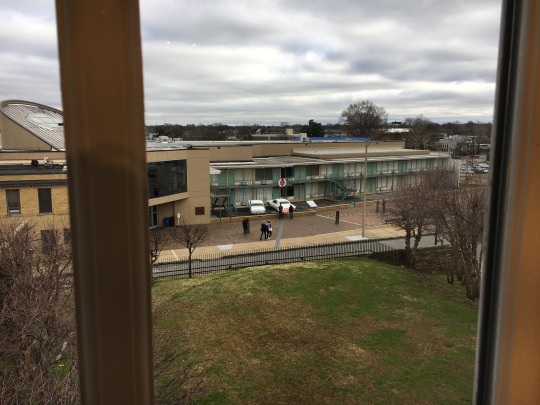
All that mystery made me hungry again so I ate at nearby Central BBQ which was obviously delicious. Then it was home for more catch up. For dinner I was craving something non-Southern so I went to Los Comelos. I thought it was a nice-ish Mexican restaurant, but it turns out to be a local family chain. Food was tasty enough tho. Then it was over to the Pumping Station for some drinks and conversation before bed.
On Thursday I woke up and headed to nearby Cooper-Young for breakfast. The neighborhood was not as happening as I thought it would be so I drove north up Cooper Street (Midtown’s main drag) to a good ol’ diner called Barksdale. After a cheap, basic, tasty breakfast, I continued north to the Overton Park neighborhood which was much more bustling than Cooper-Young. I drove in and around the park to peep some of the shmanciest homes in the city.
I then drove to Stax Museum of American Soul, the legendary studio that produced some of the biggest, best soul acts of the late 60s and early 70s. The 20 minute film that starts the tour really tells you everything you need to know, but the following displays go into much greater detail. I appreciated how they taught musical history, describing the sources of various influences like gospel, country and blues and how these all converged in Memphis. The museum also seeks to tell a broader story of black music, so it also features contemporaries and followers like Motown, Mussel Shoals, funk and disco and fairly give credit (and blame) where it’s due. The artifacts are numerous but not all that impressive-- mainly records and covers along with some clothes. (One big exception is Isaac Hayes’ gold trimmed, fur lined Cadillac with TV and fridge accompanied by a video of him describing how awesome it was.) The best part of course is the music and videos. The Stax story, like so many in the music industry, ends sadly and in bankruptcy. In fact it’s only in the fine print at the end that we learn the original building was torn down in the 80s and the current one is a recreation. That feels like kind of a gyp, but overall it’s a good experience and a good lesson in music history.
The rain returned that night so I just walked to the closet bar/restaurant, Young Avenue Deli. Seemed like a fun place (with a stage!). As I was leaving, trivia night was beginning. The first question was “What two countries share land borders with Sweden?” Is that what passes for trivia in Memphis?! On the way home I stopped for beer at the very friendly Hammer & Ale bar/store.
The next morning I set out for Nashville. I had planned to take the Natchez Trace Parkway most of the way since it’s a lovely, historic road. But it was raining across the entire state so I opted for the I-40 straight shot. Driving for three hours in rain was hellish, and the road was surprisingly crowded and torn up and the drivers pretty incompetent and/or inconsiderate (especially the truckers). But the scenery was pretty, especially the second half. I must have passed at least 20 state parks full of fall-colored forests, as well as some lovely water ways and charming farm houses. It almost made of for the misery of the drive.
2 notes
·
View notes
Text
Jackson, Mississippi
After a very fun Mardi Gras weekend in New Orleans (sorry, no blog entry for that), I hit the road again Monday morning for a brief stop in Jackson, Mississippi. On my last road trip I took the more scenic River Road across the state, but I skipped Jackson. I’m always curious about state capitals so this time I opted for the faster I-55 route across the state for one night in Jackson then on to Memphis.
The I-55 is dull of course (it’s an interstate) but surprisingly pretty, especially north of Jackson. It’s mostly bucolic farmland of gently rolling hills spotted with lakes and cut-through with small creeks. The vibrant colors were particularly striking, especially contrasting the grey day. Lush greens, ruddy reds, burnt oranges and muted yellows. It was all very painterly and pleasant.
The approach to Jackson, however, is not at all inspiring. I stayed at a Best Western that seemed near downtown but was in a nowhere-land of fast food joints, closer to the Fairgrounds, a massive ugly cylinder surrounded by an even bigger, uglier, empty concrete space. The hotel itself was fine tho I did need to switch rooms after an hour of hearing the woman in the room next to me yell at her husband over the phone because he had not come home the night before and left their kids alone all night. It felt very... Mississippi. That night I ate at a surprisingly nice, trendy restaurant/bar, Lou’s Full-Serv diner.
That morning I set out on my sight seeing. I was driving to Memphis that night and wanted to beat the dark and rain so I did not have much time. My first stop was the Old Capitol Museum, housed in a 180 year-old domed Greek Revival building that formerly served as the state capitol (and briefly the Confederacy capitol) until it was deemed too small. It’s a lovely building and the museum charts its history, its fall into disrepair and its careful restoration. Not a lot to see but worth a stop.
The rain had reduced to a drizzle so I set out on foot to walk around the historic center. I passed the Governor’s Mansion which is a very Southern portico’d mansion and City Hall, only slightly less impressive. The area was very quiet with many empty storefronts and practically no cafes, restaurants, etc. but all the parking spots were taken. I imagine they’re all commuters into what is a dull city. I then headed to the current State Capitol building, which looks like the old one only much bigger. It’s perched imposingly on a hill and really commands your attention and respect. Inside I was surprised at how busy it was-- full of conference attendees, bureaucrats and school groups. The three-story art deco interior is stunning. The dome, the tall marble columns and the ornate wooden balustrades imbue grandeur, while the arches and thousands of low-watt light bulbs give it old Hollywood glamour. The effect is dazzling.
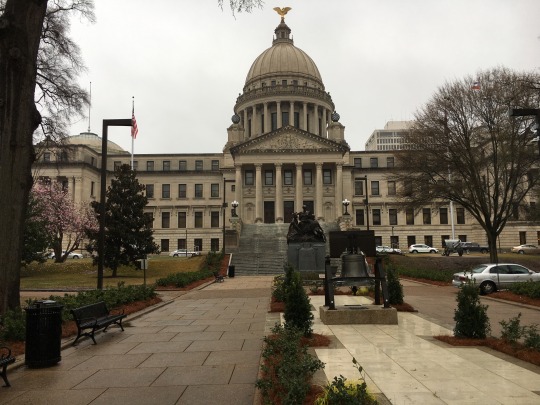
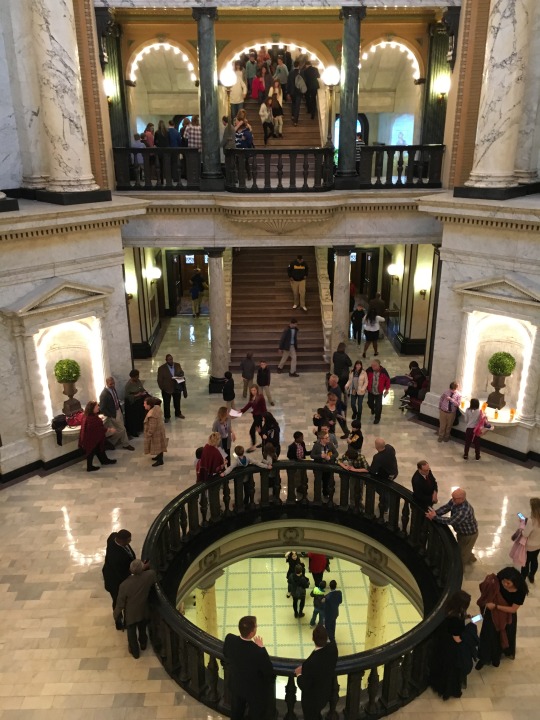

Next stop were the Mississippi History Museum and Civil Rights Museum. They are separate museums housed in the same building. It all seems very new, and it’s extremely comprehensive, engaging, fair and well-executed. The History side traces the state’s history through various eras, from the indigenous peoples to the early Spanish/French/British/American days to the Civil War and Reconstruction to the Great Flood of 1927 and the Depression to WWII. The Civil Rights side covers slavery and Jim Crow but focuses mainly on post-WWII. Both sides’ displays tell personal stories as well as describe local and national historical events. The History side also covers a wide range of themes: political, scientific, technological, ecological, economic, social, etc. (Another nice touch is all the signs directing visitors to important historical sites around the state.) They strike an excellent balance between text, images, videos and artifacts. My only complaint is that it’s too much-- I wish I could have spent all day there.
The contrast with Birmingham’s Civil Rights Museum was interesting. Birmingham felt more uplifting and empowering. Alabama was the site of great setbacks of course but they had many dramatic successes as well, like the bus boycott and the Selma March (which led quickly to the Voting Rights Act). Mississippi just feels tragic. The killings of Medgar Evers and Emmett Till, the James Meredith riots at Ole Miss and his later shooting on his march, the murders over Freedom Summer and endless, well-organized resistance from white supremacists at every level of government and society. It might just be the different ways these museums tell their stories, but it seems like the victories in Mississippi came only through very slow court battles whereas Alabama had more success and some more dramatic pivotal moments.
My last stop was the Mississippi Museum of Art which is supposed to have a phenomenal local collection. Most of the museum was closed for renovations and/or installations so very little was on display. But that’s OK since I needed to get back on I-55 and get to Memphis. After a nerve-wracking drive through pouring rain, I finally made it.
0 notes
Text
Mobile, Alabama & Gulf Coast
After a few hours in Montgomery I got back on I-65 and headed almost to the gulf, to Alabama’s only port of Mobile. I knew nothing of the place, but the closer I got to the city, the clearer it became that this was going to be more Florida and New Orleans than Alabama.
The scenery on the drive was pleasant, if uninspiring. All rural with gently rolling hills through piney woods and the occasional creek with a weird name (Burnt Corn?). About an hour from Mobile the rain really started pouring which was a bit scary especially with the pavement uneven due to road work. When I emerged from the storm, the sun was low on the horizon and I suddenly found myself in swamp country. Driving into the city with its Mardi Gras decorations festooned everywhere, I knew I was in for something different. Since it was late when I got to my AirBnB (a very cute restored mid-19th century bungalow), I just walked over to Cavanaugh’s for dinner. It’s an historic “must-do” Irish pub tho I didn’t really see what the hype was about. The surrounding neighborhood, Midtown, is very pretty and could easily pass for New Orleans.
The next morning I waited out the worst of the rain storm then started walking downtown. I took Dauphin Street, the historic commercial drag. It was very charming, kind of like an old-west-meets-French-Quarter look. And everyone is clearly excited for Mardi Gras. It has some notable churches, public squares and historic buildings and runs all the way to the waterfront of Mobile Bay. The waterfront sadly is pretty tragic. A major road runs along the water where a pedestrian esplanade really ought to be. But the bay has been handed over to industry so it’s not a big loss for pedestrians anyway. I stopped for lunch at Spot of Tea a well-regarded breakfast/lunch spot. My scrambled eggs over crab cakes were good but predictably sauce-drenched and heavy.
After the waterfront I stopped at the Mobile Museum of History, a beautiful building that originally served as City Hall and public market. The museum is expansive and full of artefacts (and of course several Mardi Gras exhibits-- the city hosted the country’s first Mardi Gras celebration). The story of Mobile is interesting too, how it passed from the Native Americans to the French to the British to the Spanish to the US. My favorite part was the display that described all the devastations the city has survived, numerous fires, hurricanes, yellow fever outbreaks and even an explosion at a munitions warehouse a couple weeks after the Civil War ended which leveled eight blocks and instantly killed up to 300 people. I also appreciated the museum’s even-handed, direct approach to all of the city’s shames, like its role as a major slave trading port to segregation to the environmental harms done to the bay to on-going unequal access to education.
From the museum I walked back home along Government Street, another main drag. It was an odd combination of grand old mansions, churches and government buildings interspersed with fast food joints and empty lots. I think it gets nicer farther west (to be continued). I returned home to relax for the rest of the day. That night I had surprisingly tasty Mexican at the OK Bicycle Cafe (which also serves sushi).
The next morning I was back on the move. On my way out of town I continued down Government Street where the homes became jaw-droppingly stunning. I detoured through the Leinkauf neighborhood, which was cute tho less impressive (it looked like Berkeley, complete with seemingly pointless roundabouts and road blocks). I then headed toward the coast.
Mobile’s suburbs sprawl basically to the Mississippi border. Shortly after that however the highway reaches the coast near the town of Ocean Springs. I first stopped at the Gulf Coast Seashores National Park, a lovely, swampy nature preserve on the water full of pines, gum trees, palmettos and Spanish moss. After a quick walk around I got back in the car and drove into “downtown” Ocean Springs. It’s a picture-perfect Southern small town with an artsy beach vibe. I visited the Walter Anderson Museum. He was a talented, versatile local artist, and the museum showcases his murals, paintings, pottery, carvings, drawings and more. His colorful painting style calls heavily upon nature and folk styles and has an almost alien quality. The museum also showcases Shearwater pottery which the Anderson family has been producing for three generations in Ocean Springs. Their pieces, both functional and decorative, are beautifully designed and painted. The Anderson family’s influence turned this town into an art community and made it into a unique spot on the Gulf Coast.
I continued my drive down Highway 90 (the Gulf Coast Scenic Byway) and soon reached Biloxi. It looks pretty cheesy at first with giant casino and hotel developments on the beach. But it quickly turns into a gorgeous stretch of gleaming white sand and deep blue seas for miles and miles. The road runs alongside the beach, and on this bright sunny day it felt like I could have been in Venice, CA, or Miami. Except on the other side of the road are spectacular old Southern mansions (verandahs for days) and newer beach homes perched heroically high on stilts. Interspersed among these are cheesy beach shack restaurants, budget motels, fast food and of course, Waffle Houses. It’s a totally unique stretch of land that seems to encompass every bit of the South.
The highway continues along the beach through Gulfport and some other towns until it reaches the Louisiana border. Very quickly the beach gives way to bayou where it’s not always clear where land ends and water begins. It’s an interesting mix of rundown shacks and newish vacation homes, sometimes separated only by a rusty old bridge. It’s a part of the country that’s always fascinated me with its distinctive geography, history and mix of cultures. And of course it’s the doorstep to one of my favorite places: New Orleans.
#mobile#alabama#travel#intentionaltravel#gaytravel#mississippi#gulf coast#ocean springs#biloxi#louisiana
0 notes
Text
Montgomery, Alabama
After Birmingham my next step was 1.5 hours south, the state capital Montgomery, another historically-charged city in the South. I read it was pretty sleepy (truth) so I decided I would just spend a few hours there but my time did not disappoint. Even more so than Birmingham, Montgomery is a step back in time with important lessons for the present. If only they would learn....
My first stop off I-65 was the brand new National Memorial for Peace and Justice. It opened last year to commemorate victims of racially-motivated violence, from slavery to police killings, but its primary focus is lynchings. Atop a grassy hill under a low slung roof hang 400 rectangular iron slabs, one for each county where lynchings took place (mostly in the South, but parts of the midwest too). On each slab is engraved the name of the county and the people who were lynched there (tho only a fraction of the victims and their stories are known). The pathway slopes downward in a loop until the slabs’ hanging effect becomes unmistakeable. Along the sides are engraved inspirational quotes and the shocking stories of some of the victims (one man was lynched after a coat went missing). The horrific details of torture and death are not spared. Outside this roofed area an identical set of 400 slabs lie on the ground like a field of coffins, waiting for each county to pick theirs up and display it, in an attempt to create a truly national memorial and a semblance of accountability. It’s deeply saddening and moving, a truly provocative, moving, overdue addition to our country’s national monuments. But unlike, say, the Vietnam Memorial, here you must have your bags inspected, pass through a metal detector and be told not to take selfies with the statues of tormented slaves in chains. How awful that those precautions are still needed.



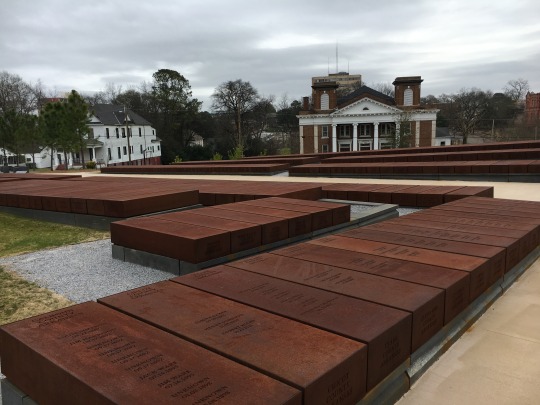
From there I moved to Montgomery’s most famous institution, the Rosa Parks Museum. It has two halves: a children’s wing that tells a very simplified version of black history from slavery to Jim Crow (all while sitting on a “time machine” bus with hydraulics driven by the robot Mr. Rivets); and a wing focused on Parks’ protest and the ensuing bus boycott. Annoyingly the ticket person didn’t tell me that the first part was for children when he sold me a ticket, so I wasted 30 minutes riding this Magic School Bus. At least I was all alone (except for Mr. Rivets) so I didn’t have to give up my seat to anyone.
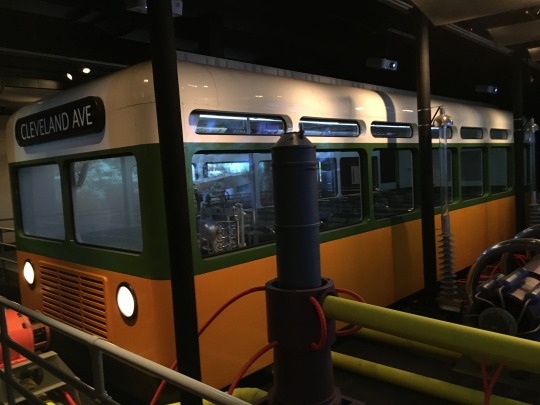

I decided to postpone the second half of the museum and walk through downtown Montgomery to the capitol building. The main street, Dexter Ave, has not changed much since Parks was arrested there almost 65 years ago. Most of the storefronts are deserted and judging by the signage left behind, they have been empty for decades. Some of the structures are quite beautiful and historic, such as the fountain at Court Square (originally a slave market and later the bus stop where Parks boarded that bus) and the Winter Building (where the Confederate leaders sent a telegram to their generals permitting them to fire upon Fort Sumter, which started the Civil War). But mostly it’s pretty bleak. Even the more modern government buildings at the end are really unattractive smorgasbords of too many architectural styles.
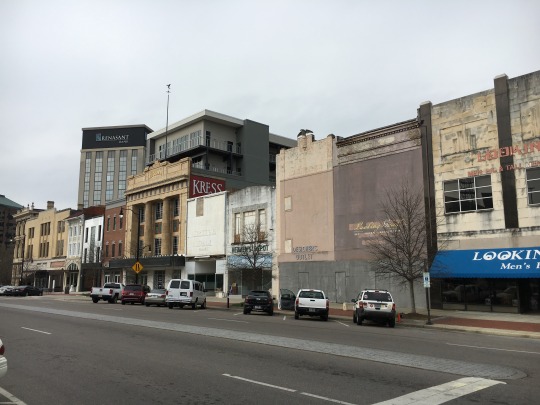

The capitol building itself is fairly nice. The grounds are well-maintained, and they had the decency to remove the Confederate flags from their massive monument to the Confederacy.... (Fittingly I had the disgust of seeing Jeff Sessions pass by as I was photographing the monument.) The building has undergone several expansions and renovations and even tho there has been some attempt to restore original details, it still looks like the interior came from Julia Sugarbaker of “Designing Women.” The walls are mostly painted pink and lavender, and the carpeting and chandeliers are quite... ornate. The original Senate chamber is where the Confederacy was born, and the front steps are where Jefferson Davis was sworn in as president. (Over one hundred years later, MLK would address 25,000 supporters from those steps after they walked in protest from Selma, the first attempt ending in the police severely beating the marchers.) Weirdly I think I saw maybe three people working in the entire STATE CAPITOL, not to mention the dozen I saw walking around the city for an hour. It is sleepy there....



Montgomery has an interesting way of addressing its dual history as the birthplace of both the Confederacy and the Civil Rights Movement. The public signage is notably impassive: “This happened here. This happened there.” Of course true objectivity doesn’t exist-- they use “secede” and “secession” a lot, rather than, say, “rebel” and “traitor”-- but I do think the state has struck the right chord. They know how divisive their history continues to be. They clearly just want to acknowledge historic events and keep the government neutral in these heated discussions, a wise lesson for Alabama. (My biggest gripe is that I saw nothing acknowledging that Montgomery began as an important port for slave trading. Even the sign at the riverfront only mentioned that the port traded a lot of cotton, grain “and other commodities”.)
The non-state sites, such as the Rosa Parks Museum and the Lynching Memorial, stir enough passion to make up for the official indifference. My next stop was the National Civil Rights Memorial, an homage to 40 people who died as martyrs during the Civil Rights struggle, Some of them were active protestors; others were bystanders whose deaths helped propel the movement. Some are familiar, like Medgar Evers, Emmett Till and MLK; others are unknown. The terrifying, harrowing personal stories hit hard. Outside of the museum is a water sculpture designed by Maya Lin (of the Vietnam War Memorial) that is solemn and dignified, while its flowing water and circular design suggest the struggle has always been happening and continues to this day.

After this it was time for lunch at Dreamland, a small Alabama BBQ chain that was as delicious as it was friendly. It’s in an area just northwest of downtown by the riverfront that is undergoing a promising, well, gentrification. It’s full of beautiful old brick factories and warehouses that are being restored and converted into lofts, galleries, restaurants, bars, etc. It sounds tragic to coastal ears, but I think Montgomery could really benefit from development that draws in young people. And the restorations look remarkable.
After lunch I walked to Old Alabama Town, a collection of small old homes spread across several blocks that display what the city used to look like (I’m not sure when exactly). It was cute and charming but not architecturally noteworthy and hardly worth the walk over. I went back, past the Hank Williams statue, and popped over to the riverfront, also not worth the walk (at least not on a grey winter day).
My last stop was back at the Rosa Parks Museum to see the “grown-up” wing I missed before. It’s one of these museums that makes you sit through various presentations rather than proceed at your own pace. I’m not a fan of that, especially when I’m tired and trying to get to Mobile before the rain and dark arrive. The first video describes life for blacks under segregation and explains how the bus segregation was the most hated of all, which was actually pretty interesting. It tells Rosa Parks’ backstory as well, but although it explains how she worked with the NAACP, it glosses over how much of her protest was plotted in advance so that the museum can stick to the “just a tired lady on the bus” narrative. Once that video ends, some doors open and lead the viewers into a room designed to look like a bus stop, complete with the shell of an old bus. In the windows a video is playing, and for the next ten minutes actors in the video recreate the scene when Parks wouldn’t give up her seat. It sounds weird-- and it was-- but somehow it works. (Fun fact: under city law Parks was allowed to sit where she was and did not have to give up her seat, tho neither she nor the driver was aware.) Unfortunately I had to skip the self-guided history of the boycott (which is really the best part) because my meter was running out. I also decided to skip the Lynching Memorial’s sister Legacy Museum. It sounds amazing, but I wanted to get on the road and frankly, it sounds really depressing, and I had had enough for the day.
I then left for Mobile (to be continued) and while I was having dinner there I caught up on the news of the day. It turns out that while I was touring Montgomery’s and Alabama’s tortured history of discrimination, the US Supreme Court handed down a decision in the case of Domenique Rey. Rey is a Muslim man on death row in... Alabama. After exhausting his appeals, he asked that an imam be allowed to pray with him during his execution. The state told him that only the officially sanctioned (Christian) chaplain would be allowed. Rey appealed, citing the Constitution’s anti-establishment clause which forbids the government from favoring any religions. The Eleventh Circuit stayed his execution but the US Supreme Court decided against him. The new conservative majority of five thought that because his petition arrived just weeks before the execution, he was only trying to delay it (nevermind that he filed as soon as he learned the imam would not be allowed). Even many conservative commentators think this will go down as one of the Court’s worst decisions, along with Dred Scott and Plessy (which I learned about on the time machine bus tour!). Curiously, after the Eleventh Circuit stayed the execution, Alabama figured the jig was up so they changed the rule so that no clergy of any faith would be allowed to comfort the condemned during an execution. This echoes the state’s tactics during the fight against segregation, when they closed parks, pools, schools, etc. rather than integrate them. Alabama, will you ever grow up?!
1 note
·
View note
Text
Birmingham, Alabama
For my next trip... I’m taking a three week road trip through the American South to some parts familiar and others unknown. My trip began in a part unknown (to me anyway): Birmingham, Alabama, a city perhaps best remembered for its brutal opposition to blacks’ civil rights in the 1950s and 60s. I’ve heard good things about it since, but the past seemed like a good place to begin.
I started my first day at the cute Red Dog cafe, the kind of place filled with millennials and MacBooks that you can find in gentrified neighborhoods the world over. While this globalized hipster culture is somewhat lamentable, it’s reassuring as well and a sign of Birmingham’s economic progress. From there I headed to the Birmingham Civil Rights Institute. It’s in an historically very significant area. The neighborhood was a black exclusionary zone (one of the few areas of the city where blacks could live, work and own property and businesses). It’s between the Gaston motel (a black-owned motel that became a headquarters for civil rights leaders) and the 16th Street Baptist Church, a popular meeting place for the movement made infamous when a bomb there killed four young girls in 1963. And across the street is Kelly Ingram park, the site of many marches and protests, including a youth-led one where the police and fire department set dogs and high-pressure water houses on hundreds of adults and children.
The museum starts with a short film describing the city’s history. Interestingly Birmingham was founded after slavery, in 1871, as an iron producing town. It grew and prospered quickly, largely on the backs of black labor who were given the worst jobs for a pittance. And despite having never known slavery, the city became renown as one of the strictest and brutalist enforcers of segregation. The next few displays depict life under Jim Crow and some truly stomach-churning artifacts of black stereotypes and white supremacy. It then shifts to the long struggle to end segregation and win the vote and equal rights. It’s a familiar story but the resonance is so local here. As I’ve learned about the civil rights struggle throughout my life, I never really put together how much of the most intense fighting happened in just the one small part of the South. Rosa Parks and the bus boycott in nearby Montgomery. Dr King’s Birmingham home bombing and his famous letter from the local jail. Governor Wallace who won election-- and even carried five Southern states during his 1968 presidential campaign-- with his promise of “Segregation now, segregation tomorrow, segregation forever”. Police beating up peaceful marchers in nearby Selma. The 16th Street Baptist Church bombing. The city’s Police Chief, Bull Connor, and his notorious attack dogs and water cannons. Freedom Riders being beaten and killed across the state. Of course people fought for civil rights all over the South (and later all over the country), but Alabama-- and especially Birmingham-- were the epicenter. All the familiar speeches, history, newsreels and photos felt devastatingly real seeing them there.
The problem that all history museums face is deciding when and how to end because history never ends. In this case, by the late 60s the segregationists started to accept defeat (Wallace’s campaign notwithstanding), and the action moved away from Birmingham and Alabama. The Civil Rights Movement itself splintered into countless factions espousing varying goals and methods, the chaos of which helped spur a backlash and the election of Nixon by his “silent majority.” The museum kind of rushes through the late 60s and ultimately ends by celebrating the 1979 election of Birmingham’s first black mayor, Richard Arrington, Jr (depicted with an entirely pointless recreation of the mayor’s office). While that is an achievement to be lauded and the curators probably felt compelled to leave visitors feeling uplifted, it parallels (and foreshadows) the “problem solved” mentality that followed Obama’s election. Gaining legal equality was a first step (or second, after ending slavery), but I think it would have been powerful for the museum to highlight some of the many ways racism still persists: in politics, government, urban design, economics, business, education and health, not to mention in many hearts and minds. (Arrington’s election was followed three years later by Wallace’s re-election as governor to a fourth term.) A final, more uplifting display could depict the ways that blacks’ civil rights struggles inspired others like women, gays, Native Americans and immigrants. (There actually are some colorful displays honoring a few civil rights causes around the world, but they seem more random than anything.)
After seeing the museum I walked over to the church (which was closed) and through the park, which has several haunting sculptures depicting the violent crackdown on young protestors there. It’s all so calm and quiet now, it’s almost hard to believe what was happening there in my parents’ living memory.
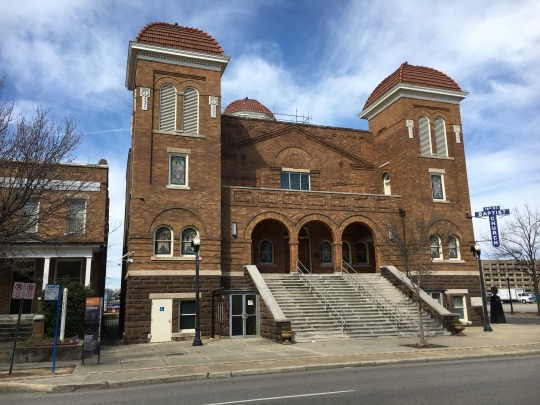
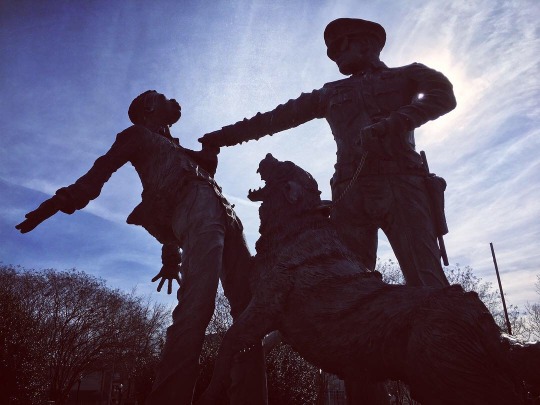
(For the surprising backstory on the above statue and the photo on which it’s based, check out this podcast of Revisionist History.)
From there I went to the Birmingham Museum of Art. I actually just wanted to see the sculpture garden which had a good sampling of thoughtful and whimsical works. After a quick lunch stop at a middle eastern place (which still managed to be brown, fried and greasy since this is the South), I went up to Vulcan Park. It’s the site of a massive statue of Vulcan, the god of fire, and it’s the largest cast-iron statue in the world. The museum next door is an ode to Birmingham and iron, the metal that built the city literally and figuratively; iron mining and production was the dominant industry for the city’s first 100 years. While I liked learning some of the city history and seeing the old photos, the generally unqualified enthusiasm raised doubts about how fairly the story was being told. It was at least a stark contrast to the unflinching, ugly history lesson I experienced earlier.

That evening I visited a couple gay bars, Chapel (housed in a former church and up until a few months ago, a leather bar named Spike’s) and Al’s. Chapel’s crowd was thin but admirably diverse. They felt like the high school outcasts who had all banded together. And the drag show (featuring queens and kings in equal number) was cute but decidedly low-rent DIY. The host was wearing a Star Trek costume.... Al’s was the opposite, the popular clique in high school. It looks like your standard pop-fueled gay dance bar, and their drag show was much more polished. (Apparently Birmingham gay bars are all about drag shows.) The star that night was Trinity “The Tuck” Taylor who grew up in Birmingham and is now in the final four on RuPaul’s Drag Race. So that was probably exciting to anyone who cares.
On Saturday I slept too late again, but eventually got up and made my way to brunch at Five in the hip little Southside area (near the gay bars). I then drove to Sloss Furnace, a massive dormant ironworks, originally built in the 1880s. Much of the machinery and infrastructure is still in place (tho rusted away), and you can walk around and explore. It’s captivating, like walking around an ancient ruin, but one which was still in use only 50 years ago. It’s a lot to think about as you wander through the deserted behemoth: how massive this operation once was, how many resources it sucked up, how much iron it produced, how many people died working it, how much it grew Birmingham’s economy and how it’s now literally a shell of its former self just 150 years after it was built. Along with the Civil Rights Museum, Sloss is another reminder to Birmingham just how quick and difficult change can be.
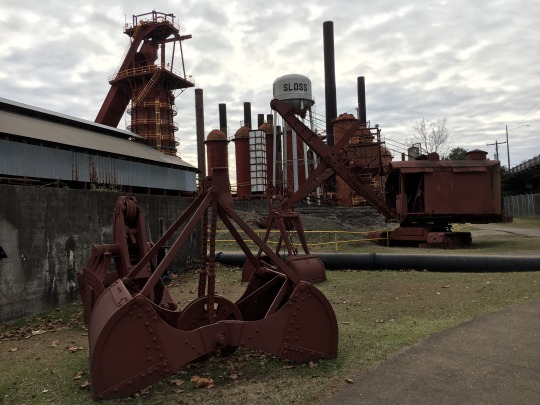
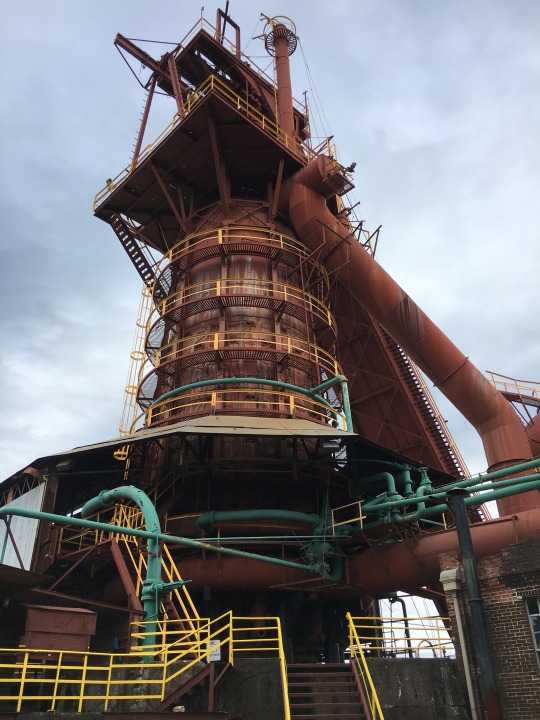

The mini-museum at Sloss unfortunately is not so inspiring. Obviously it’s very pro-iron, like the one at Vulcan Park, but its white-washing of history is both comical and offensive. There’s no mention of the environmental impact. The factory towns sound like great places to live (they were not). The (mostly immigrant and black) workers are described as pioneers seizing opportunity, not exploited labor. The only mention of the racist division of labor was an admission that the factory had separate baseball teams for whites and blacks (but supposedly they would all go to each others’ games anyway so it was all good). In one confused sentence we learn that Sloss had a “decent safety record” but injuries and deaths were also very common. In fact we learn the best protection a worker could get was from having good coworkers (not from, say, adequate gear, precautions and risk reduction, all of which cost money). And, by the way, the state’s whole iron industry went into decline after the passage of the Clean Air Act of 1970 and the removal of tariffs on foreign iron. (No mention of how these events impacted the quality of air or the cost of iron to builders and consumers.) The ingenuity, hard work and rapid success of the city’s iron industry is very impressive but it’s worth remembering the cost.
For dinner Saturday night I went to Hot & Hot Fish Club, one of the city’s finest. It was delicious but didn’t seem especially distinctive. I’m not sure why it’s on so many must-do lists. I figured some sleep would do me good so I stayed in that night.
For my last day I visited the popular Five Points South and Homewood areas. Five Points is (or was) a hip area (it’s near the University), but that’s hard to see, especially on Sunday when most businesses are closed. It has some lovely Spanish Revival and Art Deco buildings, but it’s very small and a bit run-down. Homewood is better kept-up, kind of like a quaint 1950s main-street but with yuppie boutiques selling linens and children’s toys. It has a lot more shops and restaurants, and I found a good lunch at Real & Rosemary and a friendly coffee at Henry’s.
After that I visited the Botanical Gardens. As one would expect in early February, not much was in bloom, but the gardens were still very nice. They’re sprawling and serene, with a good mixture of design styles. Half the gardens are built into a hillside, and the terraced paths offer ample opportunities to get lost and discover. And of course there are lots of gazebos because this is the South. The evening was chill. I had dinner at a Southern burger ‘n beer chain called Jack’s (pretty good but small burger) and stopped at Chapel for a drink. The tiny crowd was once again eclectic and this time watching the Grammys.
Birmingham is definitely a small city in Alabama (especially for the gays). I sensed racial and socioeconomic stresses beneath the surface-- or rather around the edges. (I spent my time in the center between downtown and some very fancy neighborhoods, and I hardly saw any black people although they are 75% of the population here.) And yet it has a hard-to-define appeal. By all logic it should be a cultural backwater, but it’s not. Despite its origins as essentially a factory town for iron producers, its deeply disturbing racial history, and its on-going racial and socioeconomic divides, it seems determined to persist, to accept its past and celebrate the openness and diversity that came out of it. In the city’s early days, its rapid growth and economic success earned it the nickname “The Magic City.” During the Civil Rights era, it was re-dubbed “The Tragic City.” But Birmingham’s drive to prosper despite-- and because of-- its past has brought back much of the magic.
0 notes
Text
Guadalajara
After a week in CDMX, I flew to Mexico’s second city, Guadalajara. It was my first visit so setting an intention was simpler: see the sights and get to know the city. This turned out to be pretty easy since there is not a whole lot to see or do there.
On my first day I headed to the historic center which consists of four plazas surrounded by government buildings, churches and shopping arcades. The plazas were all very pleasant and well-designed. The buildings were attractive if a bit monotonous (they love Tuscan arches there). The two standouts are the beautiful Cathedral and elegant Teatro Degollado. Also notable are the Jose Clemente Orozco ceiling murals in several buildings around the city. I walked west from the center to see more churches and parks as well as the University’s art museum.
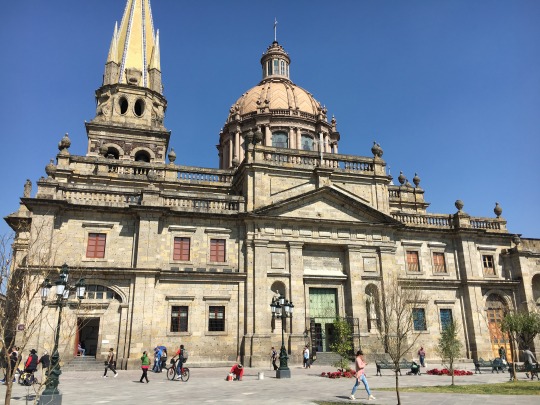
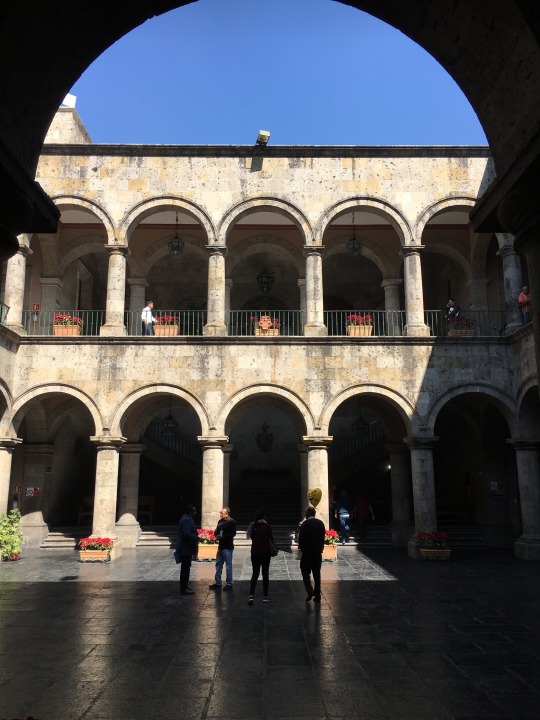

The following day I visited the nearby town of Zapopan, famed for its basilica (and the devotion of its congregation to Nuestra Senora de Zapopan, a little doll that sits above the altar). In front of the church is a lovely pedestrian walkway with some impressive public art. I also stopped at the local art museum which was refreshingly contemporary. In the afternoon I walked around Santa Tere, a traditional neighborhood that feels very authentically Mexican.
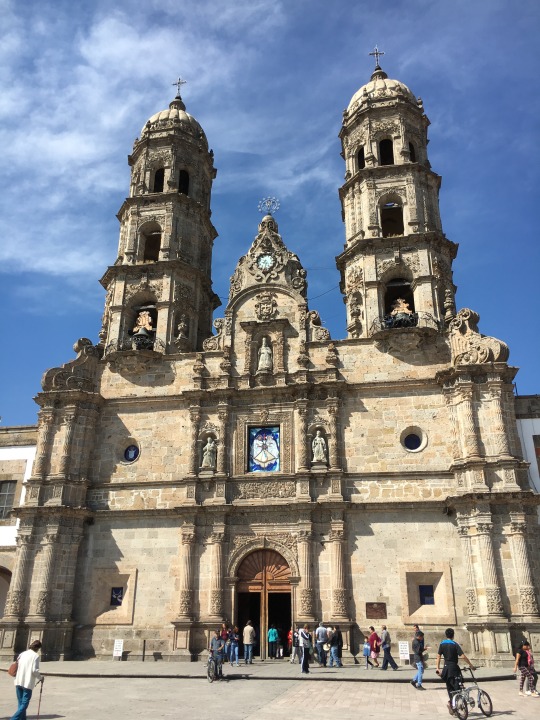
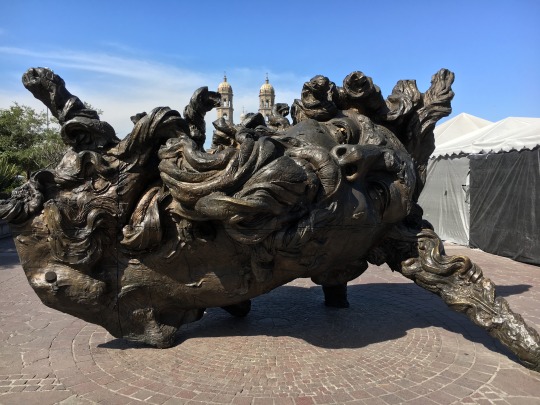

On Saturday I walked down Chapultepec, a hip area known for its restaurants, bars and clubs. It was still early however so there was not much to see. I then walked around Americana, an upscale neighborhood with some gorgeous homes, nice restaurants and hipster bars and cafes. (It reminded me of New Orleans’ Garden District.)
On Sunday I returned to the historic center, which was bustling with visitors and street performers. It was great to see all that wonderful public space so full of life. This time I walked east through the long pedestrian area of Plaza Tapatia to the stately Instituto Cultural de Cabanas. It’s a former orphanage that’s now a museum, focusing mainly on modern art. The central chapel has 57 Orozco murals, which are stunning. The numerous interior courtyards are full of whimsical sculptures, and the works in the gallery were imposing and impressive. I especially loved the temporary exhibition on the Portuguese futurist artist, Almada Negreiros. I also visited the unbelievable Mercado San Juan de Dios, a squat brutalist concrete building that houses a marketplace of nearly 30,000 vendors. You can find just about anything you could want in there (if you can actually find it).
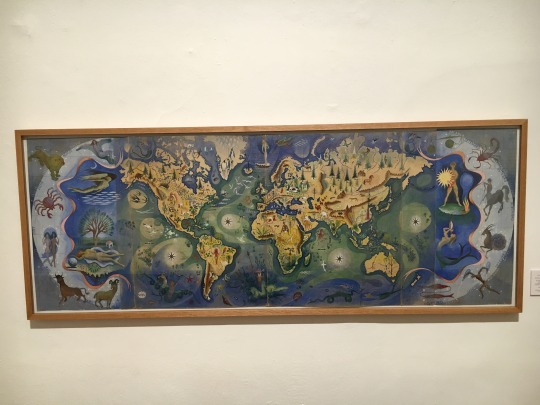


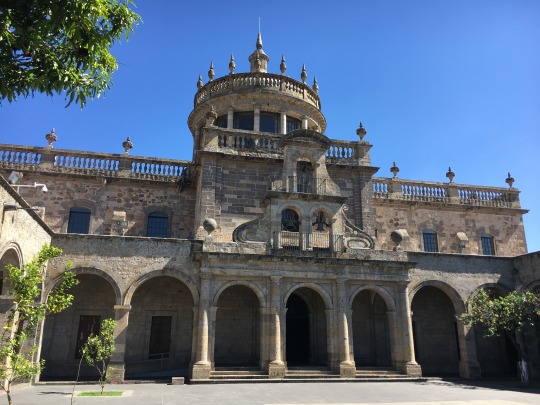
On my last day I headed out to Tlaquepaque, a nearby town that is supposedly an artist community. It’s well-preserved and full of beautiful old homes many of which now sell souvenirs, art and furniture. It’s like a Mexican Carmel or Sausalito. Still a nice place to wander around for a couple hours.
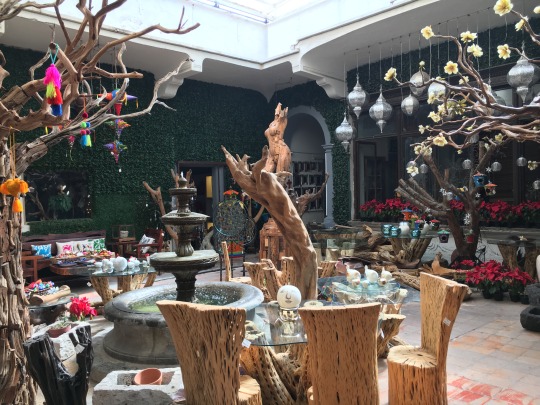

If this sounds like not much activity over a five day period, it’s because it is not. Guadalajara is lovely and has some definite highlights but three days is plenty of time there. (One popular excursion which I did not make is to visit agave farms and tequila distilleries outside of the city.) I spent a fair amount of time reading and watching Netflix, but I was OK with that. I knew I wasn’t missing anything, and it felt good to have downtime after being a busy tourist. Guadalajara also has a lot of great food as well as a strong hipster culture with all the craft beers and artisanal coffees that accompany it. Some of the local specialties, carne en su jugo (like a meat stew) and torta ahogada (fried pork on a French roll drenched in spicy sauce), did not disappoint. But I would not recommend the tejuino, a nauseatingly sweet corn drink (yes, corn).
The one last thing I will say about Guadalajara concerns the boys. I had heard that it’s a very gay city and that the guys are hotter than in CDMX. I do not know where it got that reputation. It’s a pretty conservative place with deeply ingrained Catholic guilt and ideas about machismo. Their online profiles are woefully lacking-- bad pics (or no pics), weak descriptions, even things like height left blank. They emphasize “discreto”, “varonil” (masculine) and “bi”. Most guys I talked to just wanted to see my photos. Several said they wanted to meet and then found excuses not to. And the few I did meet were not very skilled. They didn’t really participate; rather they just let sex happen to them, as if to maintain some plausible deniability.
All told, Guadalajara has some beautiful buildings, plazas, parks and art as well as some delicious food. But I don’t recommend the boys. And don’t stay too long unless you packed some good books or you’ve got some new Netflix shows to binge.
6 notes
·
View notes
Text
Mexico City
As for as setting travel intentions goes, my trip to Mexico City (CDMX) was not a promising start. I originally booked the trip when I was employed, its purpose just a long weekend getaway of not doing much. Since I spent ten days in CDMX a year ago, I’ve seen the best parts of the city already, so I could just enjoy my time there at a leisurely pace. After I lost my job I extended my visit to one week in CDMX and one in Guadalajara. But I never asked (or answered): why?
Knowing I would have a lot of down time, I thought it would be smart to exercise and write everyday. That intention quickly collapsed as I shifted into vacation mode. I fell into the same pattern as in NYC: sleep late, slow start, unambitious day. The first couple days I mostly just walked around Roma, which to be fair, is such a great neighborhood. It was originally a genteel, well-heeled neighborhood designed in a European style in the early 20th century. It slid into disrepair in the 70s until the past ten years when it has re-gentrified. So on any given block you might find a magnificently restored colonial mansion next to a crumbling one, a decaying estate overgrown with vines and weeds next to a stylish contemporary apartment building. Its faded-but-sometimes-rejuvenated glory reminds me of Buenos Aires.
Roma of course is the name and setting of Alfonso Cuaron’s critically-acclaimed new film, which is based on his own childhood. The film takes place in the early 70s, when Mexico was undergoing a political upheaval and the neighborhood was losing its luster. In the film, the family, neighborhood and country face parallel struggles as they attempt to shift from tradition to modernity. Cuaron’s childhood home has since been demolished and replaced (a symbolism I’m sure he appreciates), so for the exterior shots he used this house across the street (Calle Tepeji 21). The gate was added for the film.
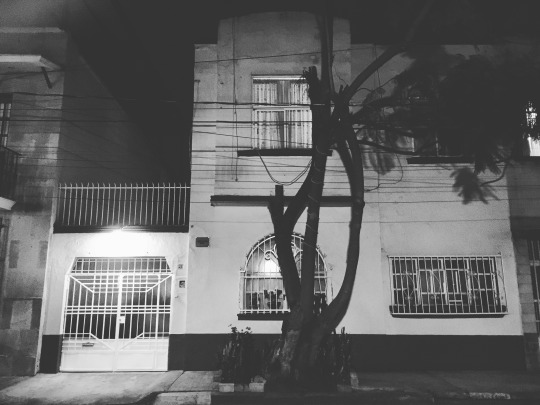
Roma also has the best restaurants in the city. My favorite is Lardo, known for its brunch but all the meals are great. I also discovered a new street food spot, Expendia de Maiz, which serves tacos, sopes, tostadas, etc with very fresh, distinctive ingredients. It is literally a hole in the wall and has just a few tables on the sidewalk in front.
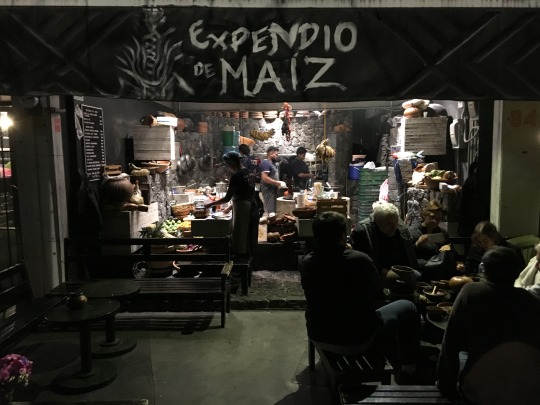
Other favorites, both old and new, include Contramar, Lalo, Cedron, El Roma Bistrot and Masala y Maiz (nearby in Condesa). After a few meals, I realized that at all of these restaurants I was surrounded by American voices. Clearly we all read the same food blogs, NYT’s 36 Hours, TripAdvisor, etc. and end up at the same restaurants. At first this is disappointing as it takes away the traveler’s joy of discovering something new. But the food is delicious at all of these places and costs ¼-½ what it would in the US. And plenty of locals were dining there too, so they aren’t tourist traps. Also, when I ate at places full of locals where I was the only gringo, they weren’t as good. There’s a reason the best restaurants are the most popular….
I actually heard a lot of American English all over Roma, even more than I did just a year ago. In part this was because it was a holiday weekend in the US. But clearly the secret is getting out, and CDMX is becoming a more and more popular destination. This is generally going to be a positive thing for the city and country, but it will have downsides. At least all the Americans I saw and heard were well-behaved and not loud (although they did talk about getting drunk a lot).
On Saturday, through one of the gay apps, I ran into Pascal, a French Canadian guy I had met in SF years ago. That night we went to a huge, Berlin-style, underground party called Pervert. It’s a monthly party held in a (presumably) condemned building so it can be trashed and so the police can’t track it (as if they care). Besides being a death trap, it was also very poorly organized. In fact, it wasn’t clear if anyone was in charge. There were three floors, packed with people, sweat and smoke. It had only two bars and two bathrooms with massive lines; by avoiding the former I managed to avoid the latter too. The music was uninspiring, run-of-the-mill house and techno. And yet somehow everyone kept their shirts on; at a US gay party, shirts usually come off as soon as you walk in. But it did feel like we were doing something special and distinct, something local that most tourists don’t get to experience. And fortunately the ground floor was relatively cool and smokeless-- and closest to the exit in case the whole building collapsed.
Pascal and I went out Sunday night too. I decided to walk home, stopping first at the Oxxo for a beer to drink on the way. Not smart. A few blocks later I was stopped by la policia who told me that drinking on the street is illegal and I would need to pay a 4,000 peso ($200) fine or be arrested. (Helpfully one of them used a translator app on his phone to tell me this.) Obviously this was a shakedown for a bribe (Mexico City’s finest!), so I had to play the game. I told them I didn’t have 4,000 pesos (I mean, who walks around with that much money in CDMX?), and they said they’d have to arrest me. After pressing for 4,000 a few more times, they asked how much I had. I offered 600 pesos plus the $20 bill I had on me for just such an occasion (talk about traveling with intent). As I went to pull out my money, they said “not here” and ushered me behind a newsstand kiosk to complete the transaction. I never felt in danger; it was just an annoyance at the end of a very frustrating night (boy-wise). Mexico City has become a lot cleaner and safer in the past decade, and it’s making the city a far more liveable, visitable place. Their unreformed, corrupt police remain a shameful stain on the city and an ugly perpetuation of a stereotype North Americans hold about Latin America. But at least I can say I had a traditional Mexican experience on my trip.
On Monday I finally started acting like a tourist and visited the Soumaya Museum which houses the art collection of Carlos Slim, a telecoms mogul, Mexico’s richest man and apparently a big fan of Rodin’s sculptures. The collection is vast and broad and housed in a beautiful, sweeping, funnel-shaped, six story modern building. But there are no real standouts. Most pieces are from the 19th century and earlier, and by the time Mr. Slim started collecting, all the best works were taken (except the Rodins which are fairly easy to recast and reproduce). It looks like a world-class fine arts museum, but upon closer inspection, it’s more like a replica. If I had Mr. Slim’s fortune, I would collect contemporary art since some of the best artists and pieces are still available, even undiscovered. (I mentioned this to someone, and he told me that’s what Mr. Slim’s rival mogul, Eugenio Lopez Alonso, did, and he housed his collection in his Jumex Museum next door.)
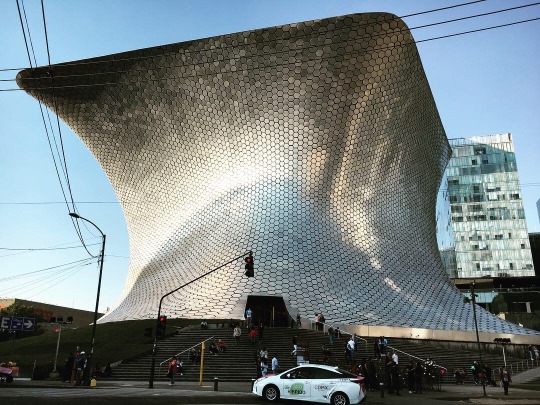

For my last day, Tuesday, I was well-rested and determined to do some proper tourism. I walked through Bosque de Chapultepec, the city’s main park, to Los Pinos. For the past 80 years, this has been the residence of the country’s president. But the newly-elected president, known as AMLO, decided it was too fancy for him and in a characteristically populist gesture opened it to the public. This is not without precedent. Los Pinos was built in 1938 after the then president decided the official residence, a stunning Habsburg castle on a hill near the park’s main entrance, should belong to the people of Mexico. It has been the national history museum ever since and is my favorite museum in the city. Unfortunately for modern Mexicans, Los Pinos is far less impressive.
The interiors have been recently renovated with no sense of history or style, so they look utterly generic. And oddly most of the furniture has been removed so most rooms are empty. Of those that remain furnished, the living quarters look like a Pottery Barn and the offices look like a law firm. It might be interesting for Mexicans to see where their presidents have lived and worked for the past 80 years, but even that requires a great deal of imagination since there are few signs, portraits or anything else of historical merit. The museum on the grounds is undergoing renovations (currently the only items on display are three very 1970s presidential cars parked in front). Perhaps when the museum reopens a Los Pinos visit will be more worthwhile. Otherwise, like AMLO’s decision to stop work on the new airport, this looks like a poorly thought-out idea meant to appeal more to “the common man” than to common sense.

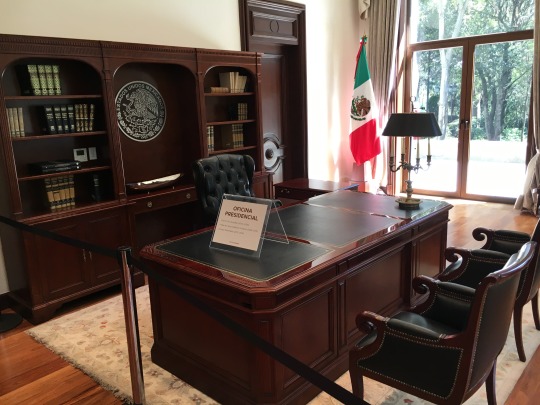
I continued my tourism by walking through the lovely, gentrified Condesa neighborhood to meet Pascal for lunch. Afterward we rode the metro over to the Zocalo. I explored the historic centro during my last visit, but Pascal had never been so I thought it would be a good walk. We wondered around the Zocalo, Cathedral and surrounding streets and plazas over to the gorgeous Palacio de Belles Artes. Highlights included a traditional bakery (and watching people stack their trays with dozens of pastries) and the beautiful art deco “postal palace.” Satisfied with my one full day of sightseeing, I went home to rest, eat, pack and cleanup before heading out for one last night of fun, the notorious Tuesday night at Tom’s, a one-of-a-kind establishment that looks more like a baroque opera house than the leather bar it purports to be.


So how did I rate on the Intentional Traveler™ scale? It’s hard to say since I never really figured out my intention in visiting CDMX. I did not write or exercise once, let alone every day. And while I did get out a good amount, I did not go very far afield or see many attractions. But I connected with a new friend, went to a unique underground party and ate a lot of great meals. I also accepted that I don’t need to fill every minute to make the most of my travel; in fact it can be beneficial to step back from tourism and relax or experience life like a resident might. In the end, my time in CDMX was fun, engaging, balanced and fulfilling, a step up from my NYC trip and a step toward some truly enriching travel experiences.
1 note
·
View note
Text
On Becoming Unemployed and What Comes Next
Yet again, it’s been a LONG time since my last entry. But now that I’m unemployed-- and possibly looking for a career change-- I have more time and purpose for writing. I also have time for travel, which is what has prompted this writerly re-emergence. First a bit of back story….
I had been very dissatisfied with my job (digital music business development) for quite some time. The work itself was fine, but I was given too little of it, so I was extremely bored most of the time. When I found out that a couple friends would be getting married in Brazil this March, it seemed like a good excuse to quit and spend some time traveling. I wasn’t quite ready to make that leap tho so I booked a shorter trip to Brazil, along with a long weekend in Mexico City in January.
Then, rather suddenly, my company laid me off in mid-November, 10 days before my 39th birthday. The timing was poor (no warning, at the start of winter) but it was the push I had been waiting for. I immediately decided to travel for a while before figuring out what to do next. I booked a trip to NYC a few weeks later, extended my Mexico and Brazil trips and planned a road trip around the southern US in between. What better way to start the last year of my 30s?
New York was, as always, wonderful. The weeks before Christmas are the only time I enjoy the cold there, as the whole city dresses up for the holidays. But I didn’t really do anything. After a late start in the morning, I would venture out and walk around a bit before it got dark (at 4), then meet a friend for dinner and go home to watch TV. So basically what I would have been doing at home, only more expensive. So while I enjoyed my time there, I left feeling like I did not use it to the fullest.
How did that happen? I told myself that I’ve spent so much time in New York that I didn’t feel compelled to run around seeing everything I’ve already seen. But the truth was buried deeper. For one, as I’ve gotten older, I’ve become more homebound and less adventurous, more put out by the annoyances of travel and less enamored of its pleasures. Also, to my surprise, I was pretty stressed out-- and still am as evidenced by my inability to sleep through the night since I was laid off. And the wee-hour insomnia led me to sleep in late, which cut into my daytime tourism. To my credit, I toss and turn to a wide breadth of subjects:
Career
What do I want to do? Not tech, not anymore. But what else can I do in SF? Do I need to go back to school? Could I? How long will it take me to find a job? How much savings will I blow through until then? How will I adjust to a new job?
Health
Being unemployed and traveling makes it too easy to slip into bad habits. How do I motivate to ensure I still workout every day? And don’t drink too much? Or smoke? And eat healthy in Mexico and the South? I can feel myself getting flabbier….
Travel
What am I thinking doing all this travel? What’s even the point? Six weeks in Brazil, really? Two in Rio? It’s supposed to be really dangerous there, and I don’t speak three words of Portuguese. Can I handle all that driving around the South? Will I be as self-destructive as my last road trip? No matter where I go or how long I stay away, eventually I will need to come home to my lonely apartment and look for a job….
Birthday
This should not be a source of stress but it is. Almost all of my (childless) friends marked their 40ths with big parties and/or trips, and I feel like I need to do the same. I want to, but it’s so much planning, it just feels like a chore. Can I put on a good party? At what cost? And would anyone come on a trip with me? My friends are mostly partnered and busy often. The fact that I need to do all this planning by myself makes it feel like more of a burden and, combined with the uncertain attendance, makes me question if it’s worthwhile….
Love
This actually doesn’t stress me out much. I just don’t think it’s going to happen for me. So not stressful, but bleak.
At least I’m busy thinking while I’m not sleeping. Obviously some of these issues are bigger than this blog, but my focus now-- and one area that I have some control over-- is travel. It helps that I finalized all my plans and booked all my flights and accommodations. What keeps me up at night is questioning if all this travel is a good idea. It sounds like a great idea, but is it right for me now? Will I grow from it? Will I enjoy it? Or will I just go through the paces and count the days until I can get back to my own bed? I don’t know how many more opportunities like this I’ll have, especially while I’m (relatively) young. Will I turn my days into experiences or will they just pass?
And so my thoughts turned to my friend David, a slightly older, very well-traveled and self-aware friend of mine. (Incidentally David lives in NYC, and my visit happened to coincide with his birthday, so I got to go to his party which was one of my more fulfilling experiences on that trip. AND he’s married to a Brazilian.) David is fleshing out a concept called “Intentional Travel” (™, I assume). The idea is that the purpose-driven life doesn’t stop when you go on vacation. Life is more fulfilling and productive when you live with intent, and this applies to travel. It might apply even more actually. Whatever your reasons for travel-- relaxing, visiting cousins, trying new food, seeing where Lord Of The Rings was filmed-- do it with intention, and it will be a better experience.
I visited NYC without intent. And that’s kind of OK because it’s like a second home to me. But I can’t squander my other travels like I did that week. So now, in between vaccinations and AirBnB searches, I need to figure out what exactly I want to gain from my travels. Why am I leaving the comfort of my couch, going through the hassle of planning itineraries, digging into my savings, putting off my fitness goals, risking car crashes and muggings, learning a bit of Portuguese and putting my career on hold? What is my intention?
1 note
·
View note
Text
Ballot Measures - CA & SF - 2016
Greetings Californians! It's once again that time of year when we are asked to vote on a stomach-churning number of ballot measures, many of which were placed there by the very legislators who are supposed to decide these things for us. Sigh... Friends sometimes ask me for my thoughts on how to vote, so I've put together a guide below. Feel free to follow, disregard, argue or react any way you want since this is American dammit!
The two issues I personally think are most important are abolishing the death penalty (Yes on 62, No on 66) and legalizing marijuana (Yes on 64). While I think that we abuse direct democracy here in California, these are just the types of issues that should be put to voters because our politicians are too cowed to hold the vote themselves. The ballot also has porn, cigarettes, guns, soda and plastic bags so pick your poison.
And in case you're wondering, I usually skim the voter guides then look to SPUR and The LA Times for their endorsements (and The SF Chronicle too, tho we diverge a fair amount).
Whatever-- and whoever-- you decide, just be sure to vote! If you're not planning to vote, please read my rant below.
CA Measures
51 - N
52 - Y
53 - N
54 - Y
55 - N
56 - Y
57 - Y
58 - Y
59 - N
60 - N
61 - N
62 - Y
63 - Y
64 - Y
65 - N
66 - N
67 - Y
SF Measures
A - Y
B - Y
C - Y
D - N
E - Y
F - Y
G - Y
H - N
I - N
J - Y
K - Y
L - N
M - N
N - Y
O - Y
P - N
Q - N
R - N
S - N
T - N
U - N
V - Y
W - N
X - N
RR - Y
Not Planning to Vote?
Nope. Here are your lame excuses, debunked:
My frustrations with politicians and the political process have left me apathetic and disengaged. The system is broken so why bother?
Your views are understandable but misguided. Sometimes our system breaks down but for the most part, it really does work. We hear a lot of bad news but we rarely hear about when things work. Consider MLK's words: "The arc of the moral universe is long, but it bends towards justice." One hundred years ago, most blacks and women in the US couldn't vote; now we are about to see our first black president succeeded by our first woman president. Thirteen years ago, sodomy was still illegal in many states and only one permitted same-sex marriage; today gays can marry anywhere. And a couple years ago, most people didn't even know what transgender meant-- just today the Supreme Court agreed to hear its first case regarding transgender rights. Despite setbacks, progress continues to march inexorably forward, a sure sign that our system fundamentally works when its citizens stay engaged. People around the world are literally dying for their right to vote; don't casually disregard yours.
Yeah but progress is made in courts, not at the ballot box.
That is often true. And federal judges are nominated to their positions by the president and confirmed by the Senate. The next president will likely name one-to-four new Supreme Court justices, impacting the balance of the court for a generation. There is only one candidate who can be trusted with this task; otherwise we will be suffering the disaster of a Trump presidency for decades.
Fine, democracy is cool, but one vote doesn't matter.
In the grand scheme of things, that's true. And one smog check doesn't matter, nor does recycling one bottle. We do these things out of collective responsibility, not because we think our actions alone will have any impact.
But California is solidly blue, so Hillary doesn't need my vote.
This has obviously been one of the ugliest campaigns in our nation's history. It shows that we are more divided than ever and that millions of our co-citizens hold some truly deplorable, backwards views. Even worse, in my opinion, are the millions more who disagree with those views but are willing to overlook them out of some irrational-- probably misogynistic-- hatred of Hillary. She needs all the votes she can get, not just to win but to secure a mandate and to show the country and the world that Trump only represents a minority of our already great nation.
1 note
·
View note
Text
Super Bore
So the Super Bowl happened yesterday, apparently. I must admit I barely watched it, catching only glimpses when I looked up at the TVs in the bar. But today, amongst the pundit class who were glued to the game from start to finish, the verdict seems to be unanimous: this was the most boring Super Bowl in years (Beyoncé notwithstanding). Awww. My heart goes out to everyone who was bored. But perhaps the disappointed masses should consider two things. One, the Panthers and Broncos were not there to entertain you; they came to win. And sometimes that means playing mundanely. Which brings up my second point: football (American) is a fundamentally boring game. OK, I know many people would disagree with that, but even the NFL’s biggest fans have to admit that many games can be a bore. And just because the (supposedly) two best teams are pitted against each other, that does not mean the game will be exciting. Just the opposite really since both Super Bowl teams tend to have strong defenses which keep the scores low. And that is why the actual play is increasingly becoming a side-show to excitements that can be manufactured: halftime spectacles, commercials, interpersonal dramas, regional rivalries and just about anything else that will distract viewers from how dull the game itself really is. In a self-perpetuating cycle, the bigger these distractions get, the more boring the game seems in comparison. No matter. All will be forgotten next year when a new record-high number of viewers tune in, inexplicably unprepared for inevitable disappointment.
1 note
·
View note